
CEMETERIES
*
CEMETERIES *
Now, you’re probably wondering why on earth I photograph cemeteries …
This is a personal passion project of mine.
Growing up in an old creaky house decorated with old stuff and routinely being dragged by the hand to antique malls as a child, I naturally grew up to be a history enthusiast. As a little girl, I remember waking up early on weekend mornings and going on long drives around town with my dad. He’d drive us through neighborhoods with old mansions as well as historic cemeteries. My dad was like a tour guide, telling me of the architecture of the homes and stories of the graves we’d slowly pass by. I grew to have a deep appreciation and wonder about the people who once called my sense of home their own home.
Fast forward, in college I took a religious studies class on death and dying. Although it may seem morbid on the surface, the class was actually about how each culture has a different, unique method of remembering a loved one and honoring their life. I’d like to think of me photographing cemeteries not only as a way of documenting common influences, themes and trends over the centuries in how our own culture has honored lives, but also capturing very old headstones in what might be the last few good years it has left; erosion due to precipitation, falling branches, vandalism and outright robberies can do a number on a headstone or monument. More importantly, my experience of personally going out there and taking these photos is my way of saying to the people, “Even though a long time has passed since you’ve been gone, I still see you and want to show that you were here.”
My process is this: I go out and photograph cemeteries and then I return home and research the names of headstones I have documentation of. The more descriptive captions under my photographs come from information on findagrave.com, ancestry.com as well as numerous articles and blogs I’ve come across. If you want to make a correction or give insight, don’t hesitate to contact me: abbyslittlecamera@gmail.com.
I’m always updating, researching and discovering, so feel free to keep checking back in.
— Abby 💛
Choose a cemetery to explore.
-
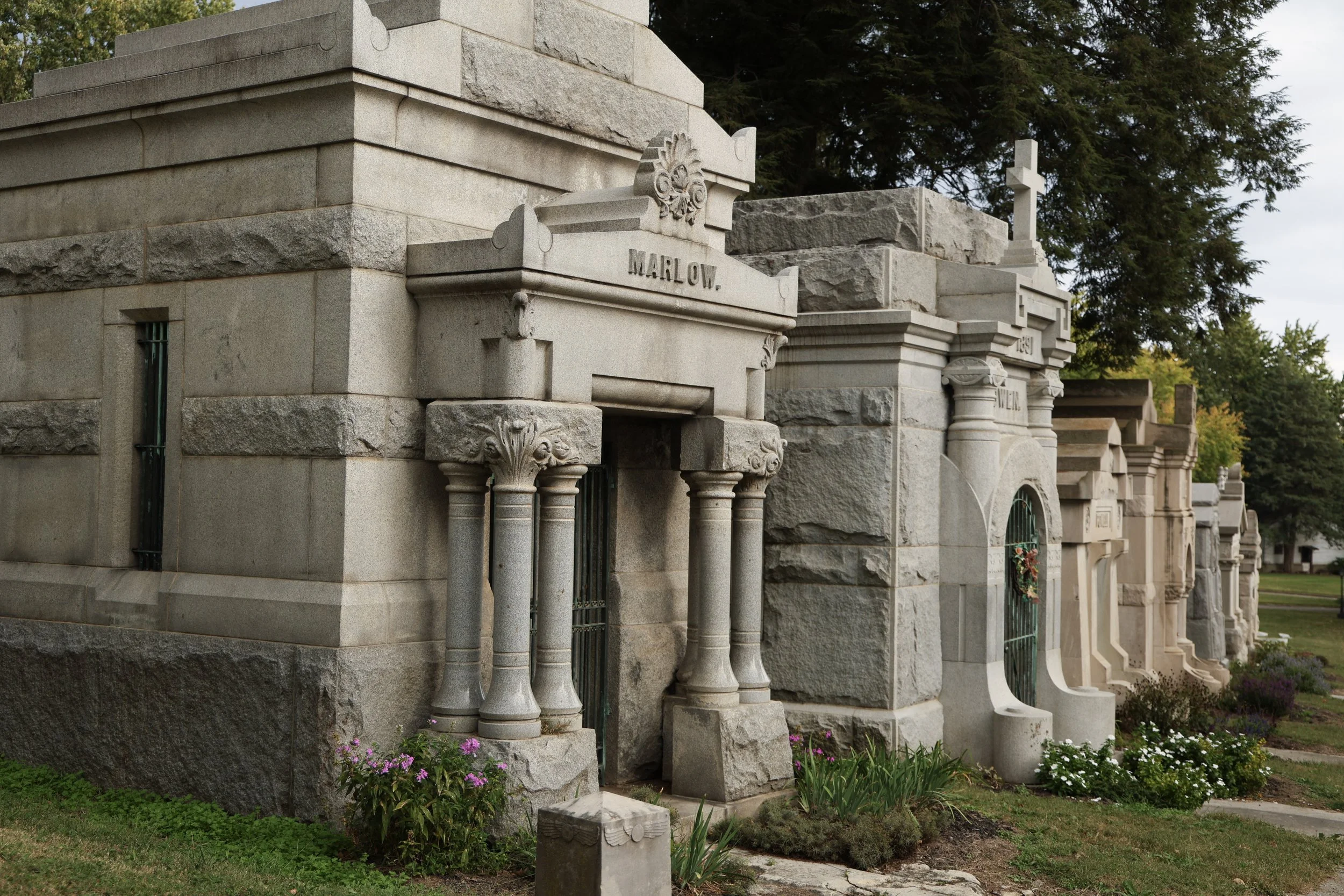
MOUNT MORA CEMETERY
SAINT JOSEPH, MISSOURI
-
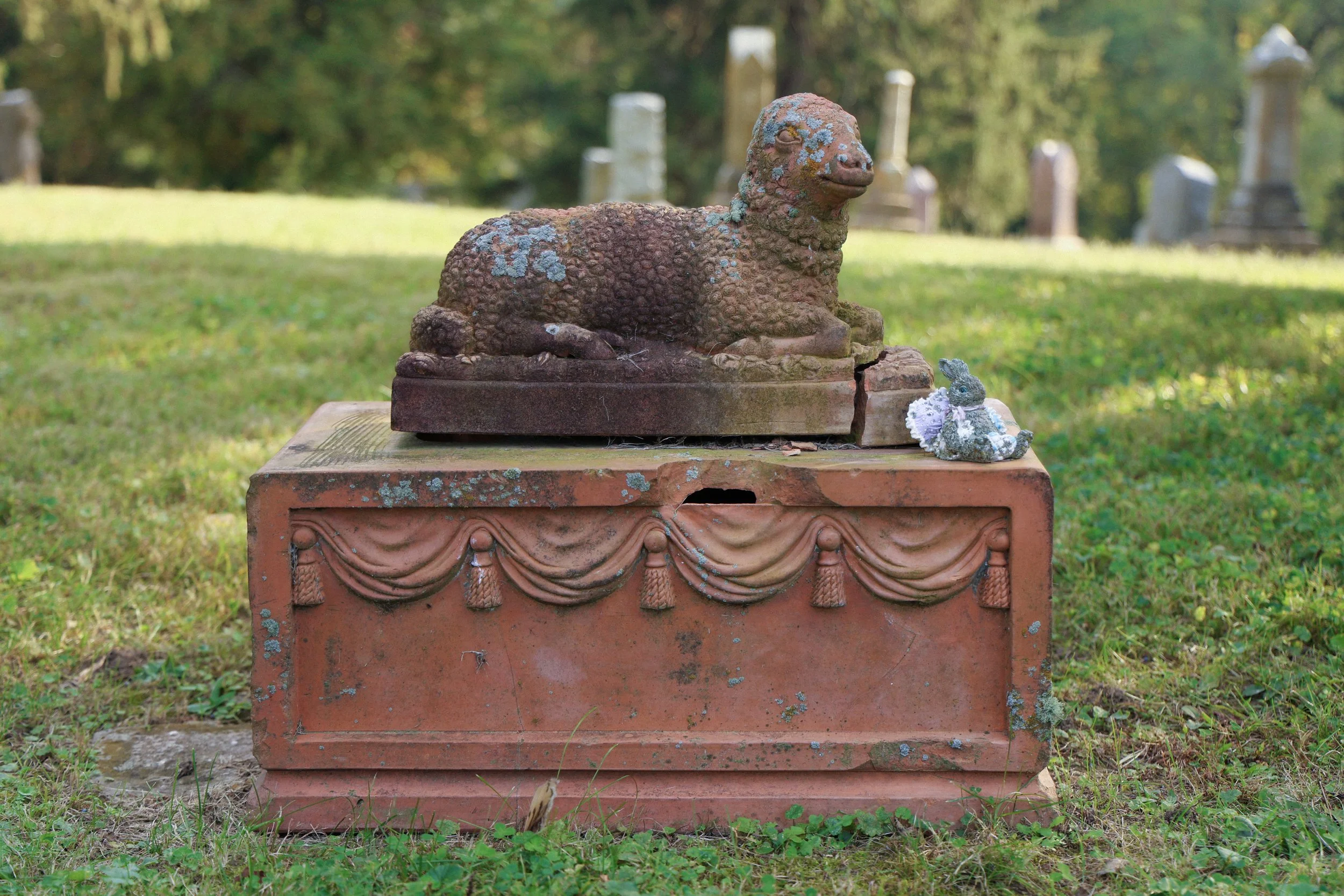
ASHLAND CEMETERY
SAINT JOSEPH, MISSOURI
-

MOUNT OLIVET CEMETERY
SAINT JOSEPH, MISSOURI
-

MOUNT VERNON CEMETERY
ATCHISON, KANSAS
-

BOOTHILL GRAVEYARD
TOMBSTONE, ARIZONA
MOUNT MORA CEMETERY
SAINT JOSEPH, MISSOURI
Established in 1851, this is the oldest operating cemetery in St. Joseph. With it’s fabled “Mausoleum Row” and 21 mausoleums on the premises total, this was the premier place to be interred if you were of significant wealth, influence or of notable pedigree.
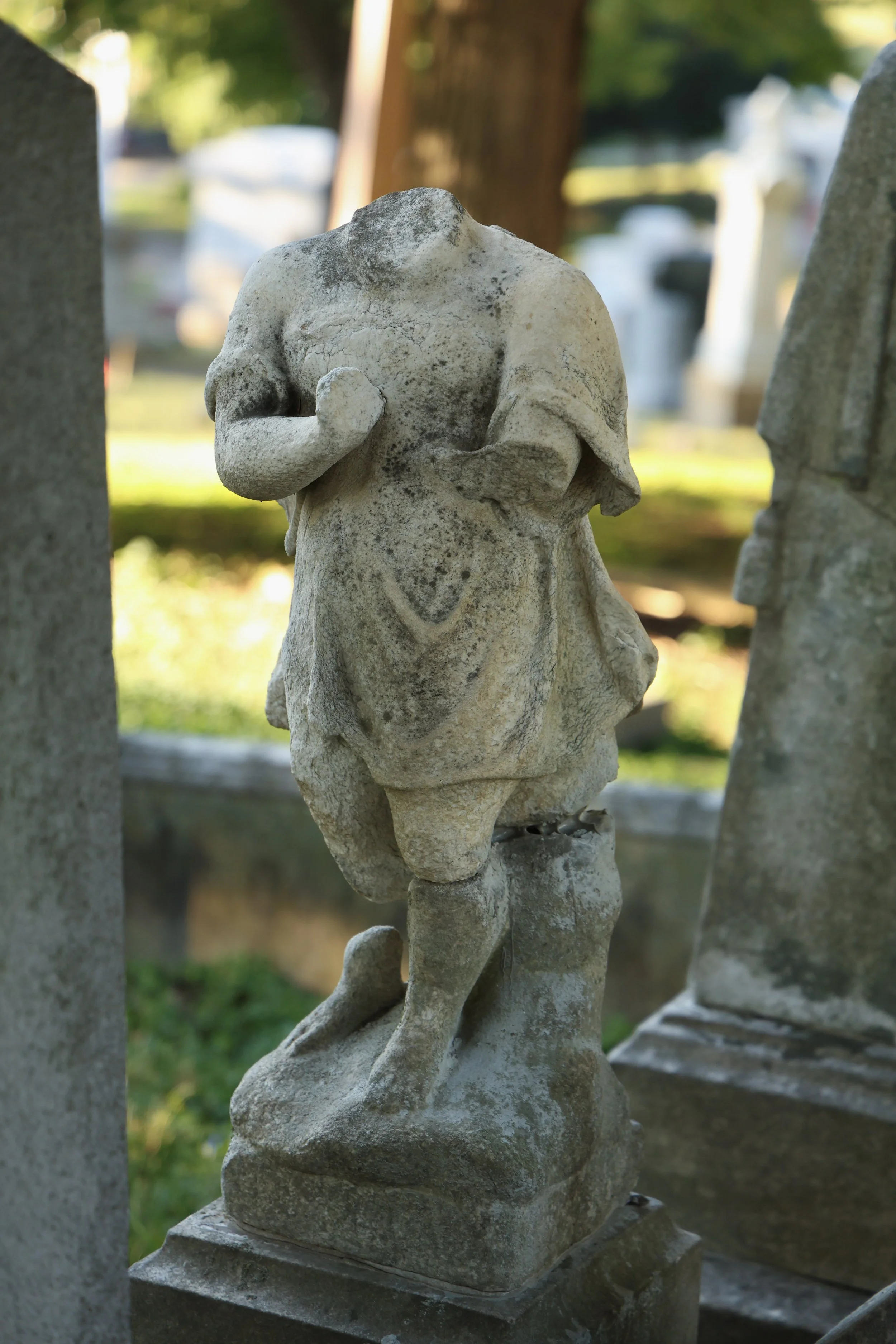
The headstone of Edna Schuster. Her father, Adam N. Schuster, was a wealthy German merchant and banker. Edna was his youngest daughter and child. She was the first to be buried on the family plot and remained there all alone for nearly 30 years until her father's passing; he is buried to her immediate right. The former Schuster residence, a 5-bedroom Italianete-style mansion built between 1878 and 1881, still stands to this day at 703 Hall Street.

Sun shines through red stained glass, illuminating a rose placed on the Catlett crypts.
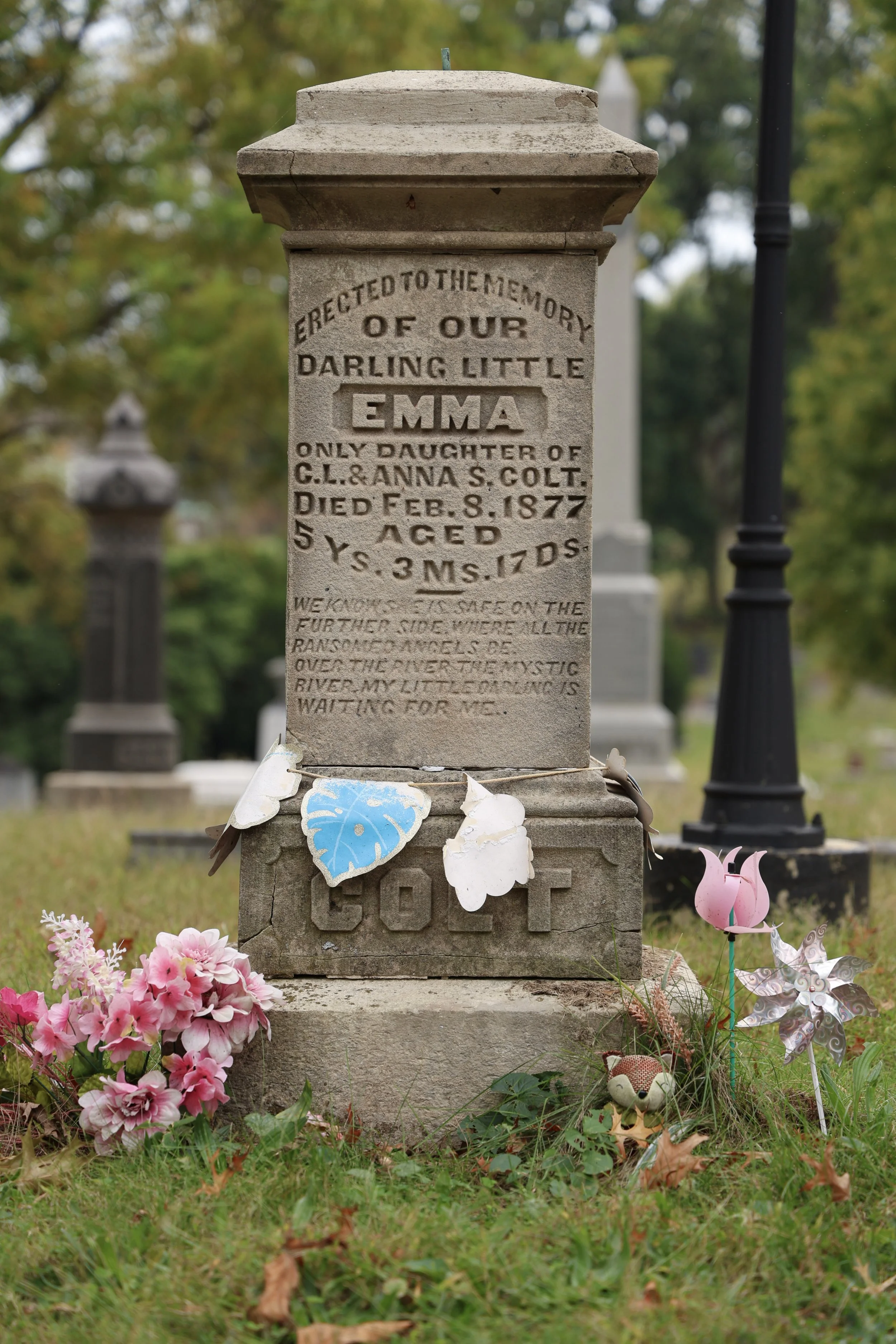
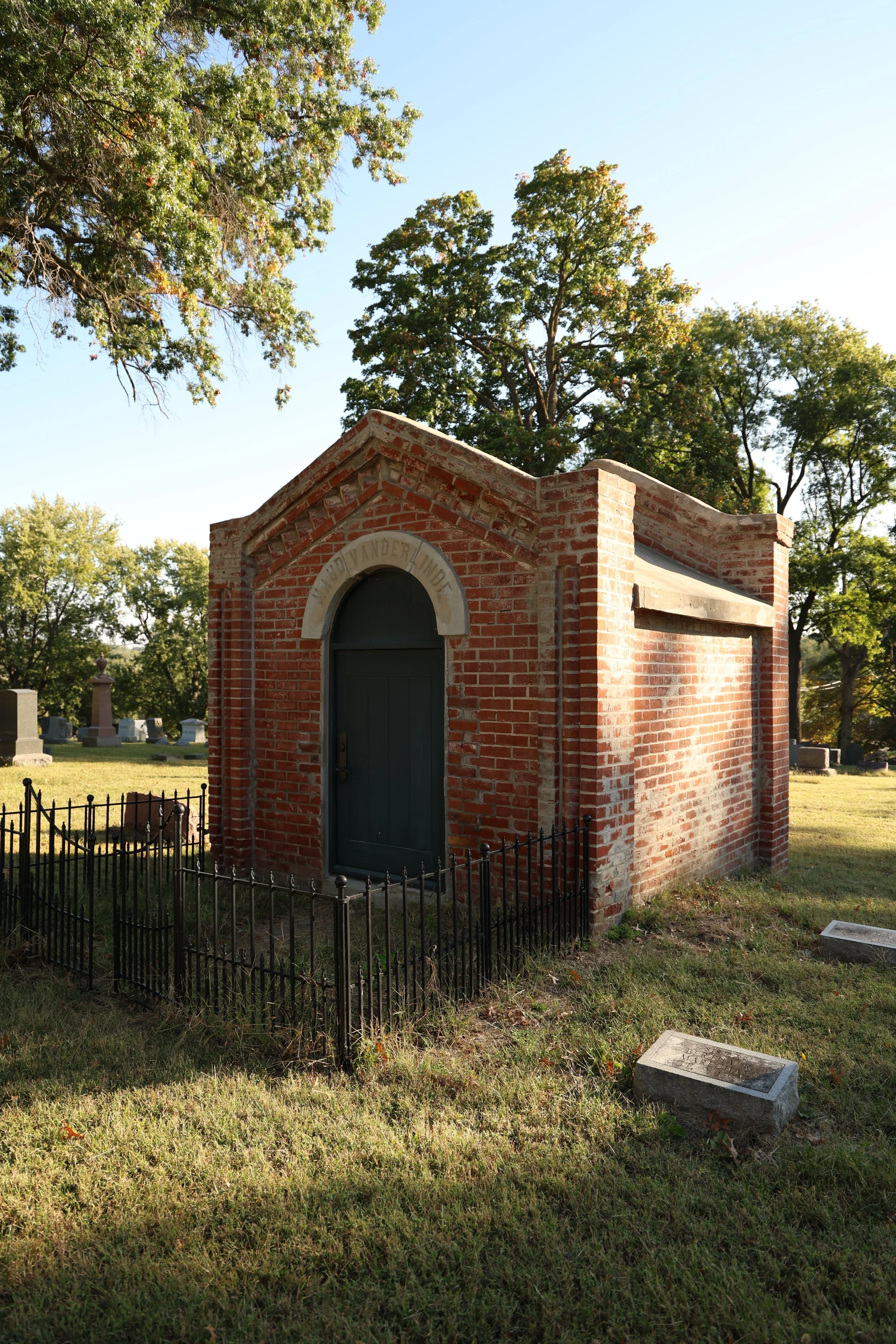
Probably the most infamous mausoleum within the gates of Mount Mora. Not only does its appearance seem jarring compared to the neighboring mausoleums, but its legend is just as peculiar. As the story goes, Maude Vanderline was approximately 22 or 23 years old when she and her husband passed through St. Joseph while heading out west. It is said Maude died during childbirth. Her husband, distraught with grief, contacted a nearby Native American medicine man to put a spell on the body of his wife. Maude is said to have been placed in a coffin laying on two sawhorses, her body exposed to the elements. Over a century later, with the mausoleum crumbling with age, those who dared to peek in have seen the body of Maude seemingly asleep as if she'd died merely minutes before, incorruptible. In recent years, the former entrance to the mausoleum has been bricked shut with a lot of restoration work done on the exterior.

Detailed floral carvings on the headstone of Austin A. Tootle. His date of birth is unknown, so he might've been a stillborn or died as a baby.
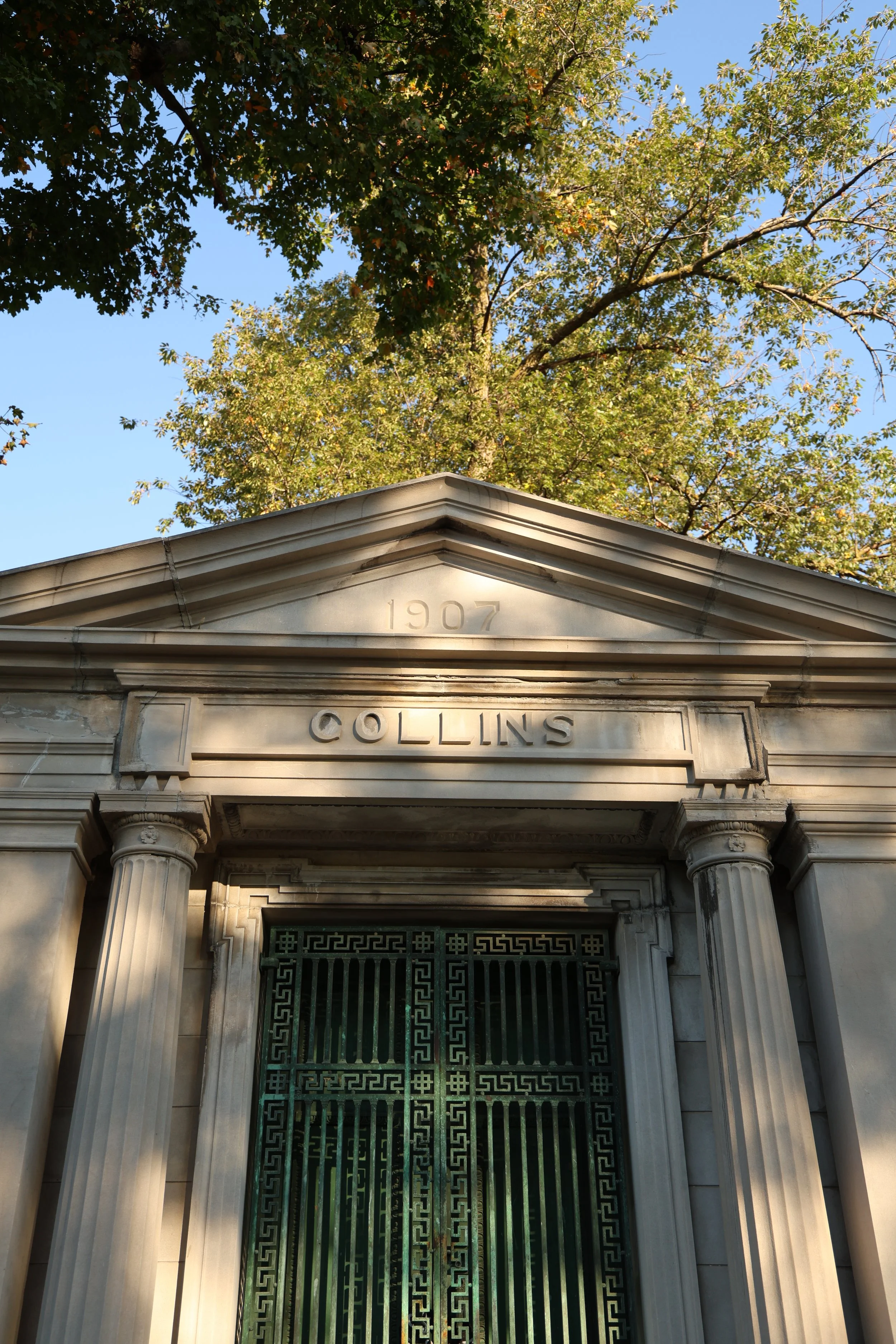
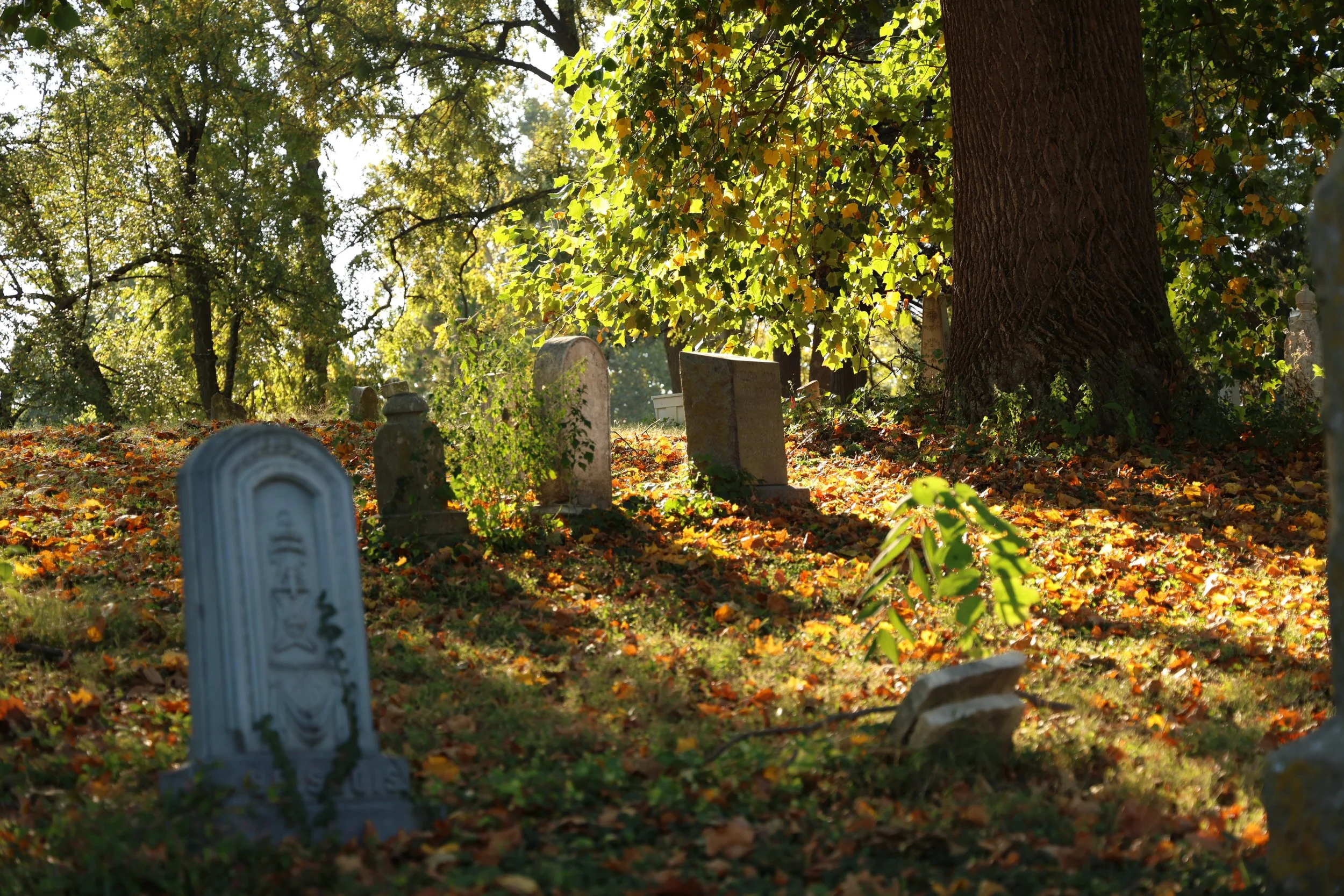

The Townsend mausoleum is by far the largest in Mount Mora. It is the centered mausoleum looking south down Mausoleum Row. There are lots of Egyptian aesthetics with this mausoleum— from pillars, to cobras and even two Sphynx cat statues guarding the entrance. Robert Edward Townsend is buried here with his wife, Mary Francis; she died over a decade before he did.
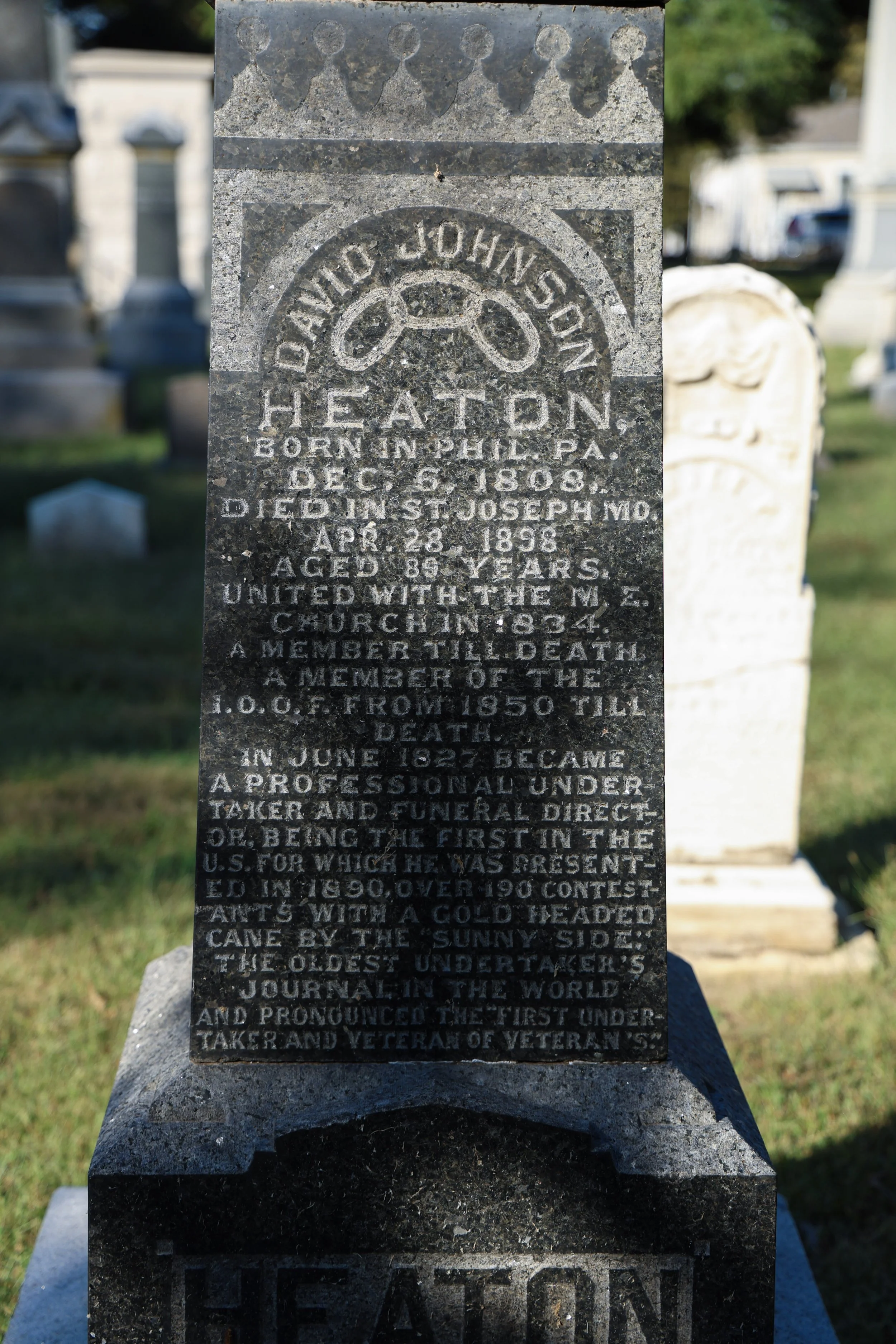
David Johnson Heaton became the first ever professional undertaker and embalmer in the United States. It's thanks to his work that embalming would become a standard funerary practice in America following the Civil War. He first began his career at 13 in undertaking in Ohio where he made coffins. The busiest moment of his career was in 1851 when news of gold out west swept across the country; some 14,000 pioneers were traveling through St. Joseph when a cholera outbreak occurred. Heaton lived to be 89. His funeral home business, Heaton-Bowman-Smith, is still in operation to this day.

A door handle to the Fairleigh mausoleum. Note the Egyptian influence.


Stained glass to the Crowther mausoleum.
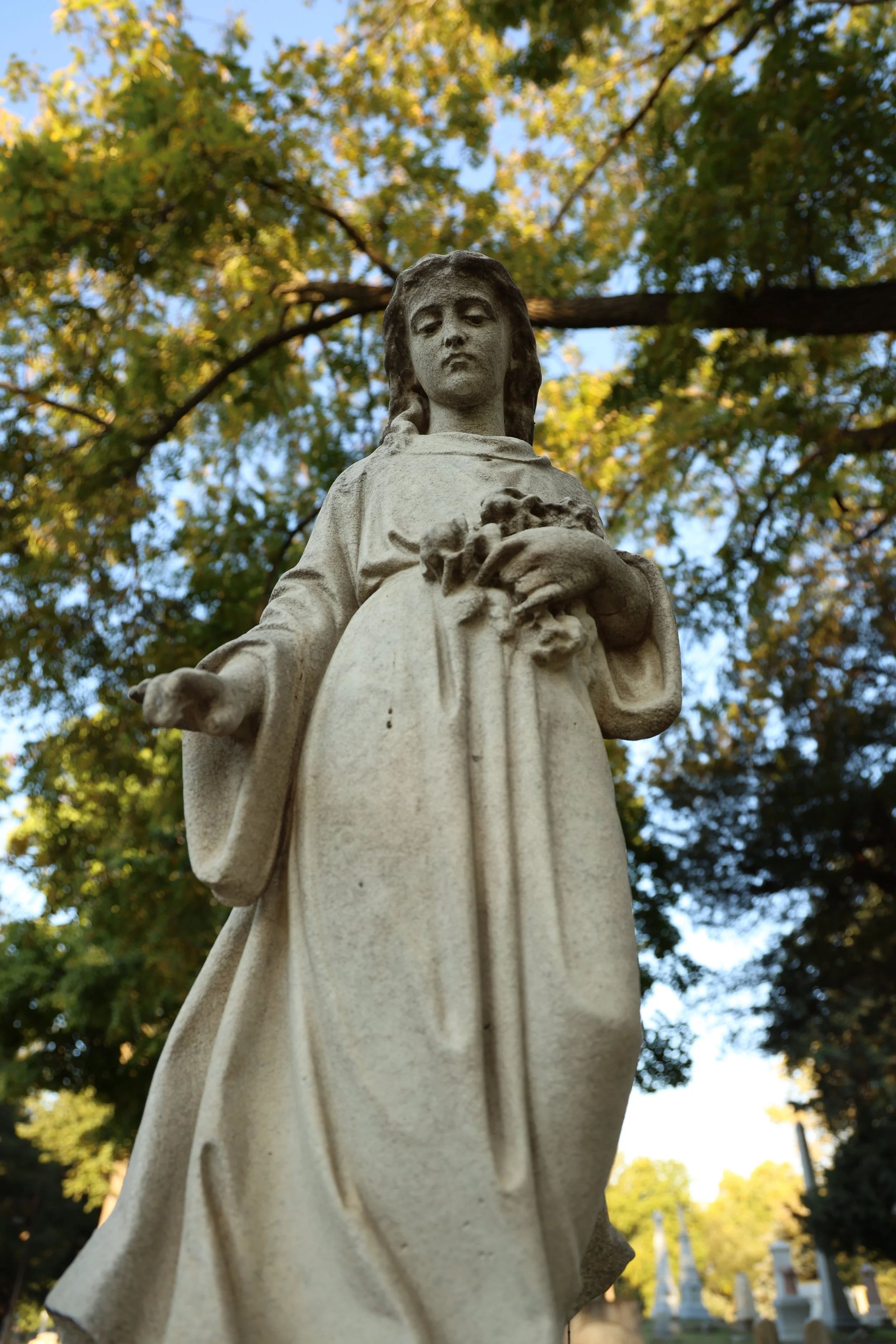
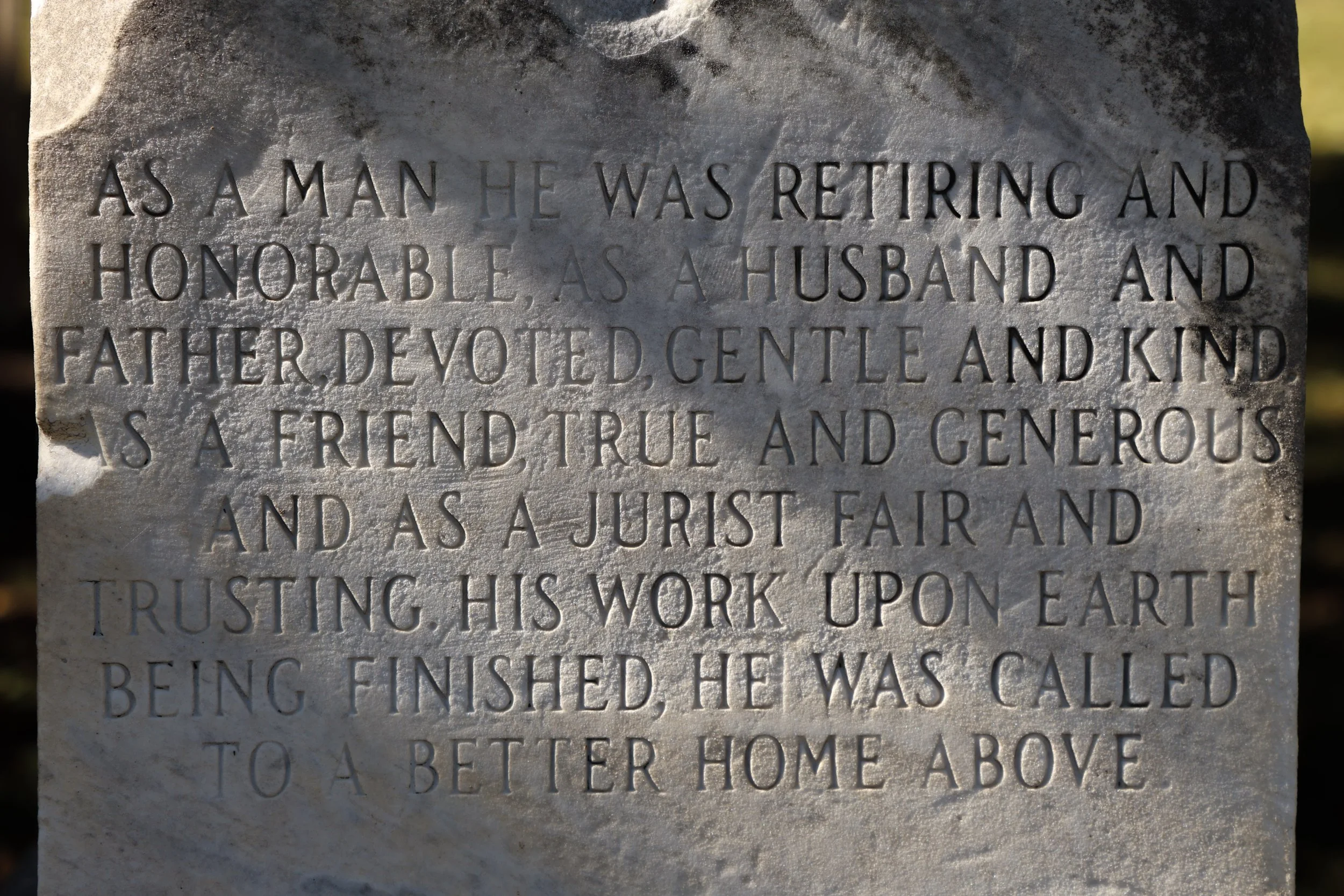
Joseph White Tootle's inscription reads, "As a man he was retiring and honorable. As a husband and father devoted, gentle and kind. As a friend true and generous and as a jurist fair and trusting. His work upon earth being finished, he was called to a better home above." He was only 31.

The mausoleum of George and Arcadia Marlow. After the Civil War, George moved to St. Joseph and opened a shoe business. On November 16, 1893, an employee found him dead on the floor with a self-inflicted gunshot wound. A letter to his wife said he had been “racked with pain, was unfit for business, and did not desire any longer.” They never had any children and Arcadia never remarried.

You can see here how close some homes sit to the cemetery.
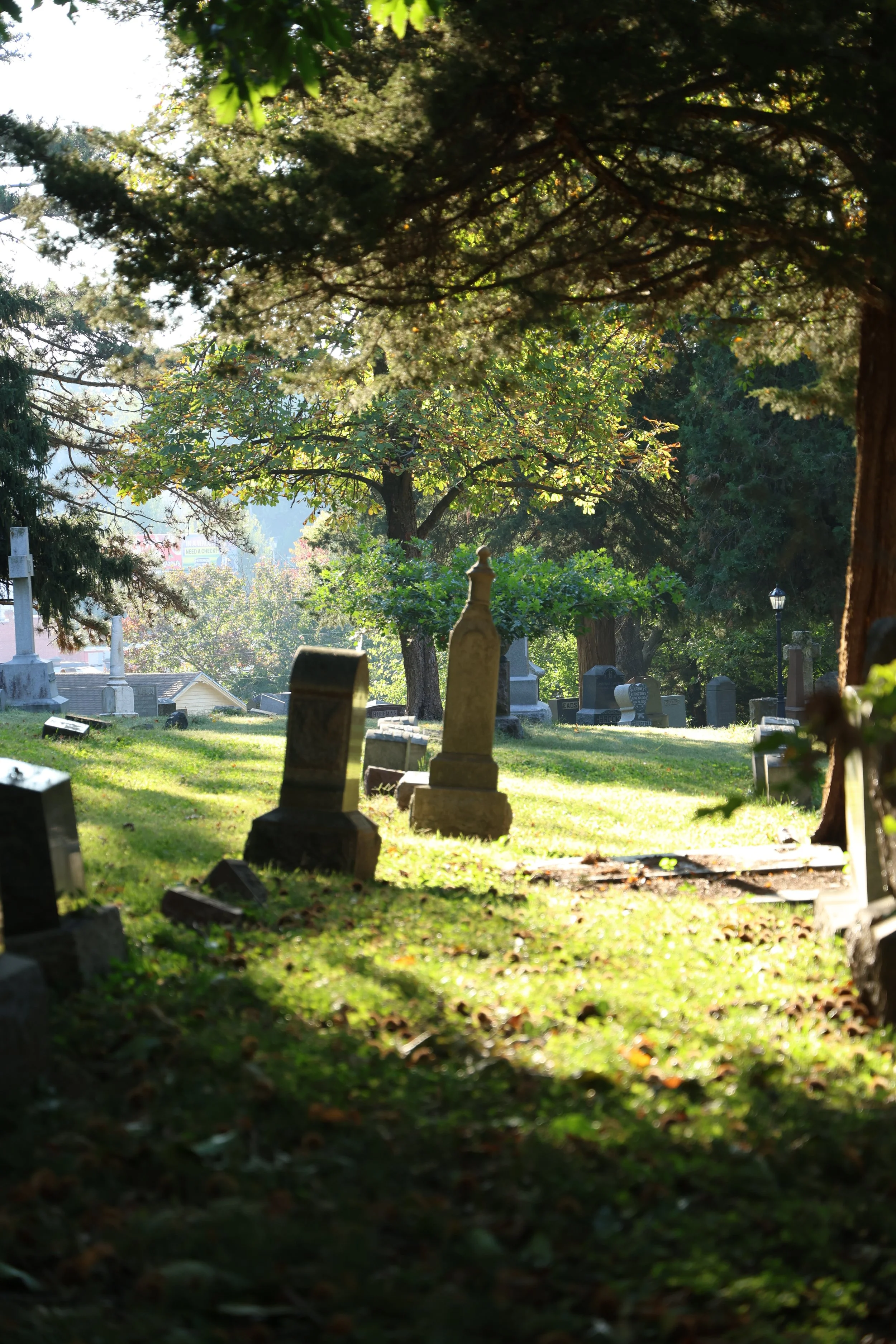
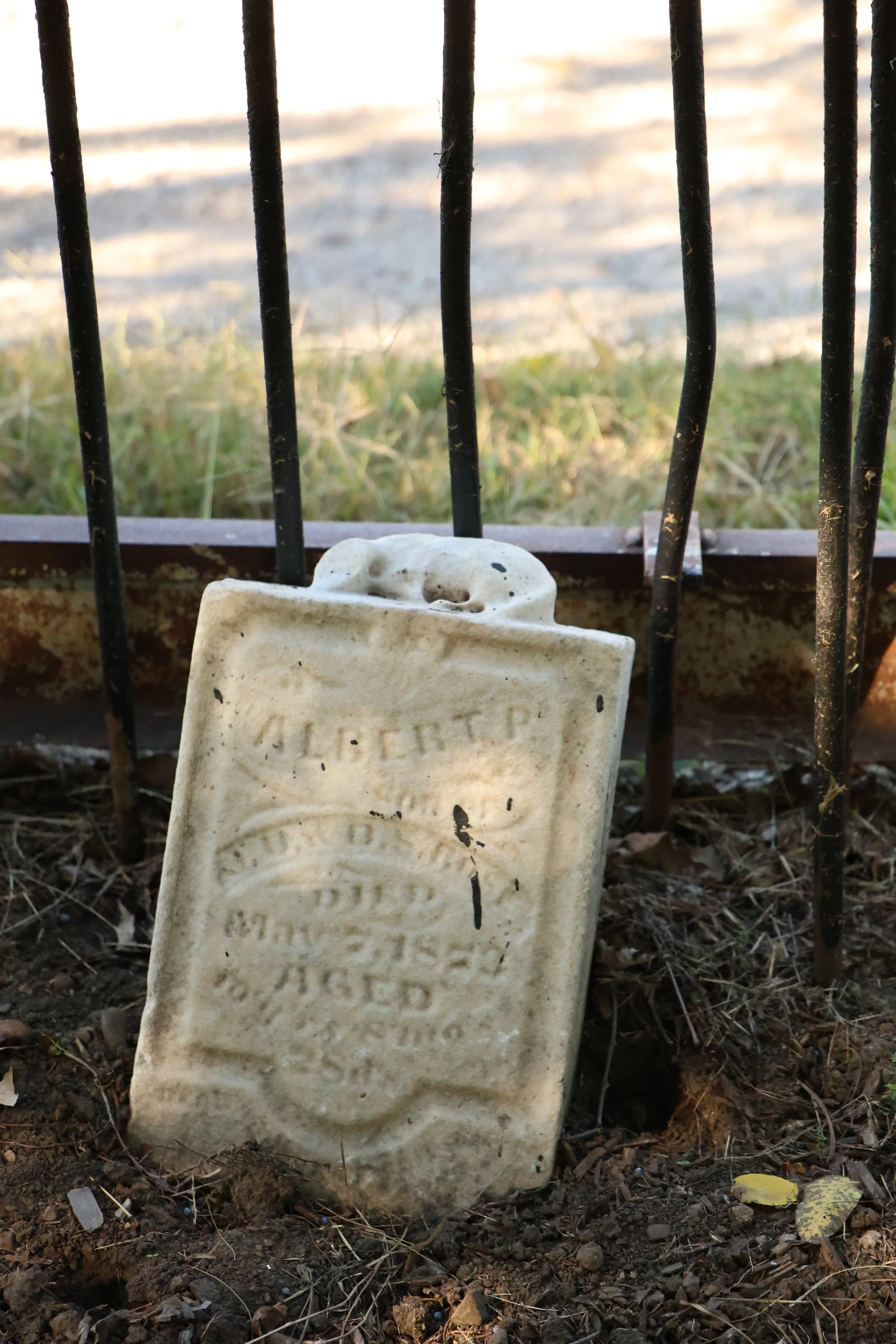
What appears to be evidence of an attempted headstone robbery belonging to 10-year-old Albert P. Rose.

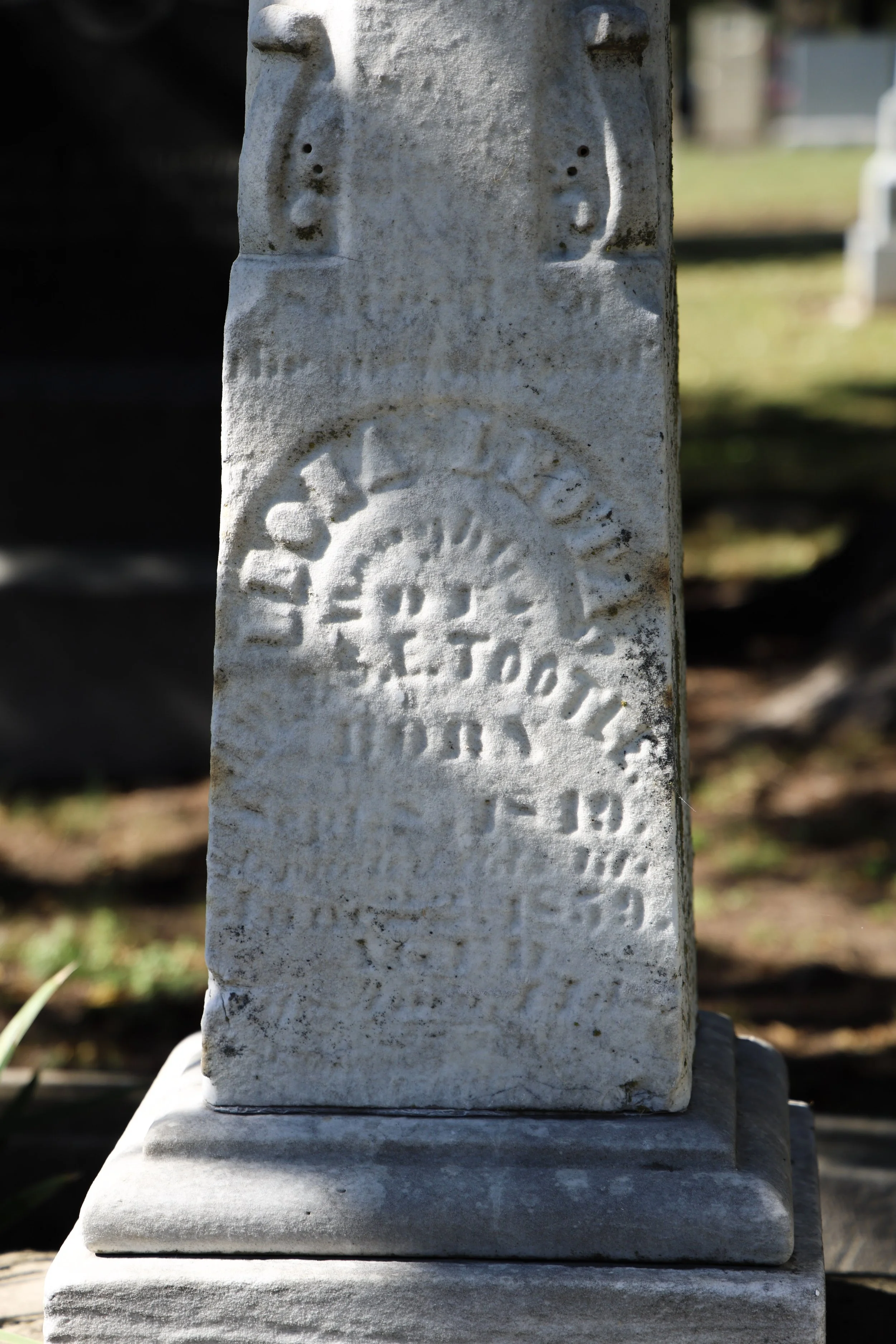
Leona Leota Tootle was either nine or ten years old when she died.
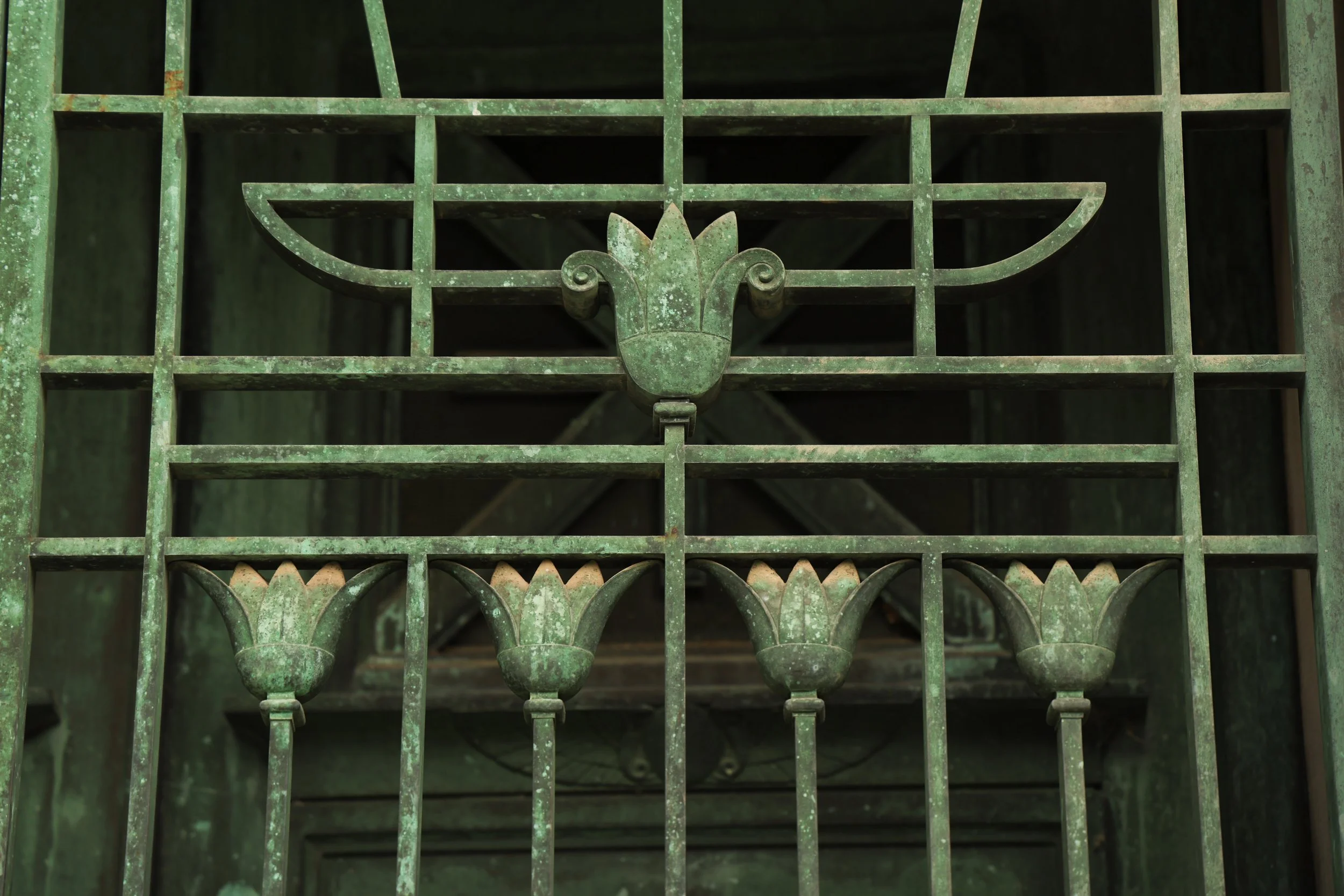
Egyptian-influenced details on the McCord mausoleum gates.
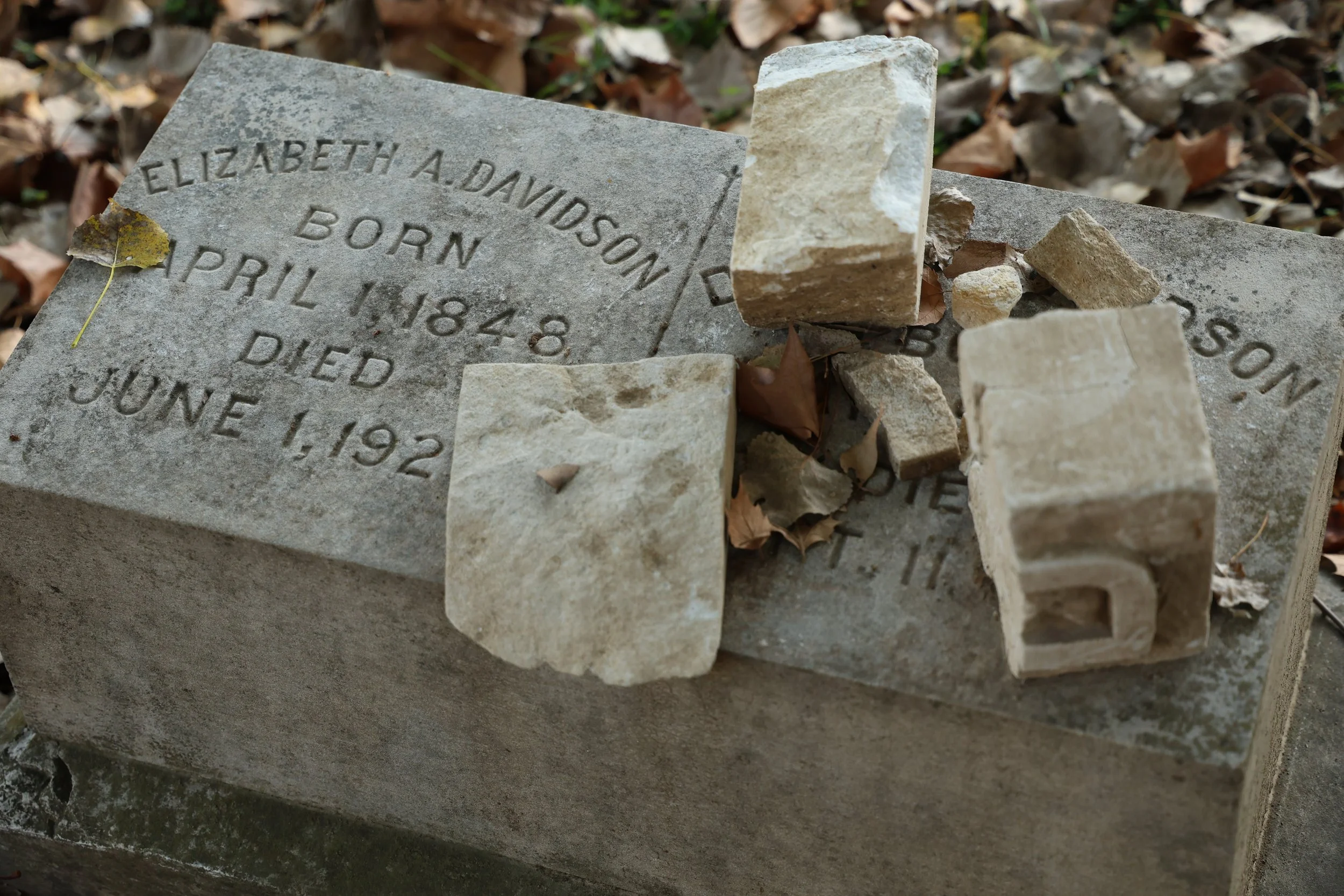
A broken lot marker sits on a headstone.

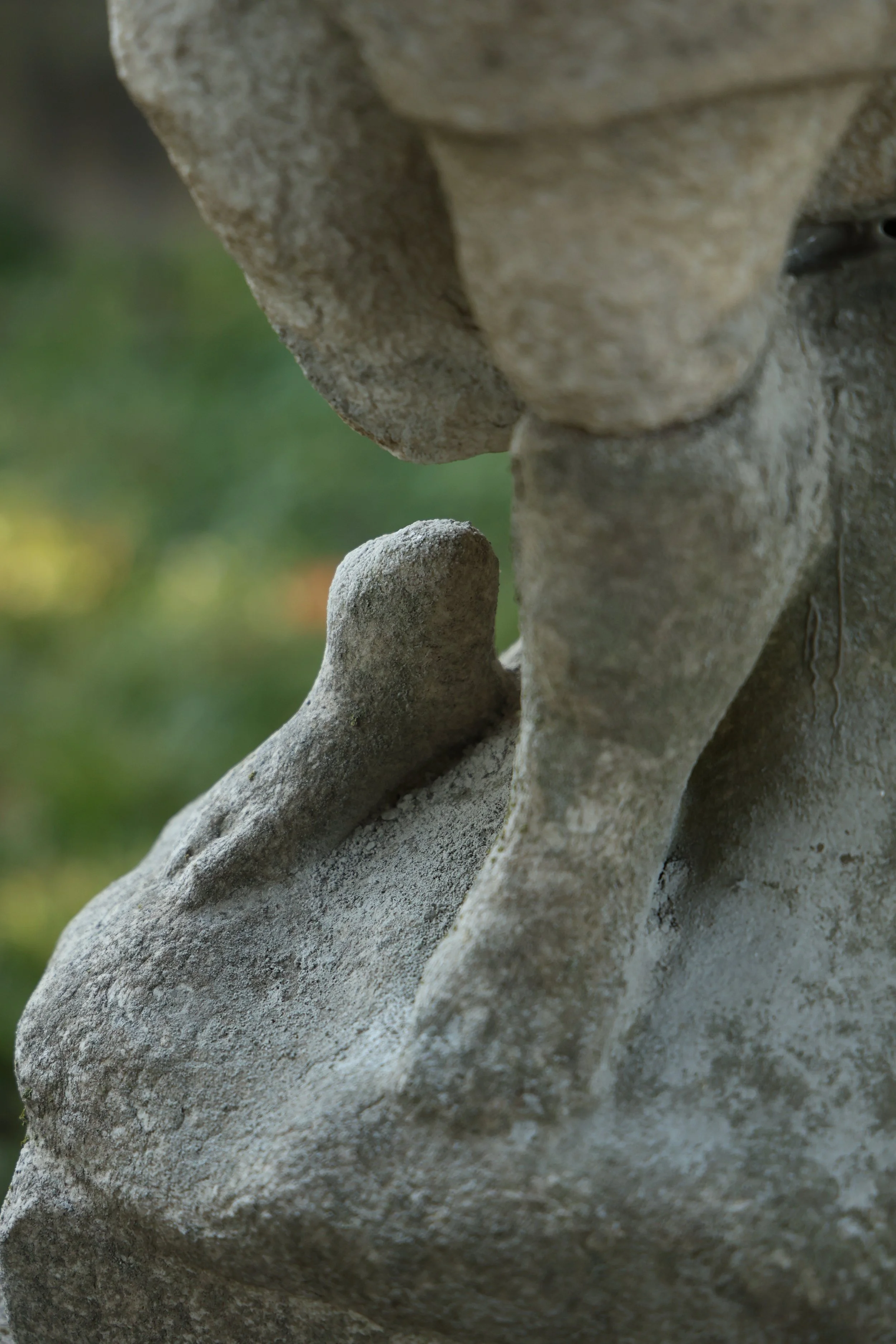
The eroded headstone of 7-year-old Edna Schuster.

Rainbow appears from behind the Smith mausoleum following a brief thunderstorm.
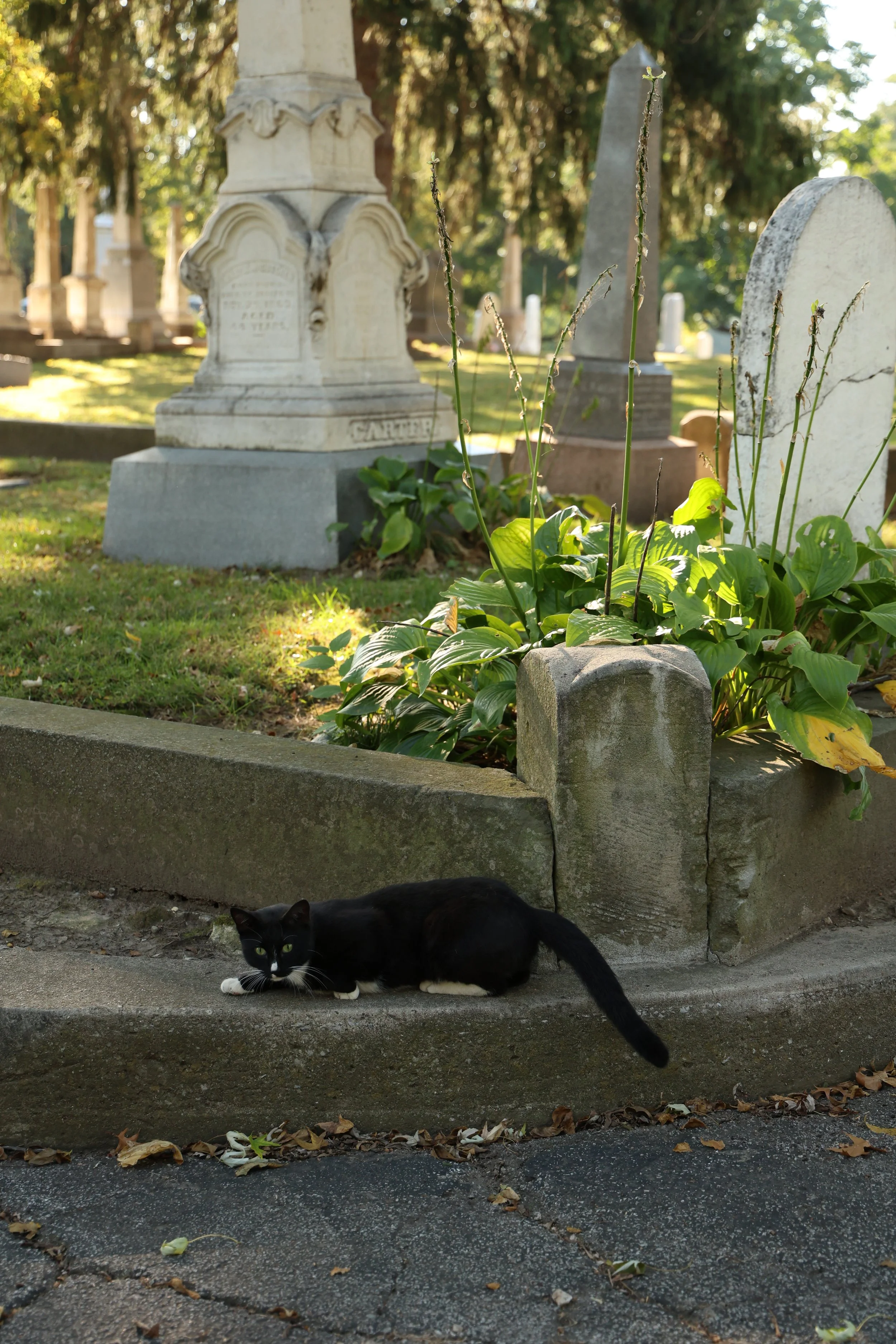
Graveyard kitty who nearly scared me to death while emerging from behind a headstone.

Glow from across the Marlow mausoleum. Note the intricate floral carvings into the glass.
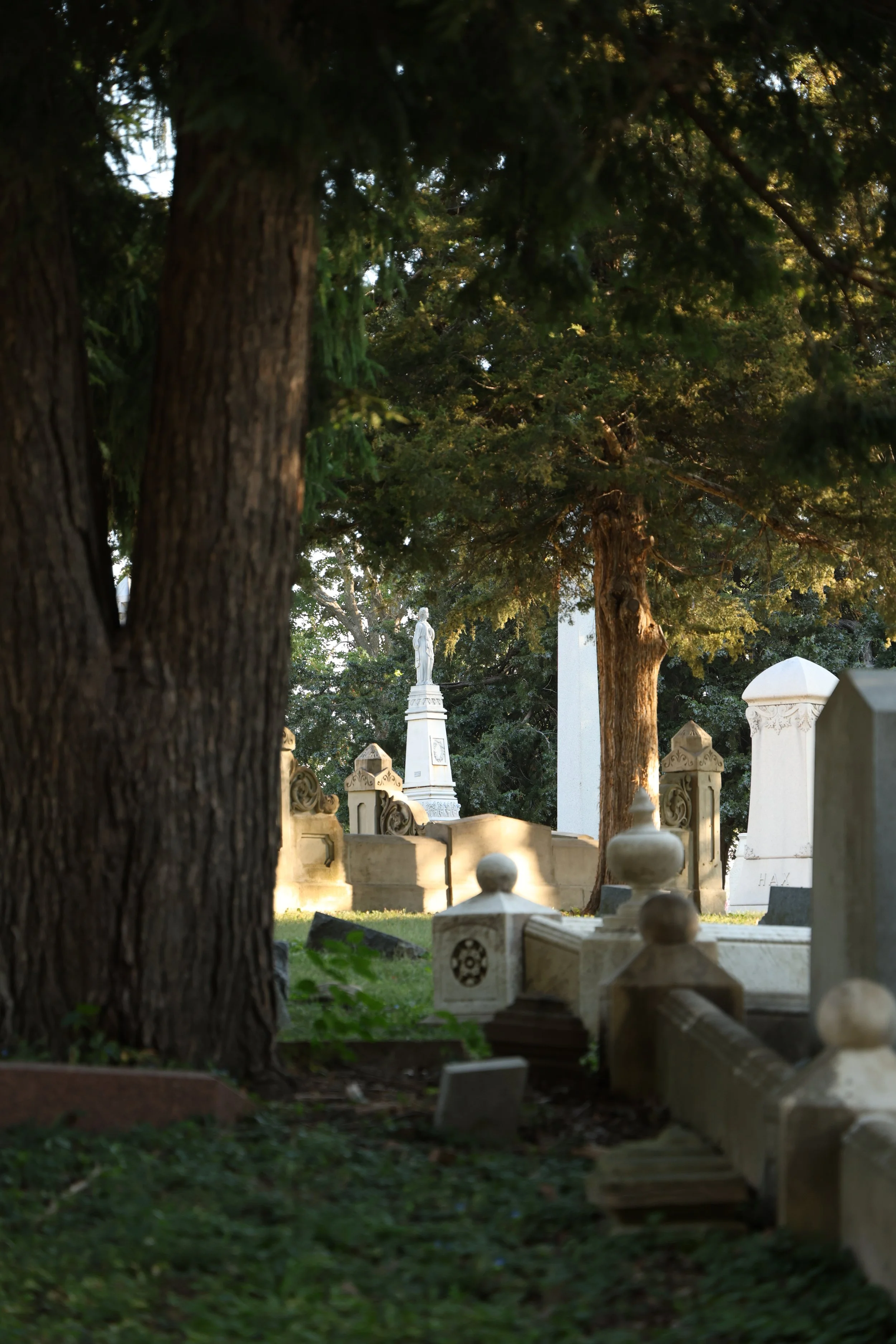

The McCord mausoleum. The stone pillars, large wings guarding the entrance and iron flowers on the gates are a nod to Egyptian influence.

Headstones of two infants.

Of their six children, the daughters of James and Agnes Owen were considered thoroughly educated for being women. Mary would conduct "ethnological studies on folklore, the Mesquawkie Natives, and African-American Voodoo." Juliette delved in ornithology, the study of birds. However, Luella, "... first became fascinated with shells and fossils turned up as the road was graded in front of her first home on Sixth Street." She would dedicate the rest of her life to geology— traveling across the country exploring, mapping and writing about caves. It's noted that, "After her father died in 1890, Luella felt free to go on field trips with spelunkers, or men who explored caves and caverns as a hobby. She would wear a long, split skirt that skimmed the tops of her boots." Most importantly, "She is believed to have explored more caves than any other woman, and more than most men of her time." Before her death, she burned most of her life's work. Luella, all her sisters and her parents are interred in this mausoleum. Her two brothers are buried elsewhere— 2-year-old James is interred in another location in Mount Mora and Herbert at another cemetery entirely.

Headstones of Willie and Lillie Robison. Willie was 6 years old at the time of his death with his sister, Lillie, only being 4. They both died less than a month apart in the spring of 1870. Per a family member, the children both died of scarlet fever.
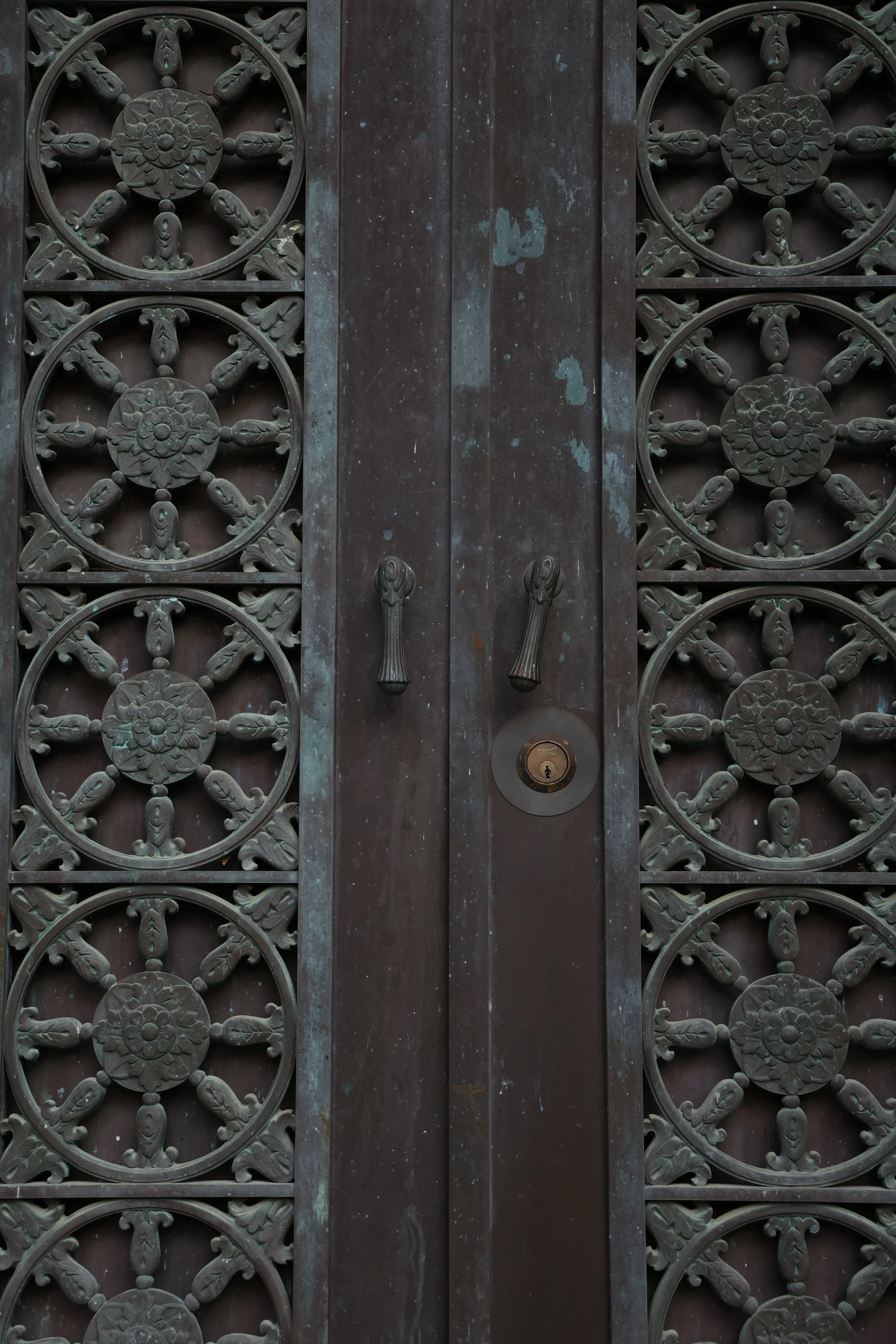
Doors to the William H. Barlett mausoleum.
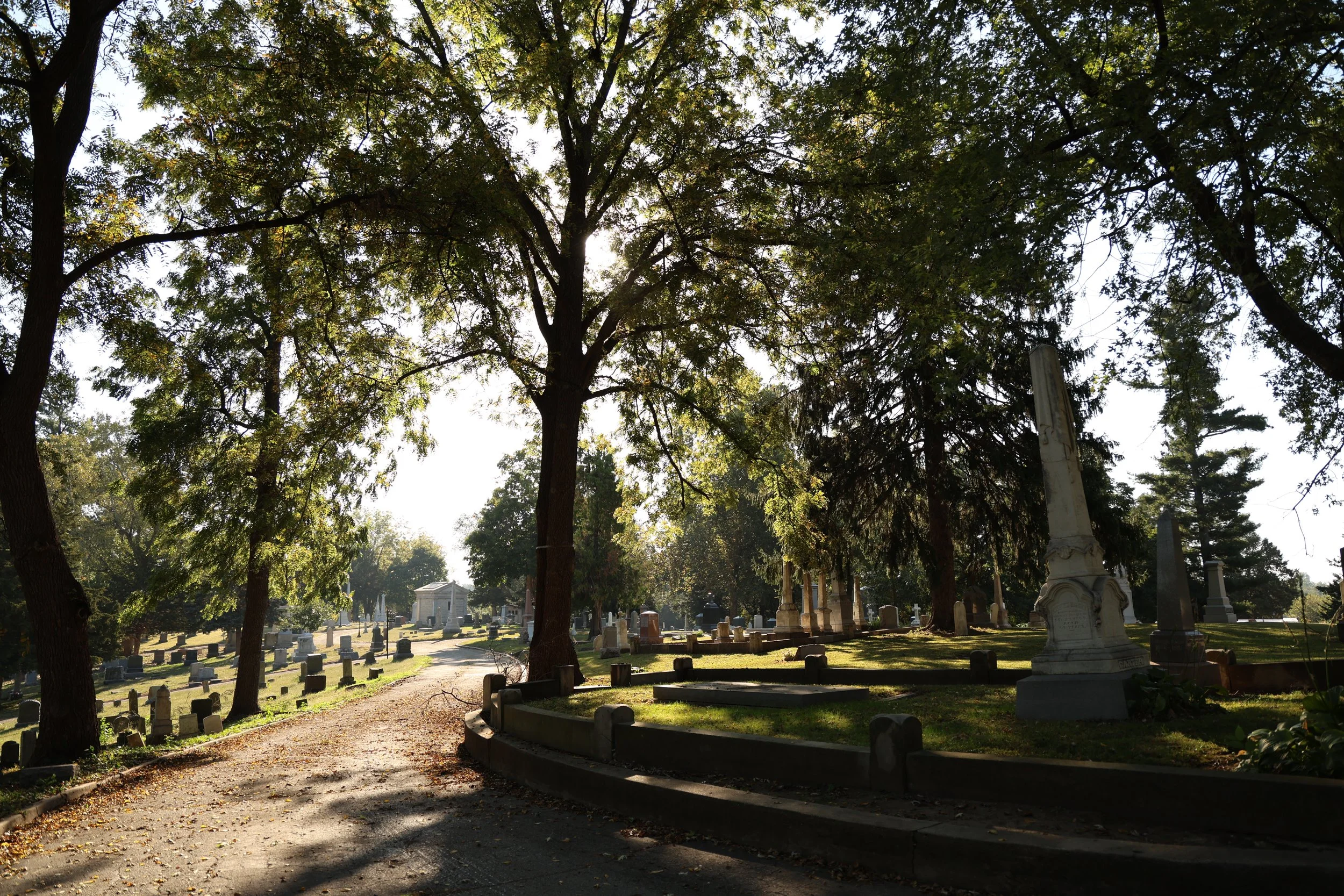
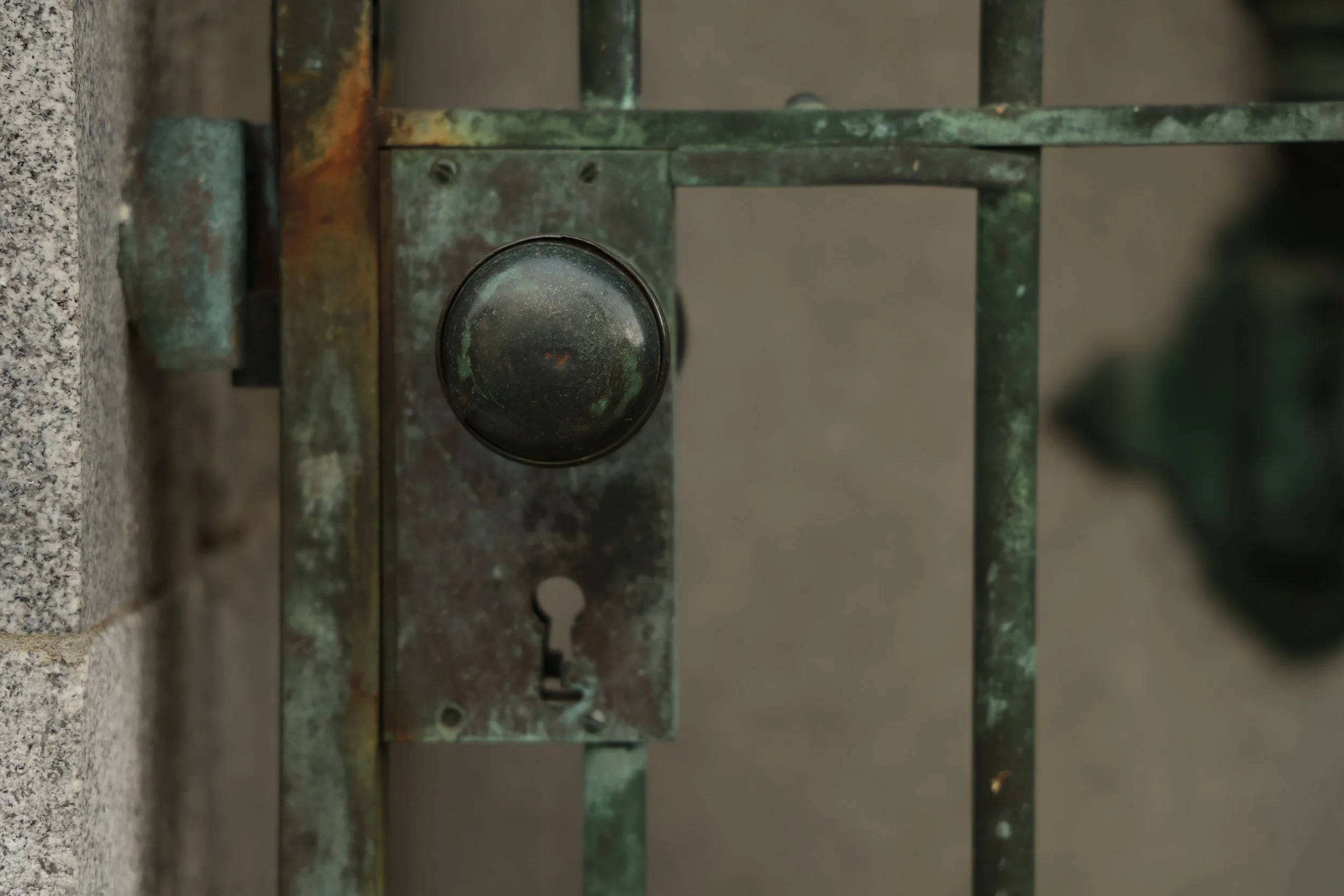
Handle and lock to the Owen mausoleum.
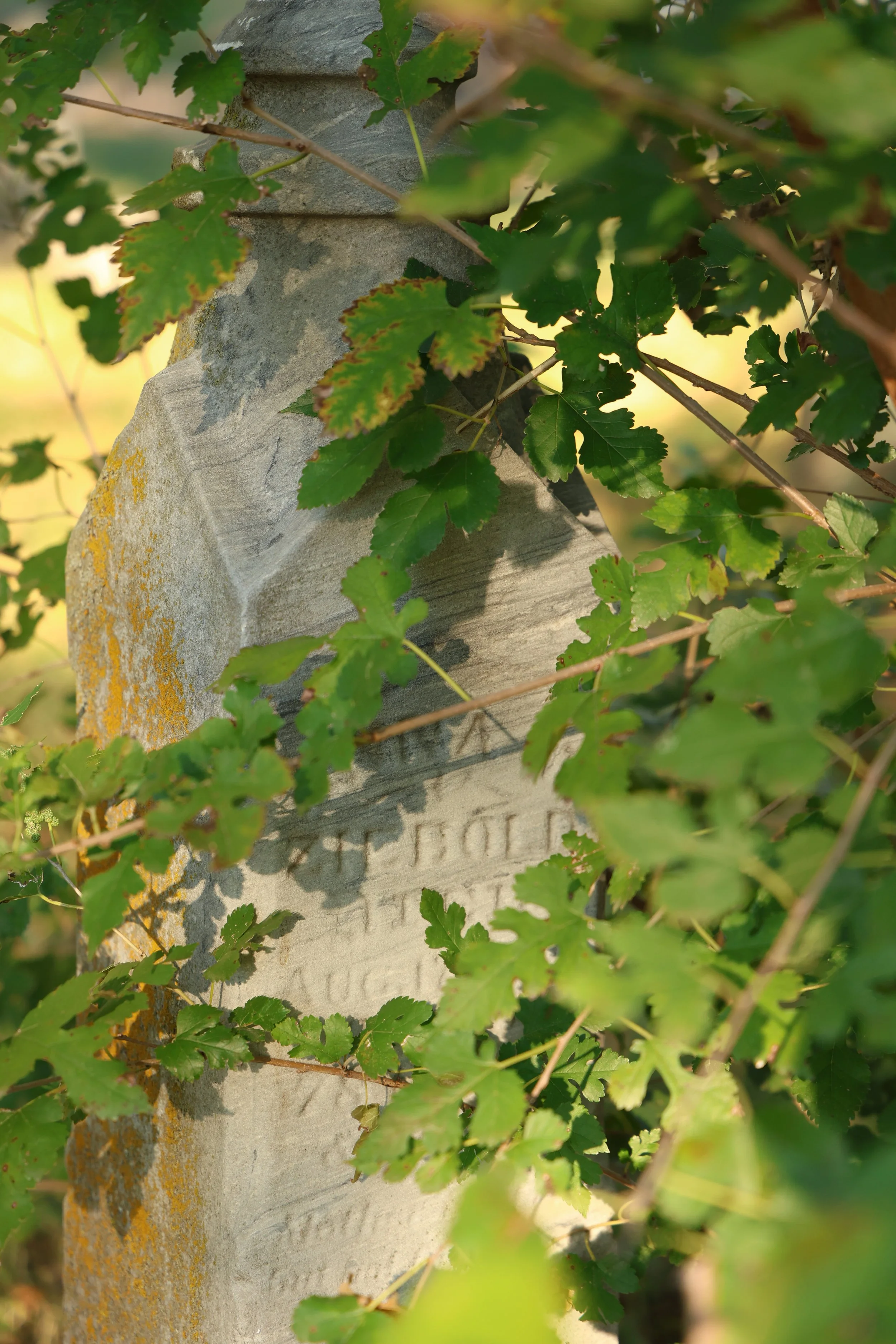
Some graves are engulfed with poison ivy and weeds.

One of the two Sphynx cats guarding the Townsend mausoleum.
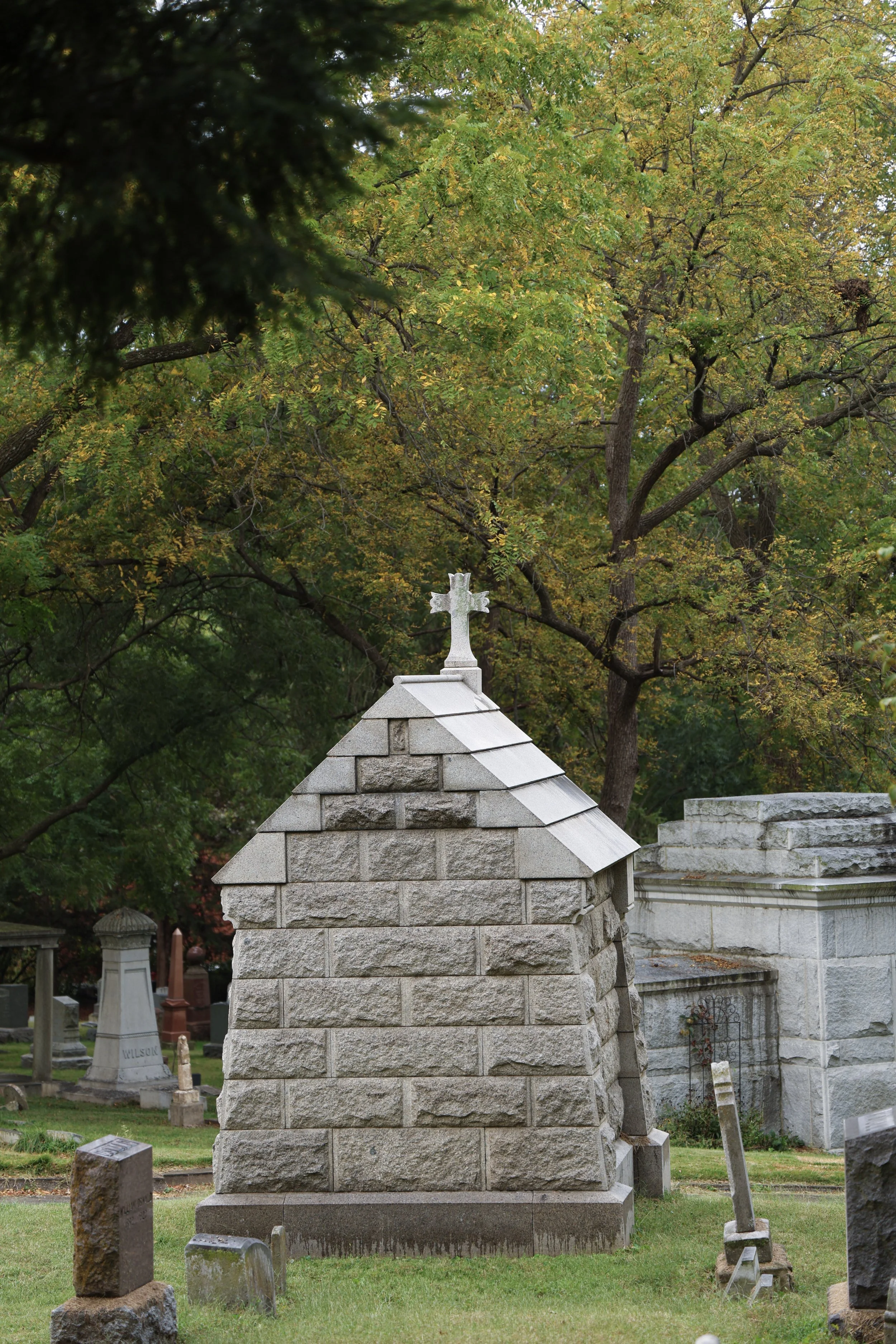

Looking into the Richardson mausoleum. There is not door or glass behind the gate.
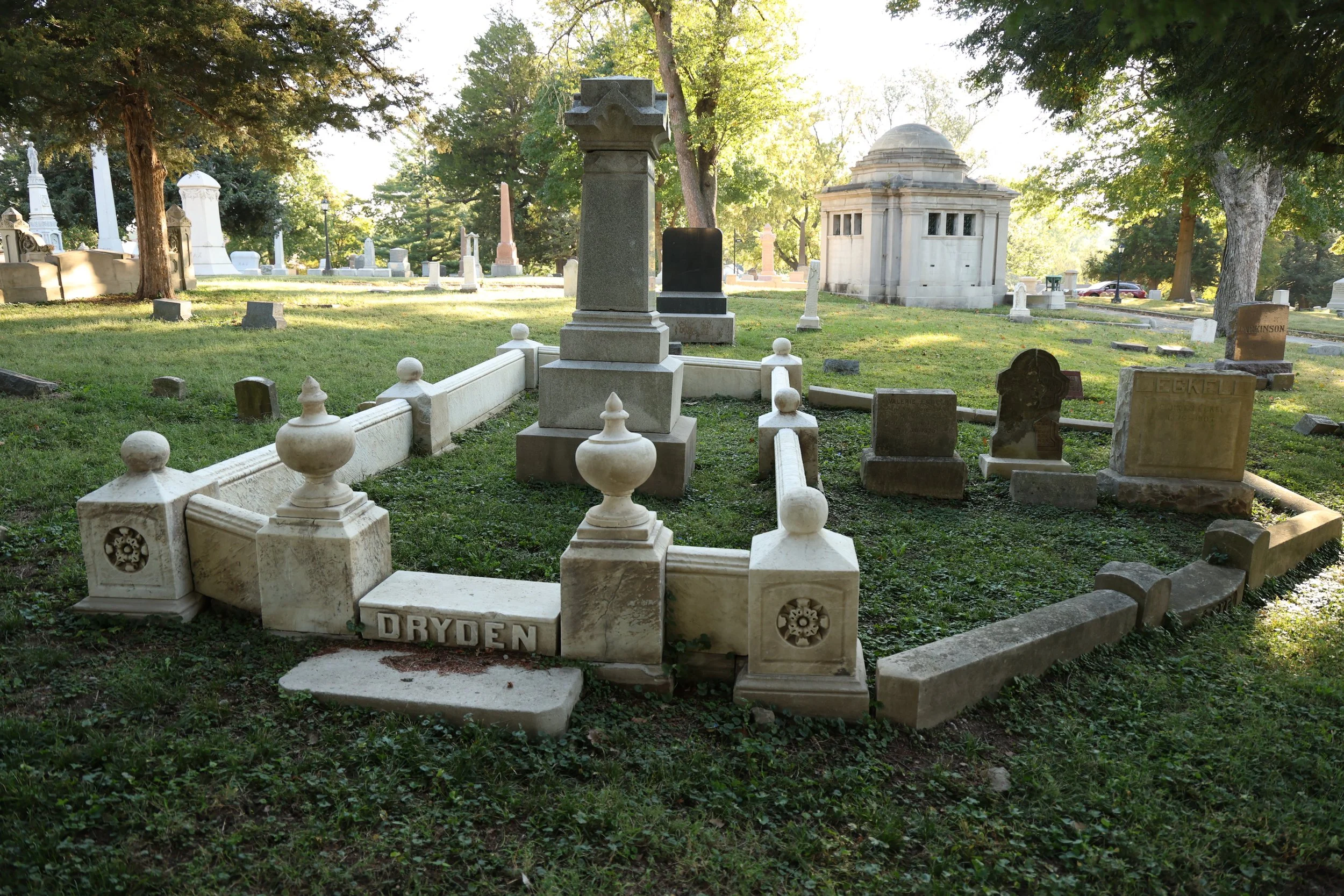

Glow from across the Owen mausoleum.
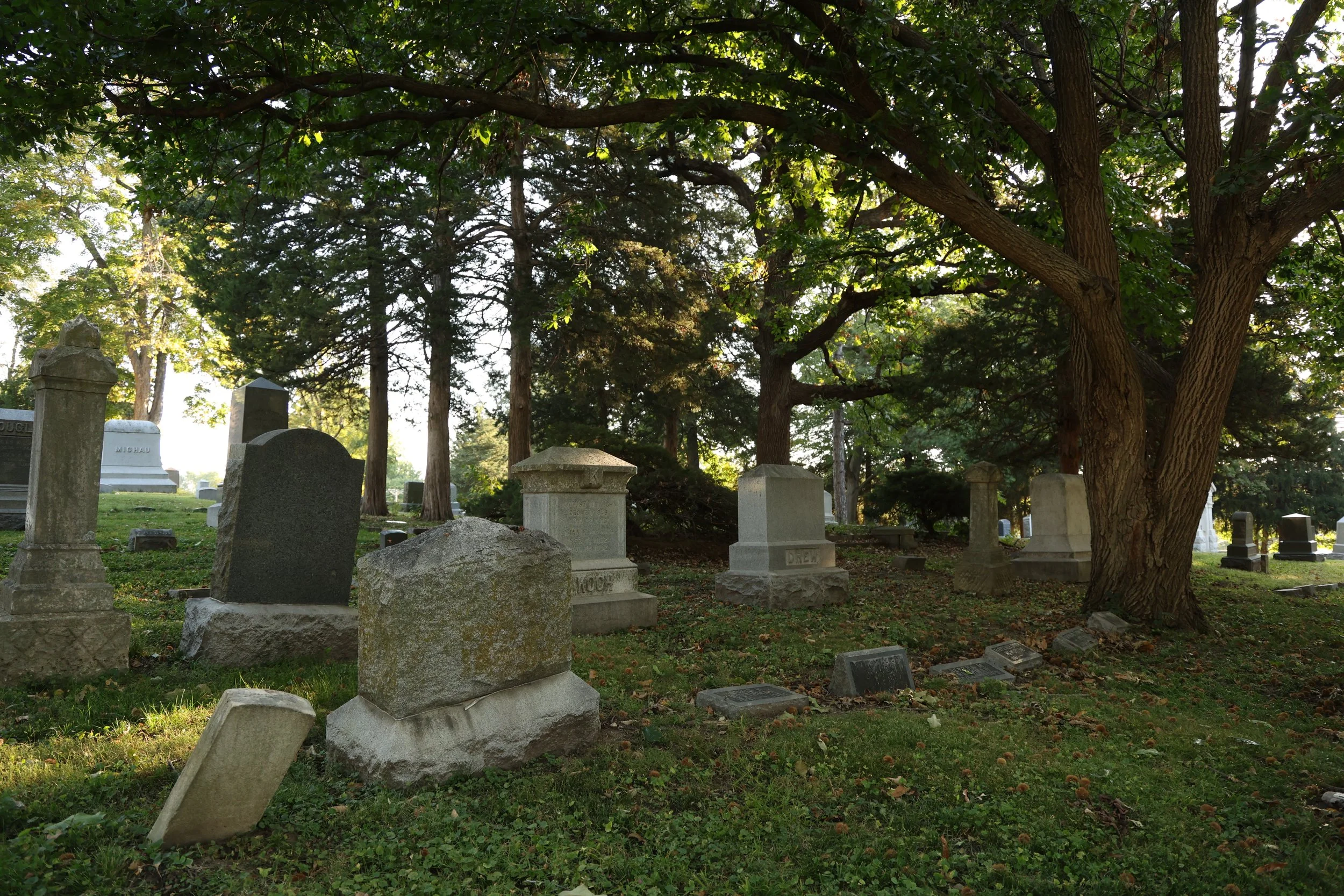
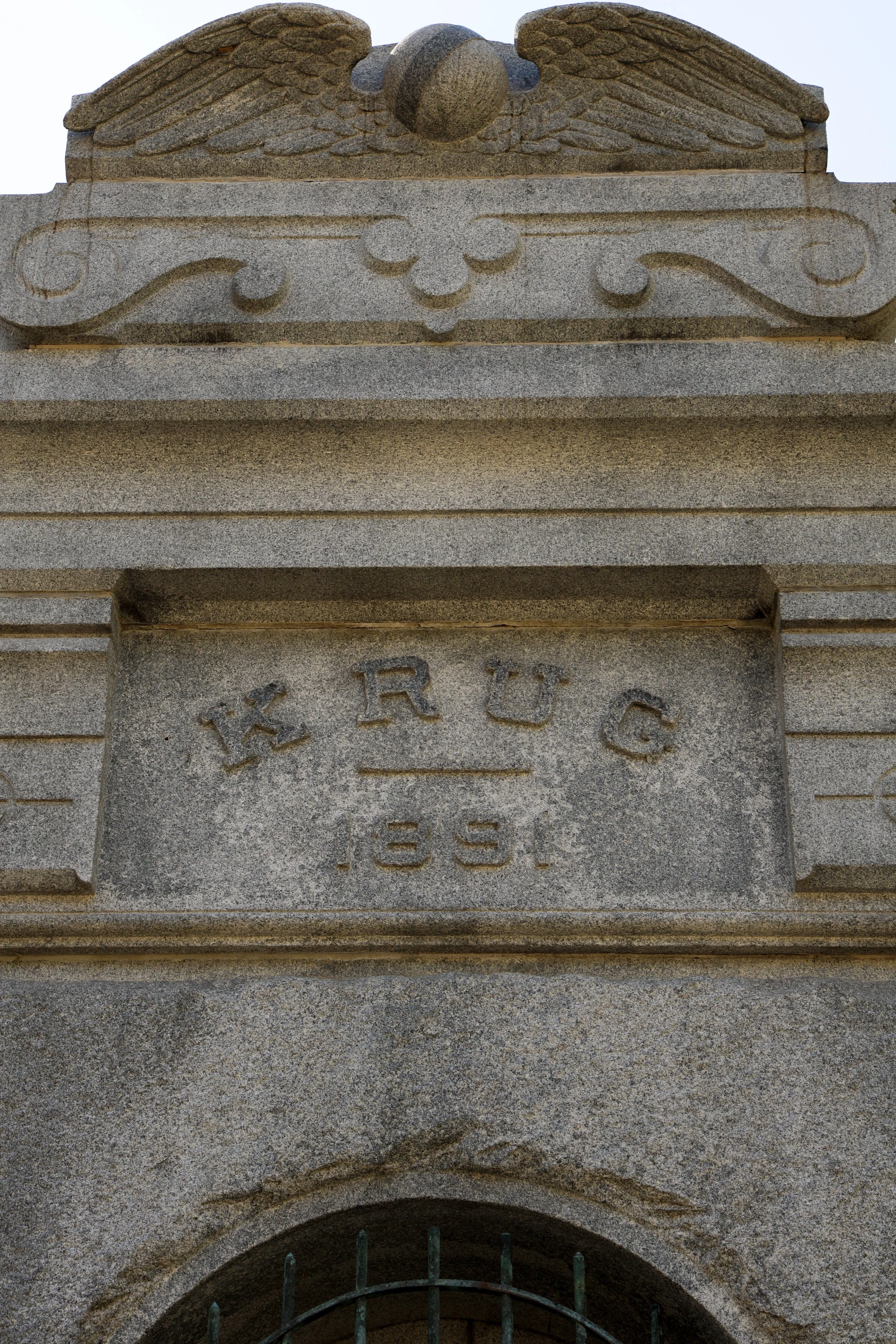
Above the entrance to the Krug mausoleum; probably one of the most influential families in St. Joseph history whose legacy still remains to this day. Two German brothers, Henry Krug Sr. and William, both started a grocery business in St. Joseph around 1859, “At that time, merchandise was brought to St. Joseph by steamboat and transported out west by wagon train. Henry managed the business operations in St. Joseph while William carried the goods on west.” He allegedly had many tense encounters with Native American tribes doing this. In 1868, they started a meat-packing business. In addition to this, the brothers would go on to invest in the Union Street Railway Company and the German-American Bank where Henry Sr. would be president until his death in 1904 with William then taking over. Henry Sr.’s son, Henry Jr., was a historian of St. Joseph and the President of American National Bank. “Henry and his father [Krug Sr.] donated a total of 160 acres to the city ... 'The Great Park Bowl,' now known as Krug Park." In the early days, Krug Park had a small zoo with exotic animals, playground and amphitheater, but now only the pond remains. Their former family mansions still remain in close proximity to the park grounds. "The Krugs were also noted for their hospitality ... for over eighty years was the scene of many happy gatherings. The climax of this hospitality was reached in February 1940, when Archduke Felix of Austria, of the House of Hapsburg, was entertained there."
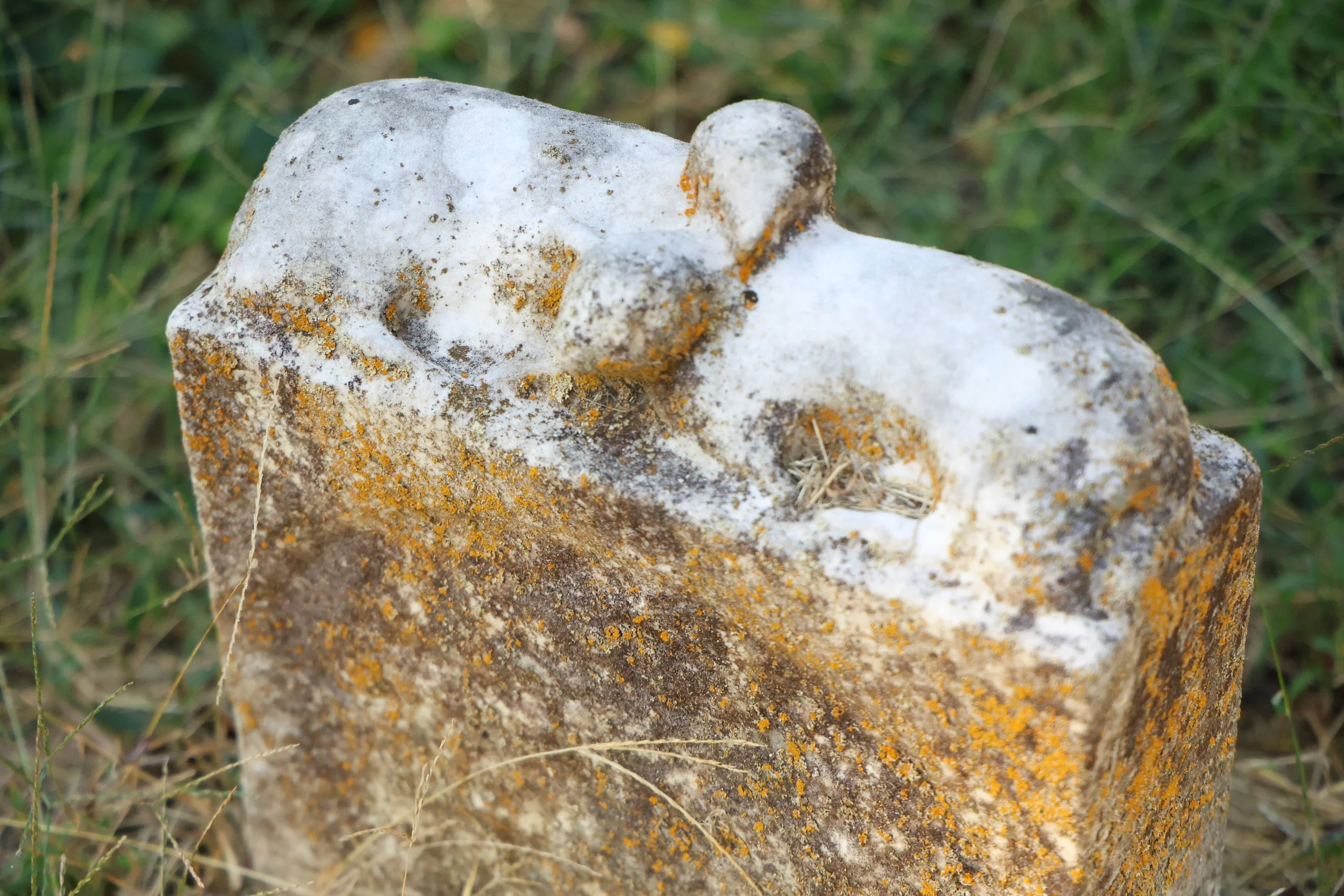
Two lambs on a headstone. With the inscription lost to erosion and decay, I can only wonder if the grave belongs to two babies or infants— perhaps twins.

Thomas Jefferson Burgess was the president of the Burgess & Fraser Iron and Hardware Company. Although born in Kentucky, he was a miner in Nevada City, California where he also studied law and later became a judge— at one point even running for county sheriff. He later returned to St. Joseph where he devoted his life to his land and raising fine farm animals. “He also takes great delight in fishing … He has a fine steam-yacht, the ‘Naptha Launch.’” He died at 71.
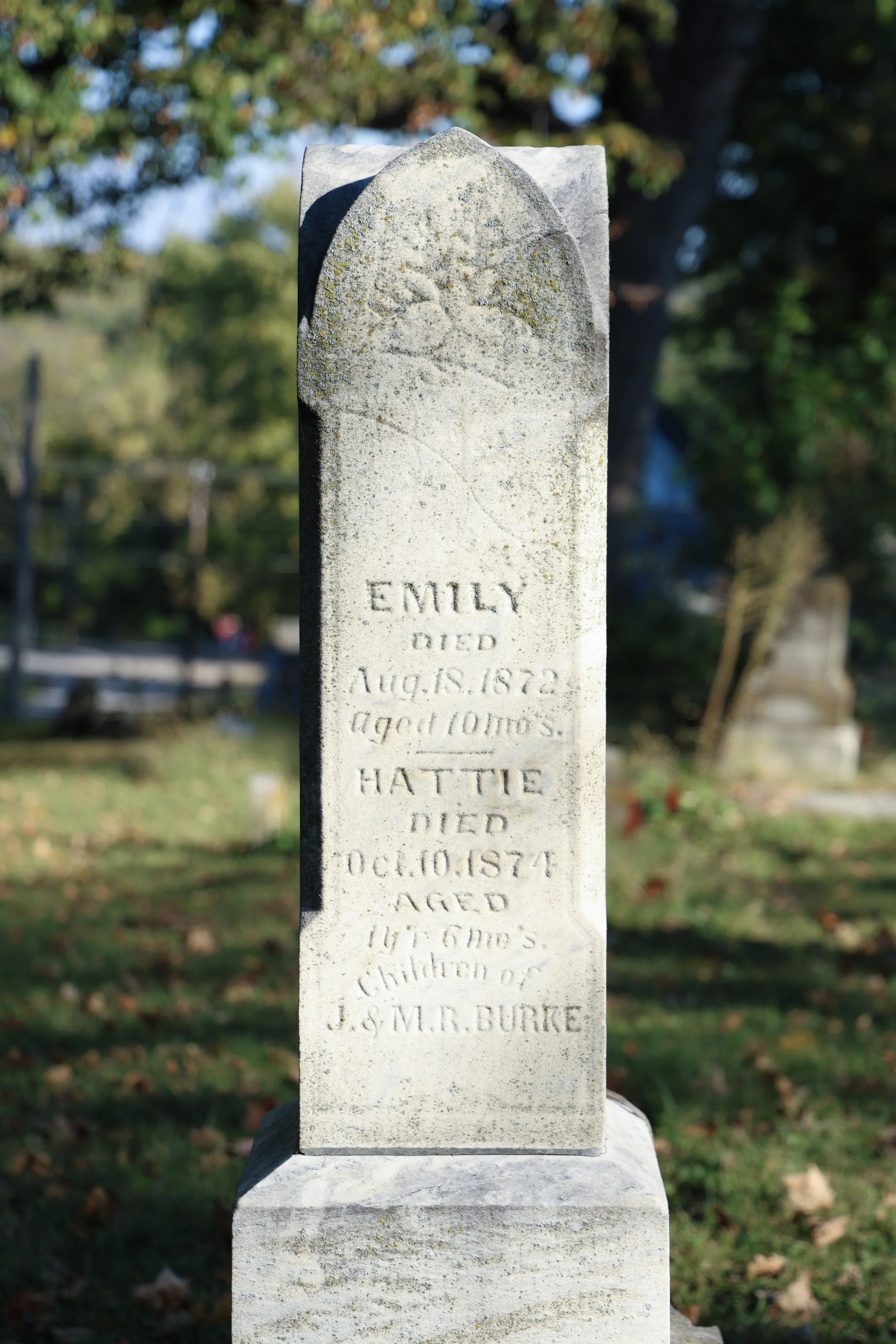
Headstone of the Burke family. Emily died at 10 months with her sister, Hattie, dying two years later in 1874 at only a year and a half old. Their mother, Mary, also died in 1874 at the age of 30. The father, Josephus, was a building contractor and would live a full but lonely life to the age of 85, never remarrying or having any more children.
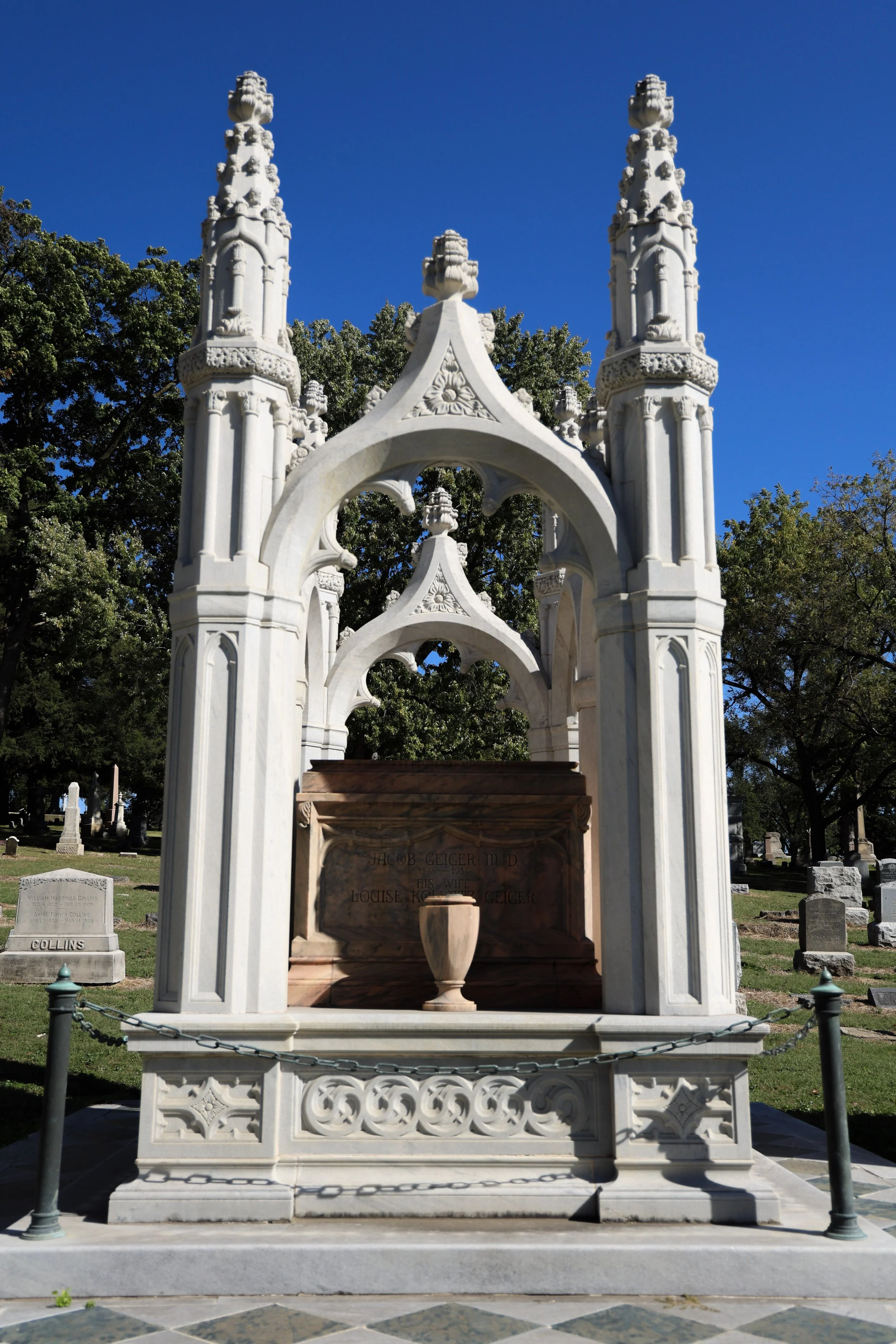
Beautiful gravesite of Dr. Jacob Geiger and his wife, Louise. Born in Germany, Jacob Geiger began his career in medicine when he worked at a St. Joseph pharmacy for fifteen years. After receiving his degree in 1872, "... he became an outstanding surgeon and for thirty-four years, from 1880 to 1914 ... His proficiency developed to a high degree, and a check kept on his surgical treatments for abdominal gunshot wounds, several years ago, showed complete recovery in seven consecutive cases." He was a professor at the St. Louis University school of medicine where he would travel to once a week and lecture students. The legacy of Geiger still remains to this day, "The family settled on a farm about a mile north of the waterworks, where the Boy Scout camp, Camp Geiger, is [now] located."
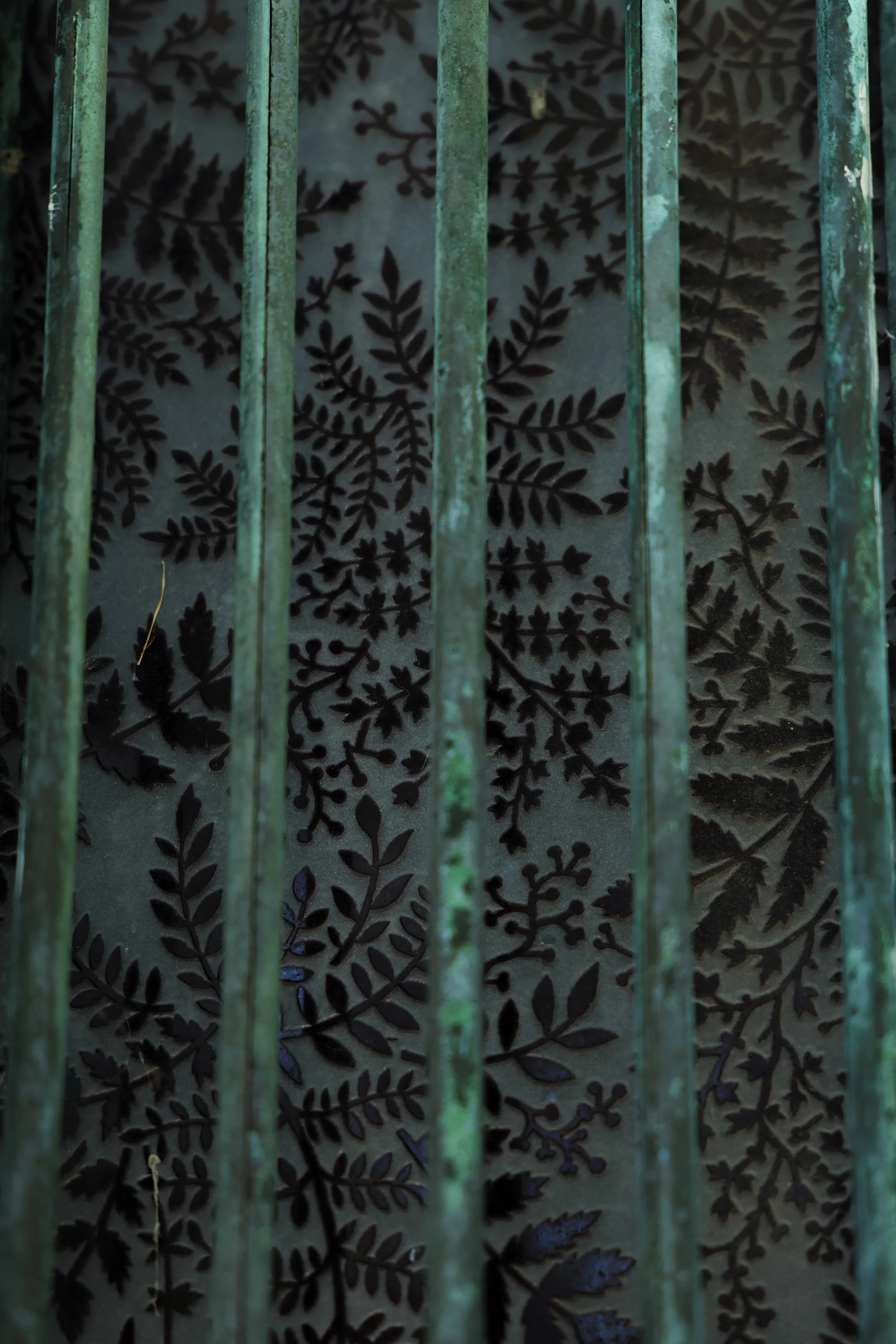
Carved red stained glass on the Judson Mausoleum.
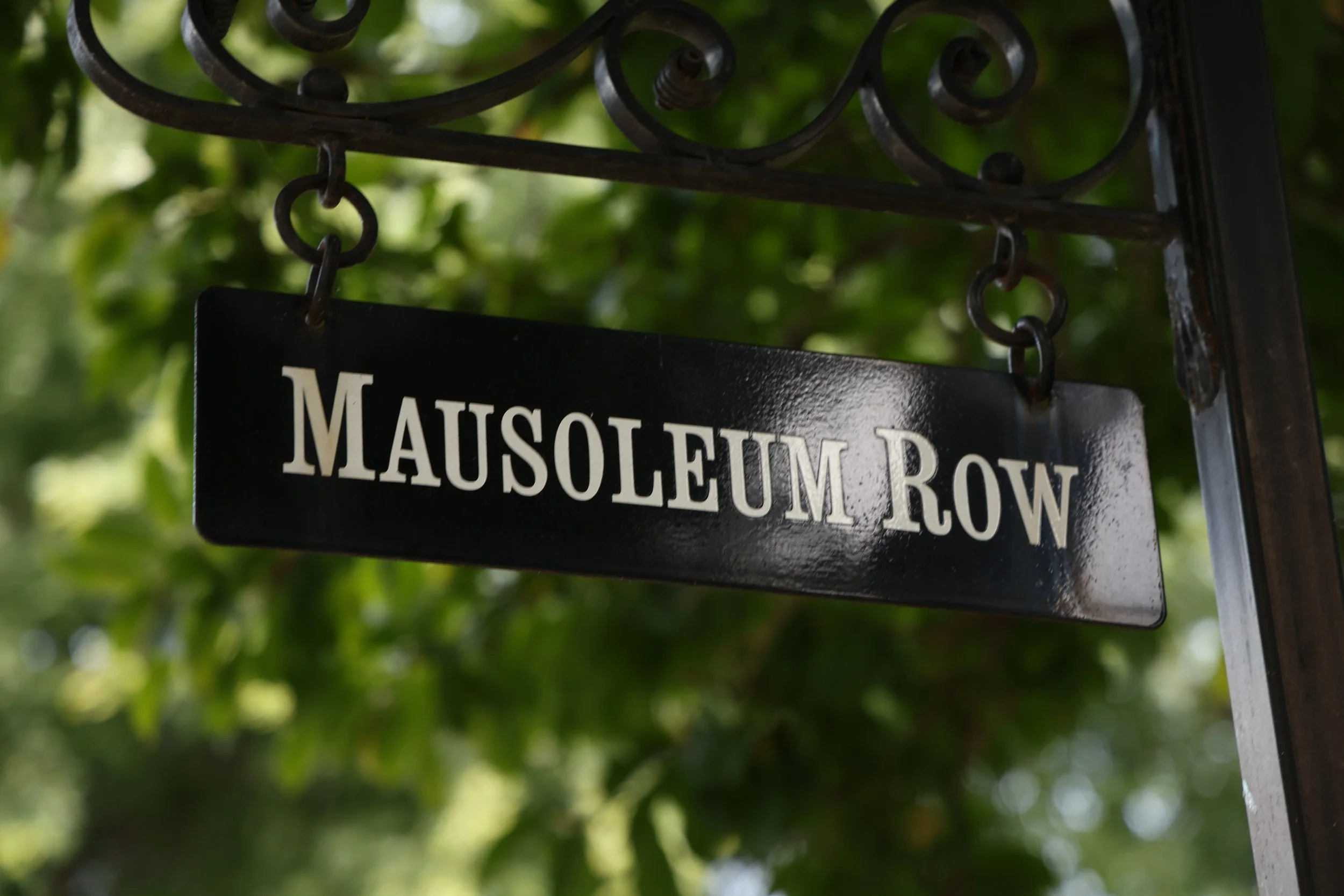
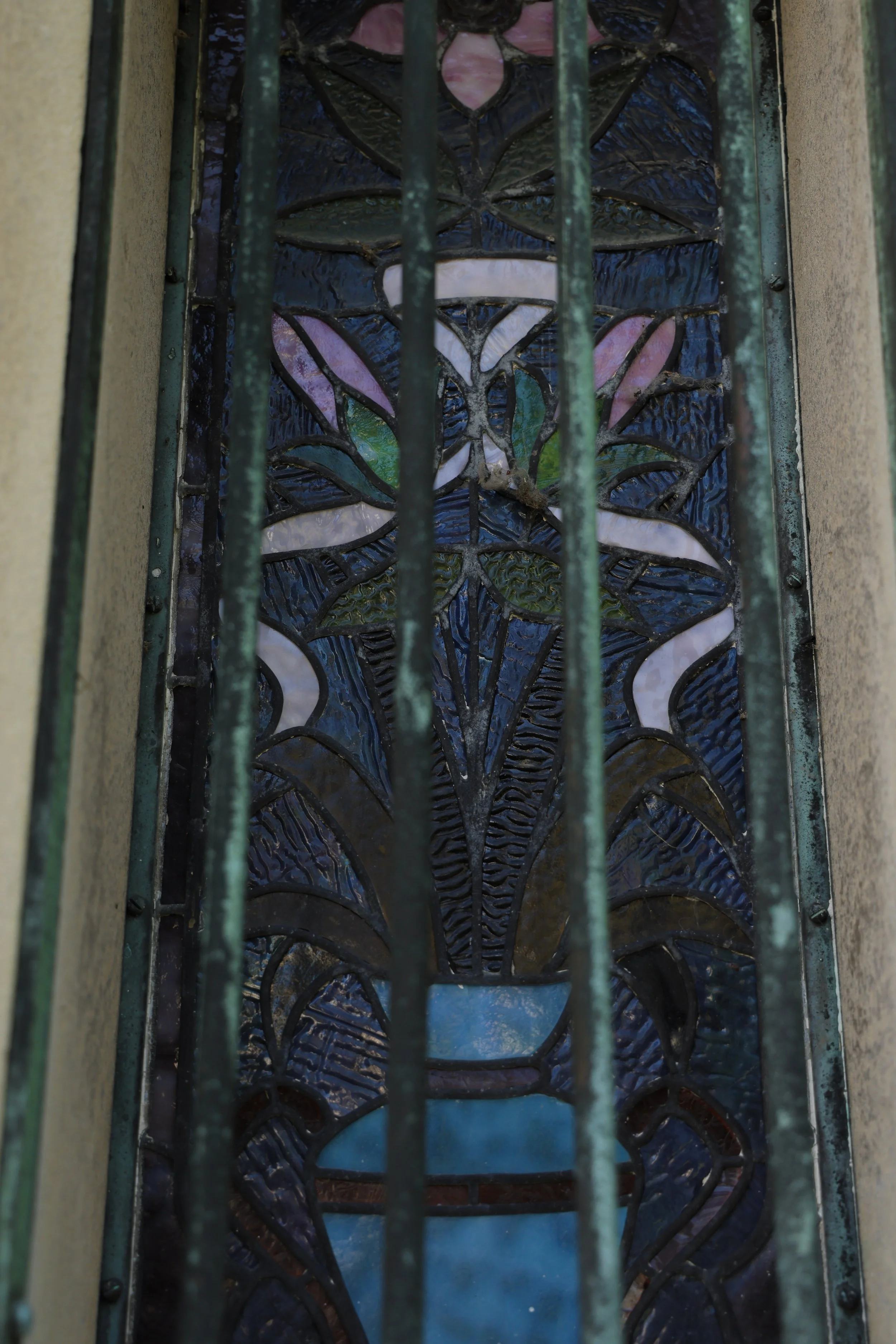
Beautiful colored stained glass on the Self mausoleum.
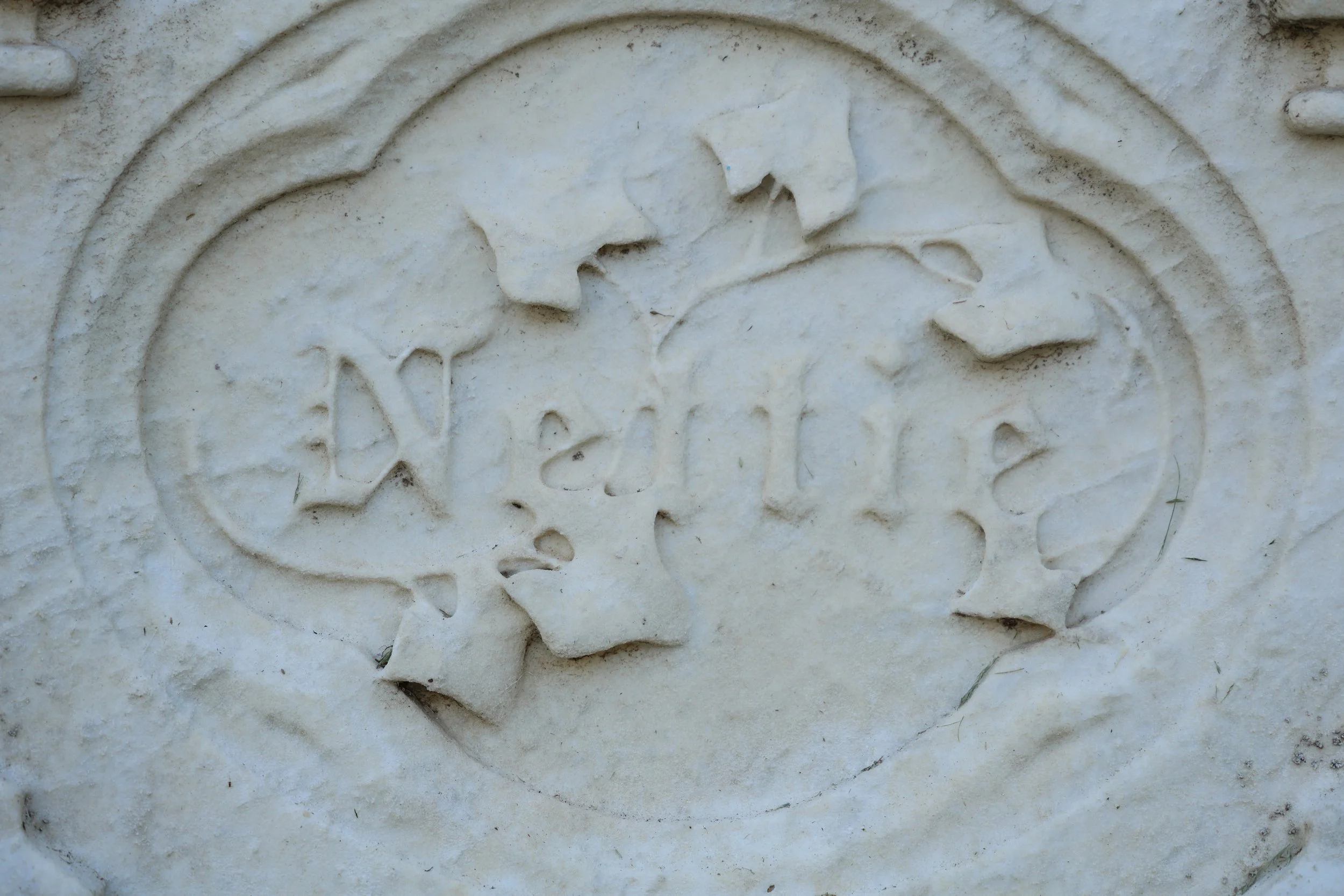
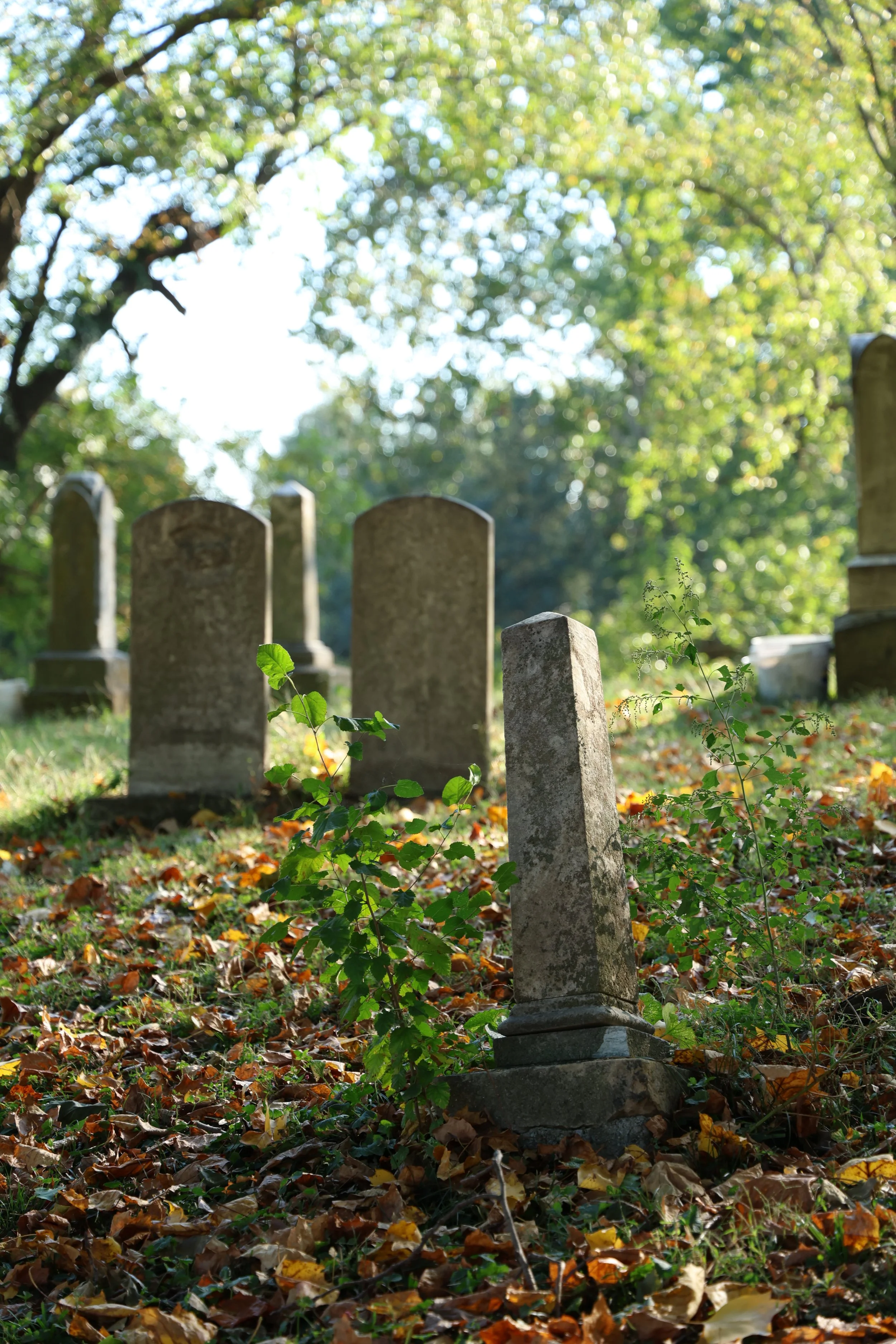
In the mid 1800s, Simeon Kemper and his wife, Jane Ann, bequeathed two-thirds of a 20 acre plot of their land to be made into what is now Mount Mora. On the top of the hill sits the earliest graves in the cemetery— the graves of the Kemper children. In 1847, their 3-year-old daughter, Susan, died with their 10-month-old son, Simeon, dying just nine days later; perhaps caused by the same illness or disease. Sadly, most of the graves in this area are so old and eroded, the inscriptions are completely illegible. However, somewhere in this general area the Kemper children are buried.
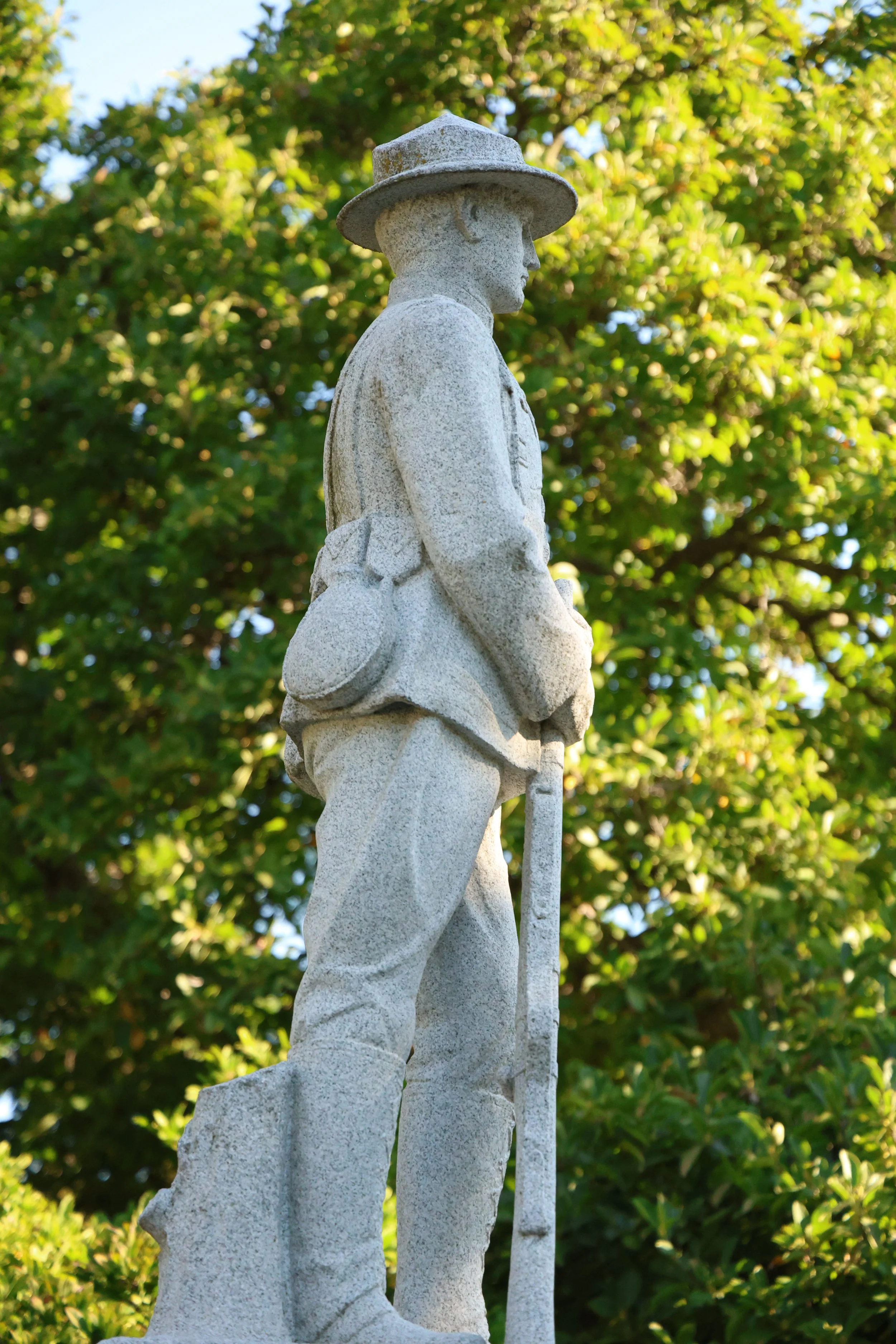
The World War Memorial erected in 1926. The inscription reads, "In honor of those who answered their country's call during The Great World War 1917 - 1918."
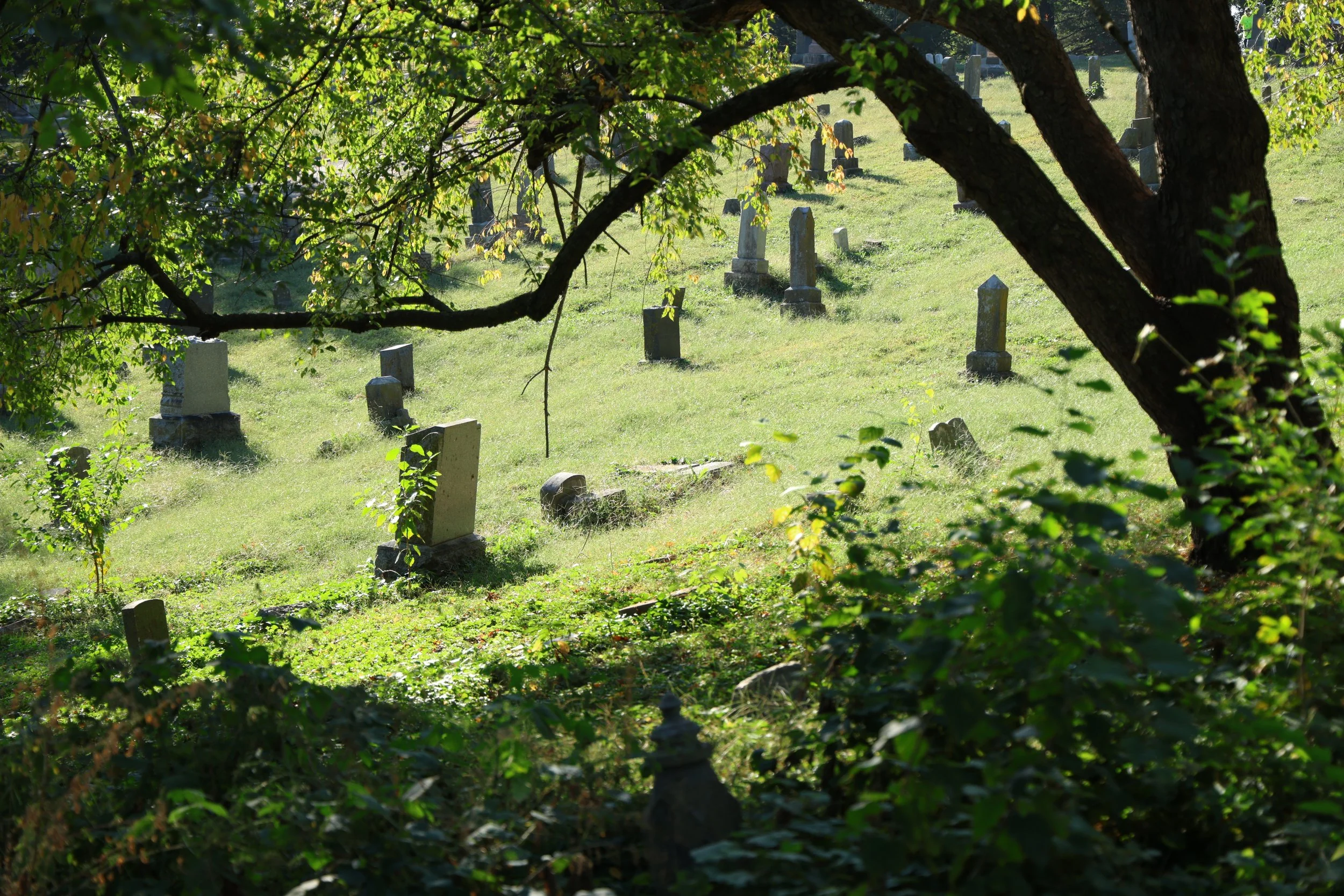

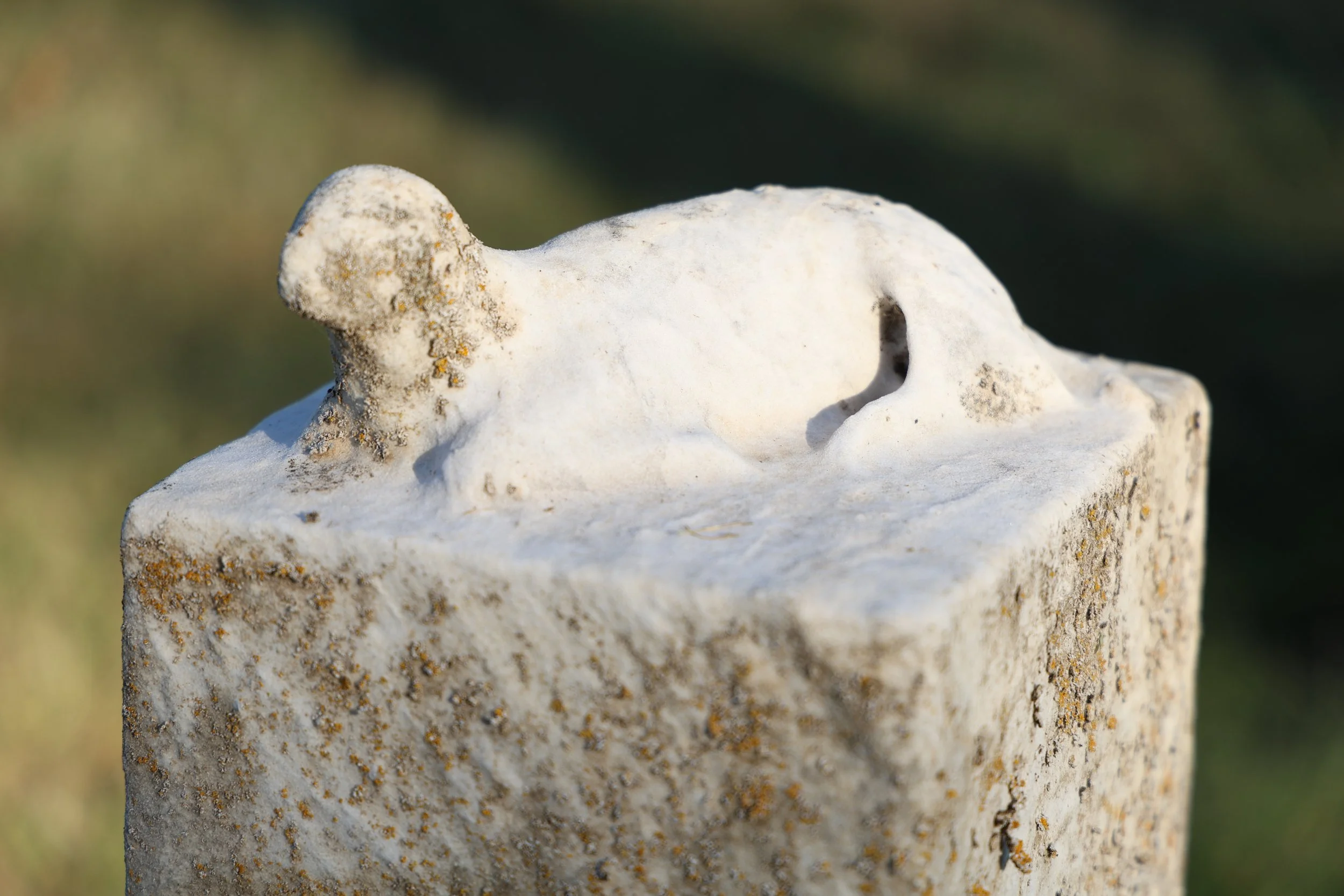

The inscription on Sarah Tootle's headstone reads reads, "We part to meet again."

Lillian Spencer was a mother of two young children when she died at 23. Her own father died when she was four.
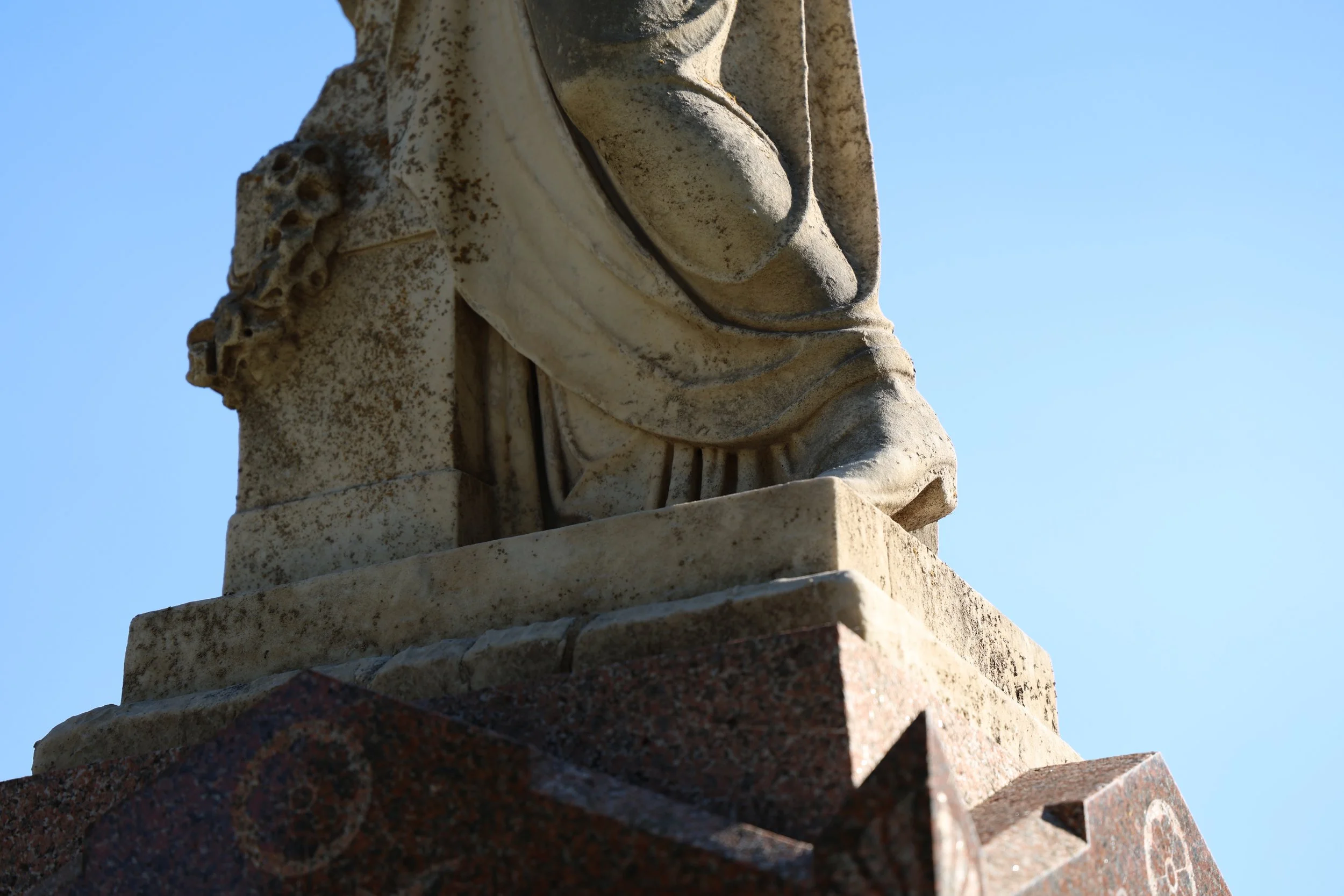
This headstone is nicknamed "Cowboy Jesus" because instead of sandals, Christ is seen wearing boots.


A weed sprouts on a headstone.
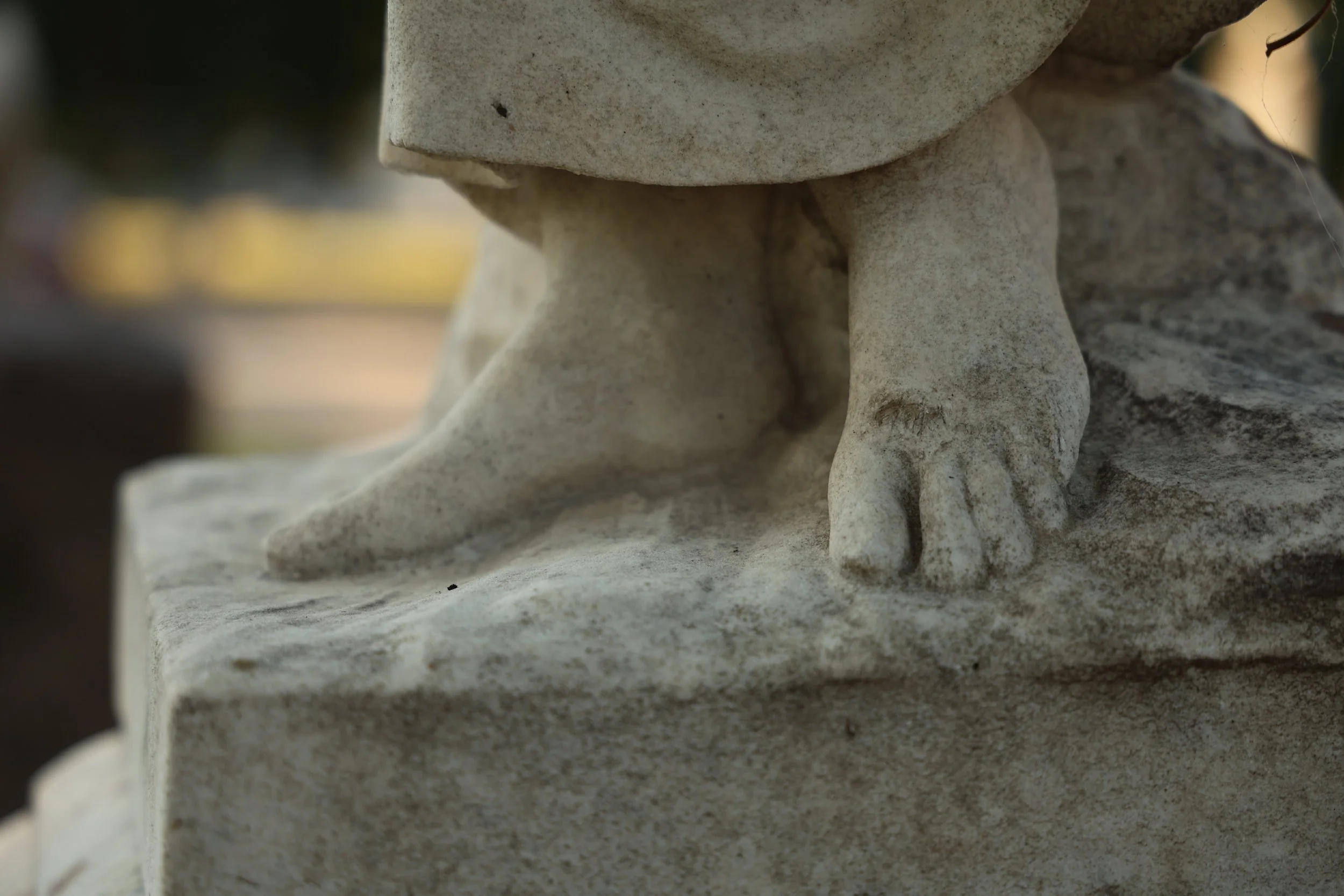
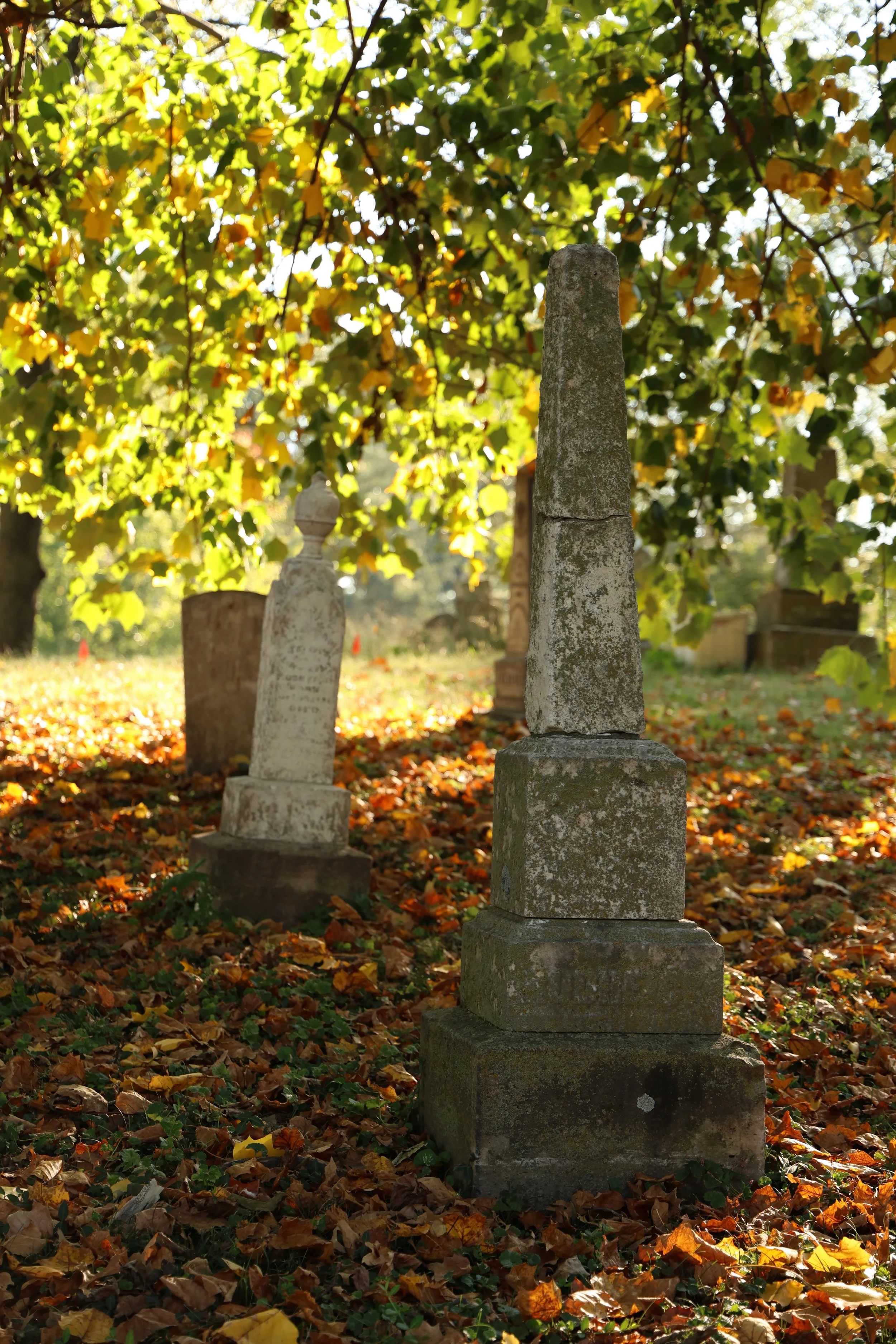
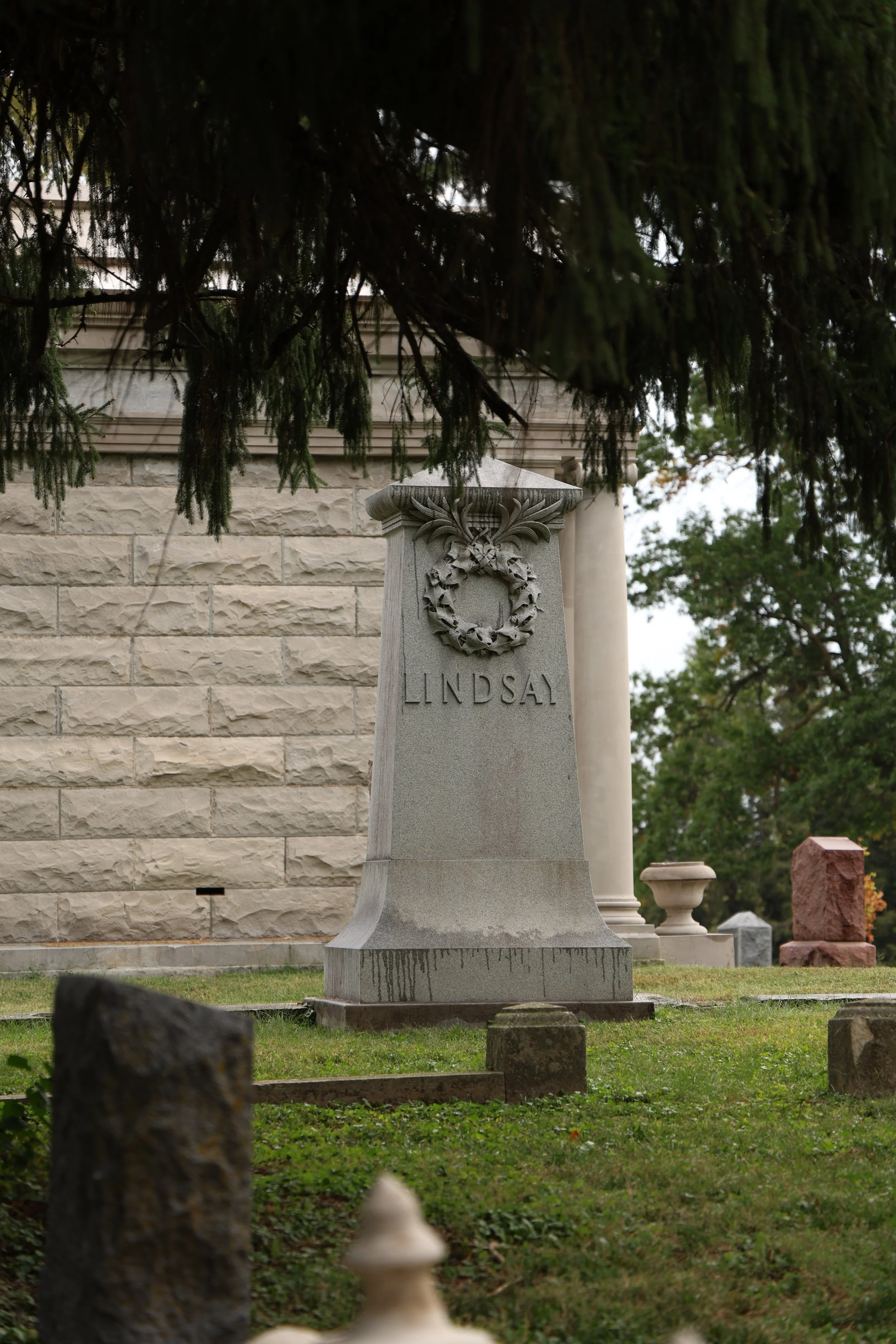
"Ernest Lindsay, Sr., was especially prominent in the financial and business life of the city. He was president of the State National Bank, and ... was largely instrumental in establishing the present stock yards and packing plants in St. Joseph. At the time of his death, in 1902, he was the oldest banker in Missouri." He was 56.
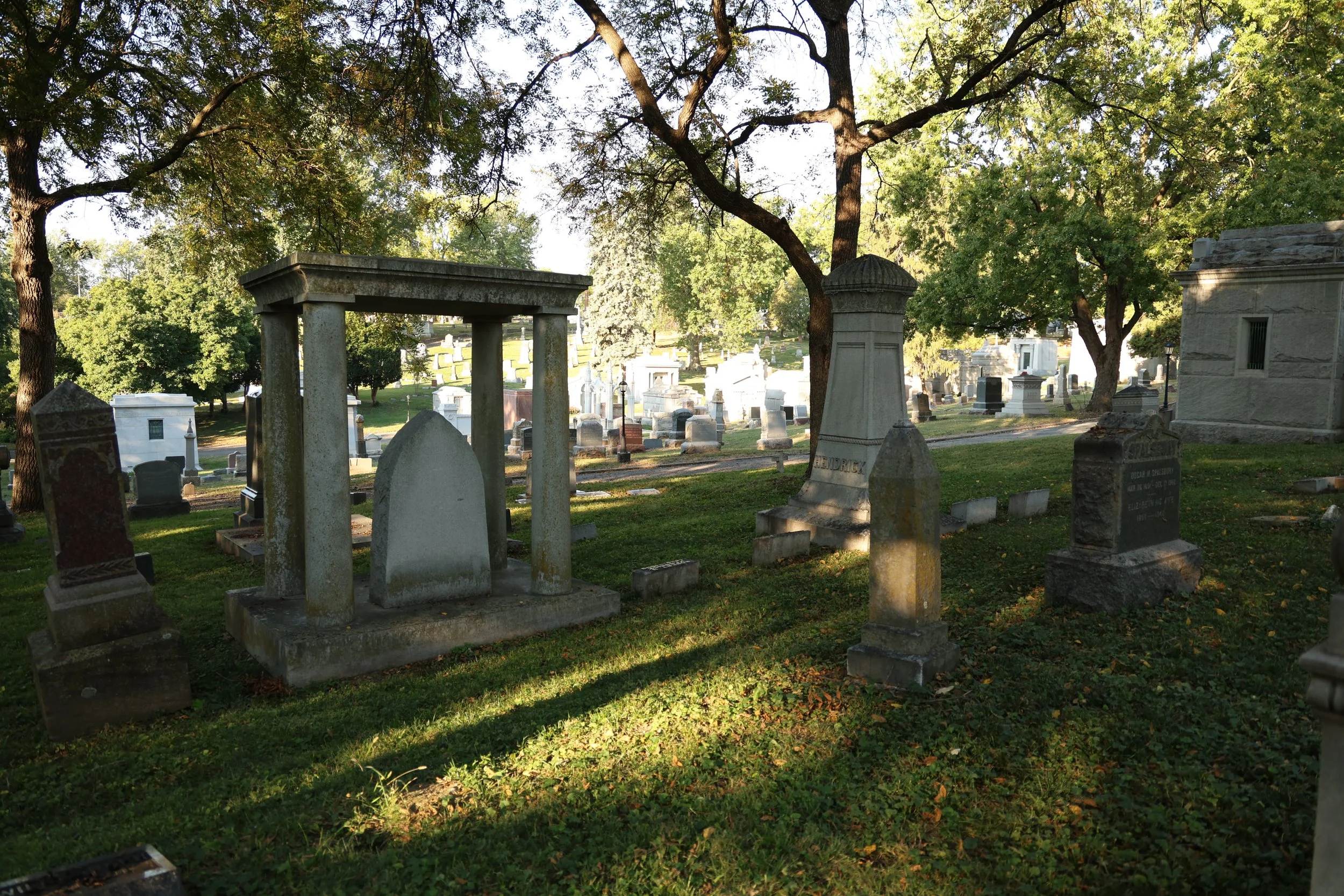
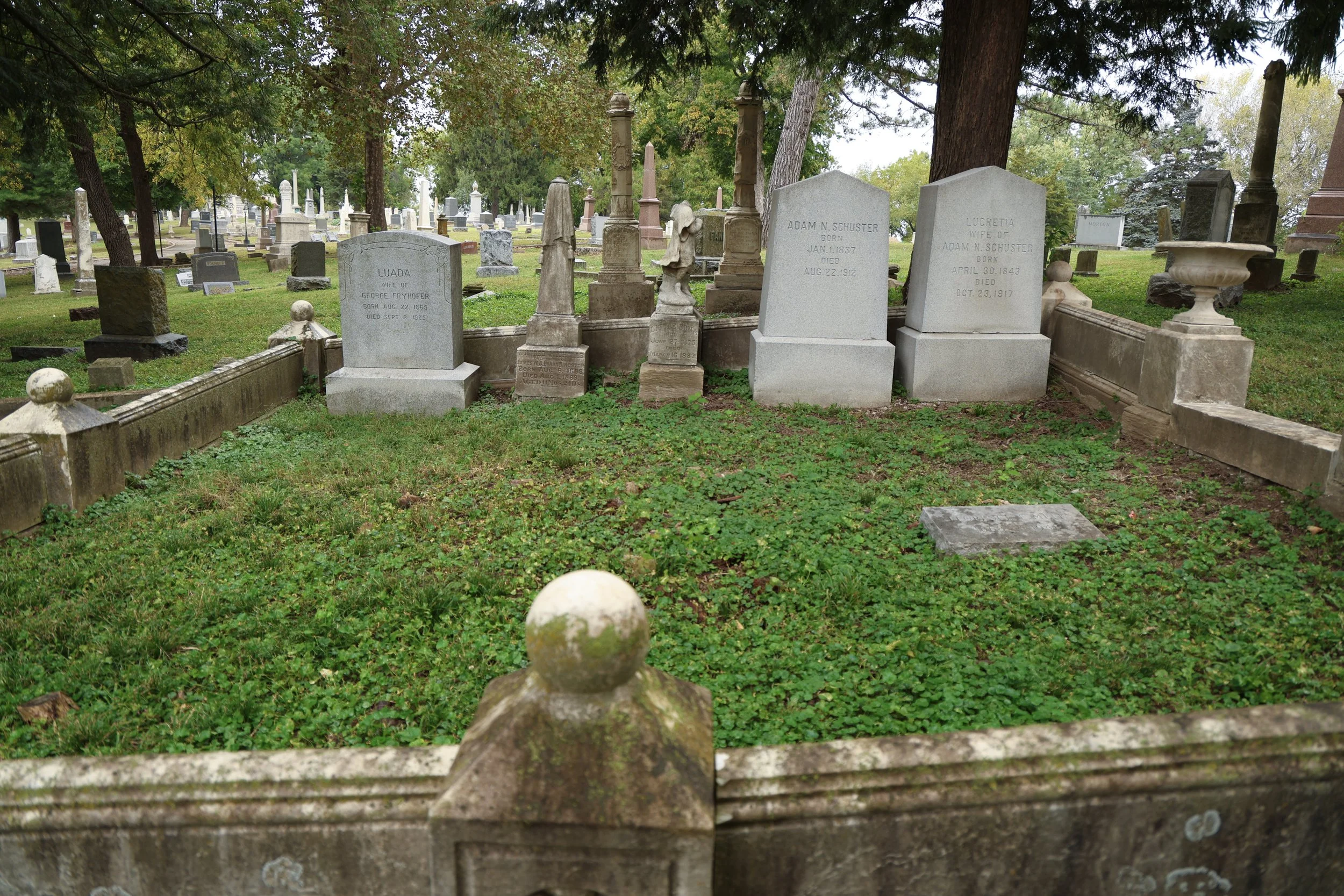
The Schuster family plot. "Little Edna" was the first to be buried there after dying at only seven, hence her being centered.
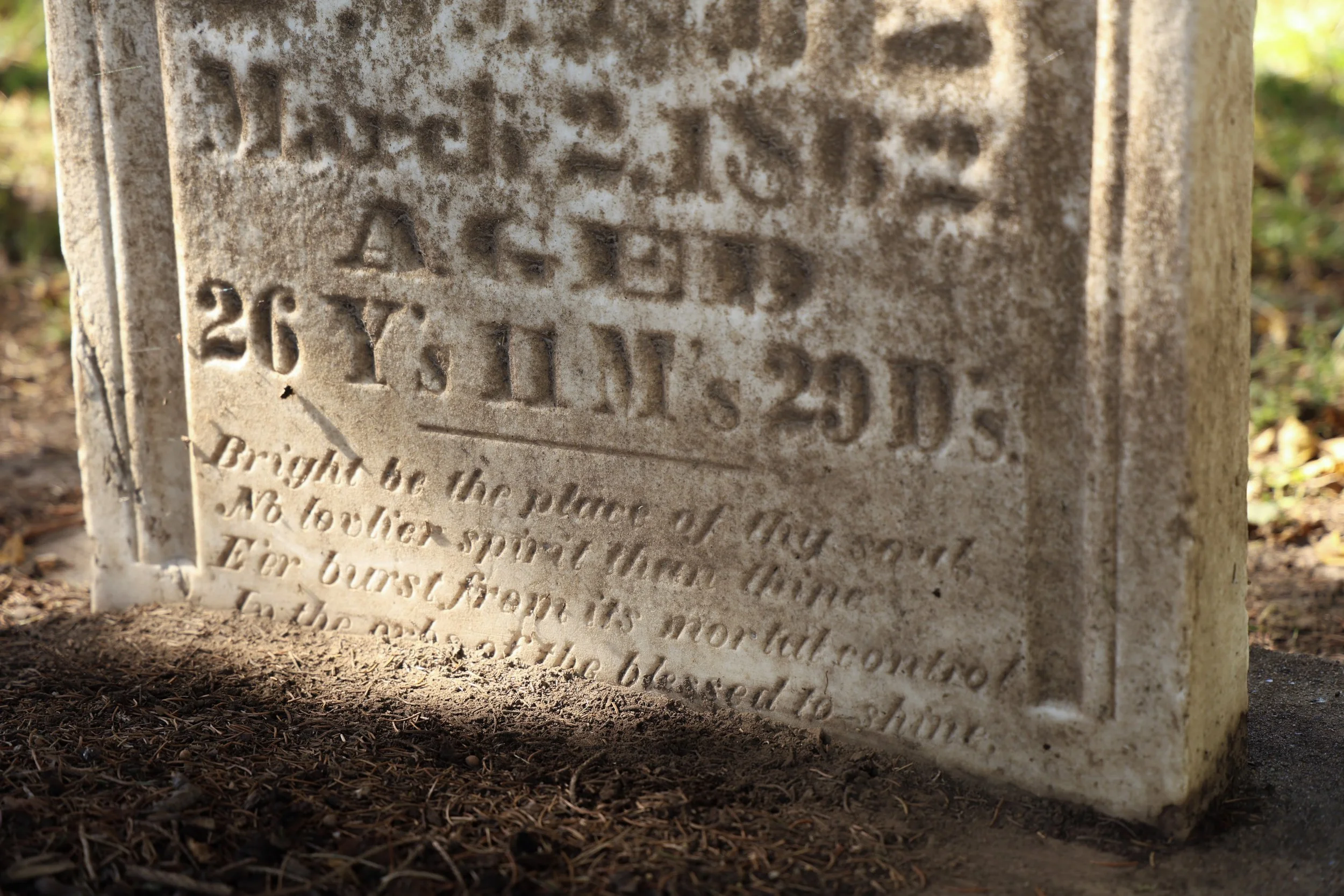
Although her last name has been lost to erosion, Julia's inscription reads, "Bright be the place of thy soul; No lovelier spirit than thine; E'er burst from its mortal control; In the orbs of the blessed to shine." She died shortly before her 27th birthday.
ASHLAND CEMETERY
SAINT JOSEPH, MISSOURI
Both established in 1869, Oakland and Ashland cemeteries operated separately. They would merge together to form one cemetery in 1913.



On July 23, 1876, 15-year-old Clara Kratt and four of her friends were riding in a boat on Lake Contrary. When Kratt and another girl began reaching out to collect waterlilies, the boat capsized. All the five girls drowned— the eldest being 17 and the youngest, seven. Of the five girls, four of them were buried at Ashland Cemetery. The fire department turned one of their ladder trucks into a large hearse decorated with drapes and flowers, and it was pulled by four white horses. Nearly 150 carriages and buggies attended the service.

Headstone of 2-year-old Lawrence Hubbard Fraser who died of pneumonia/measles.

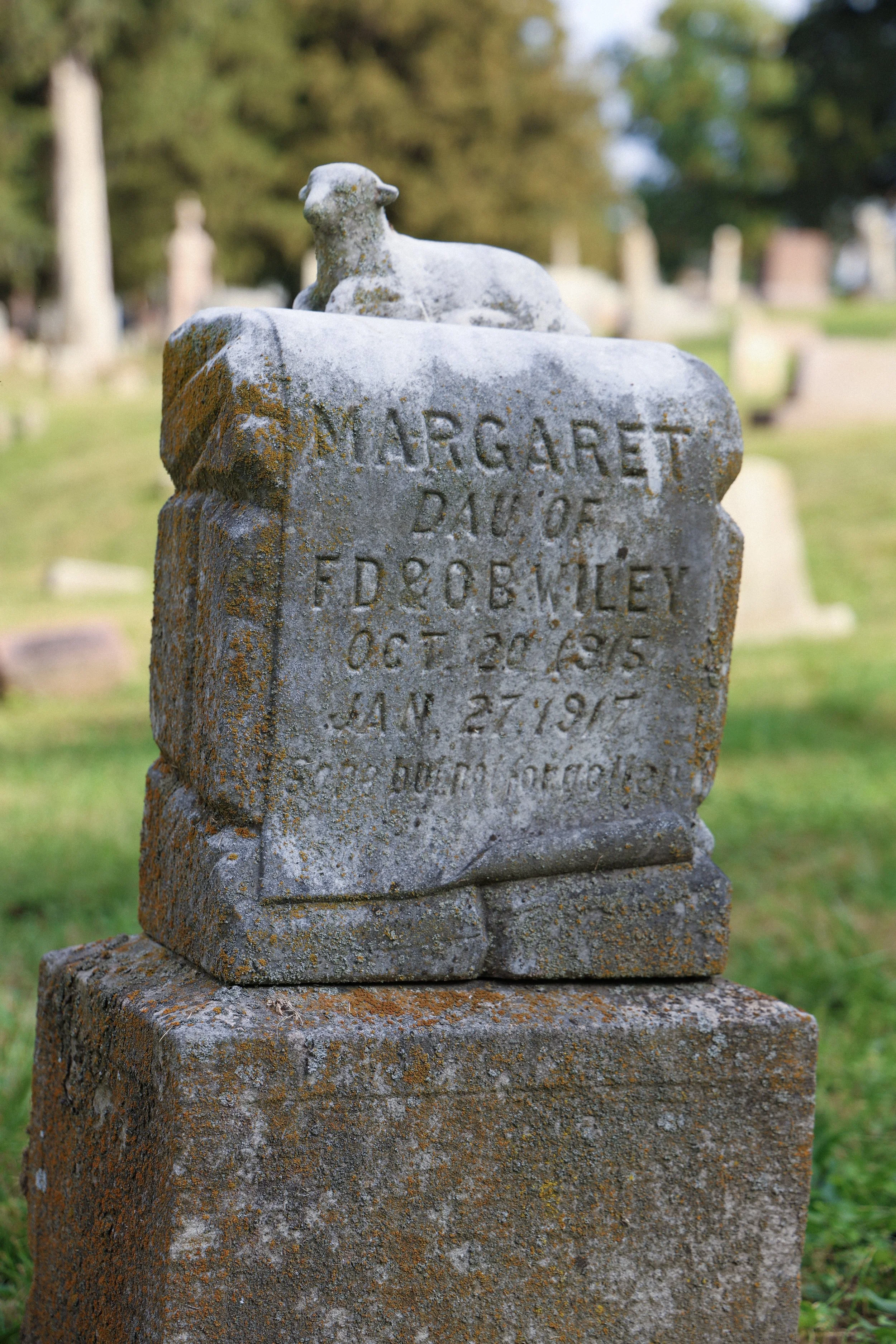
Headstone of 2-year-old Margaret Wiley who died from bronchopneumonia.


Mildred Beatrice was only four when she died of diphtheria.


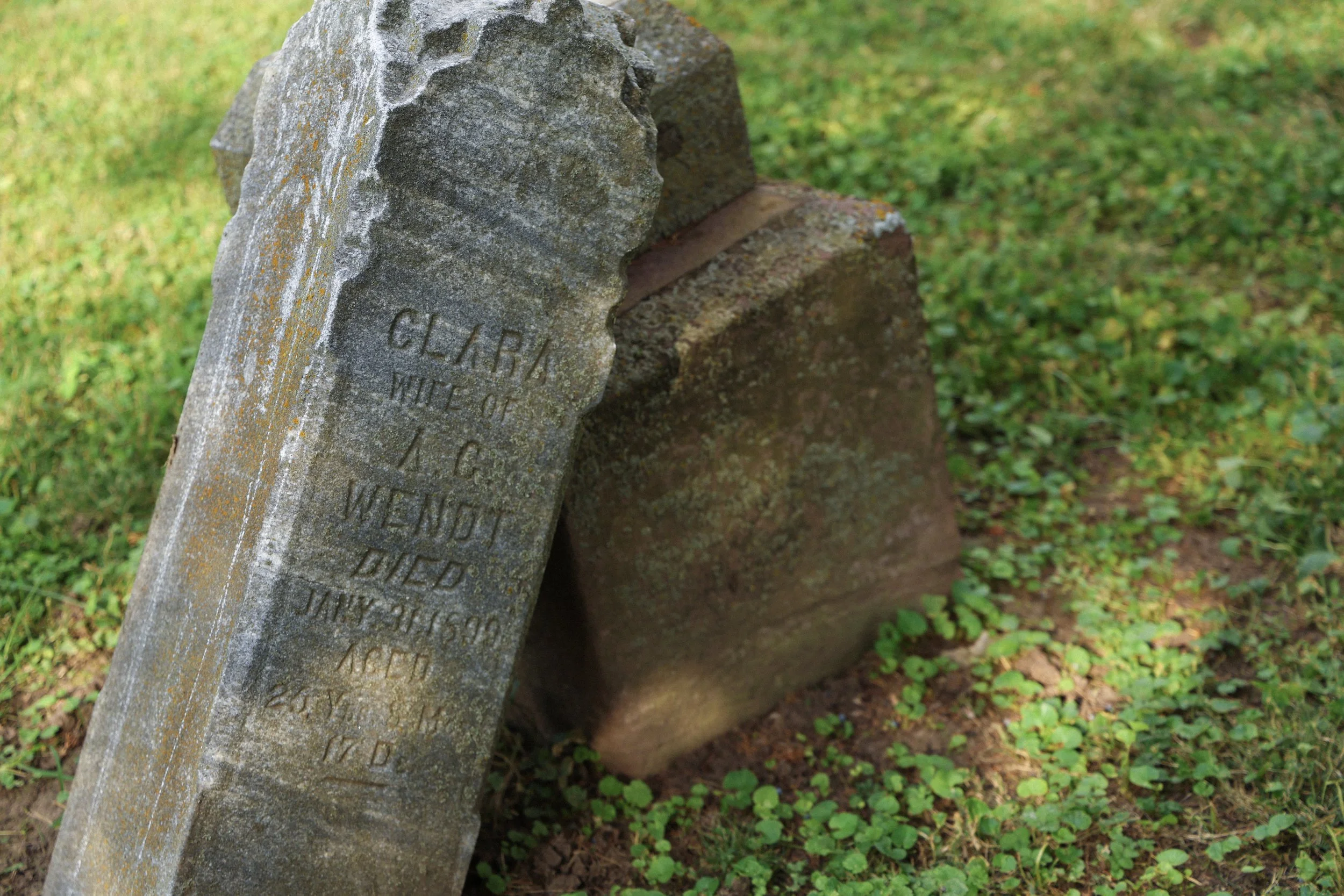
Clara Dritschler Wendt arrived in New York City from Germany when she was four years old. Before marriage, she worked as a clerk and seamstress. She died at the age of either 24 or 25.
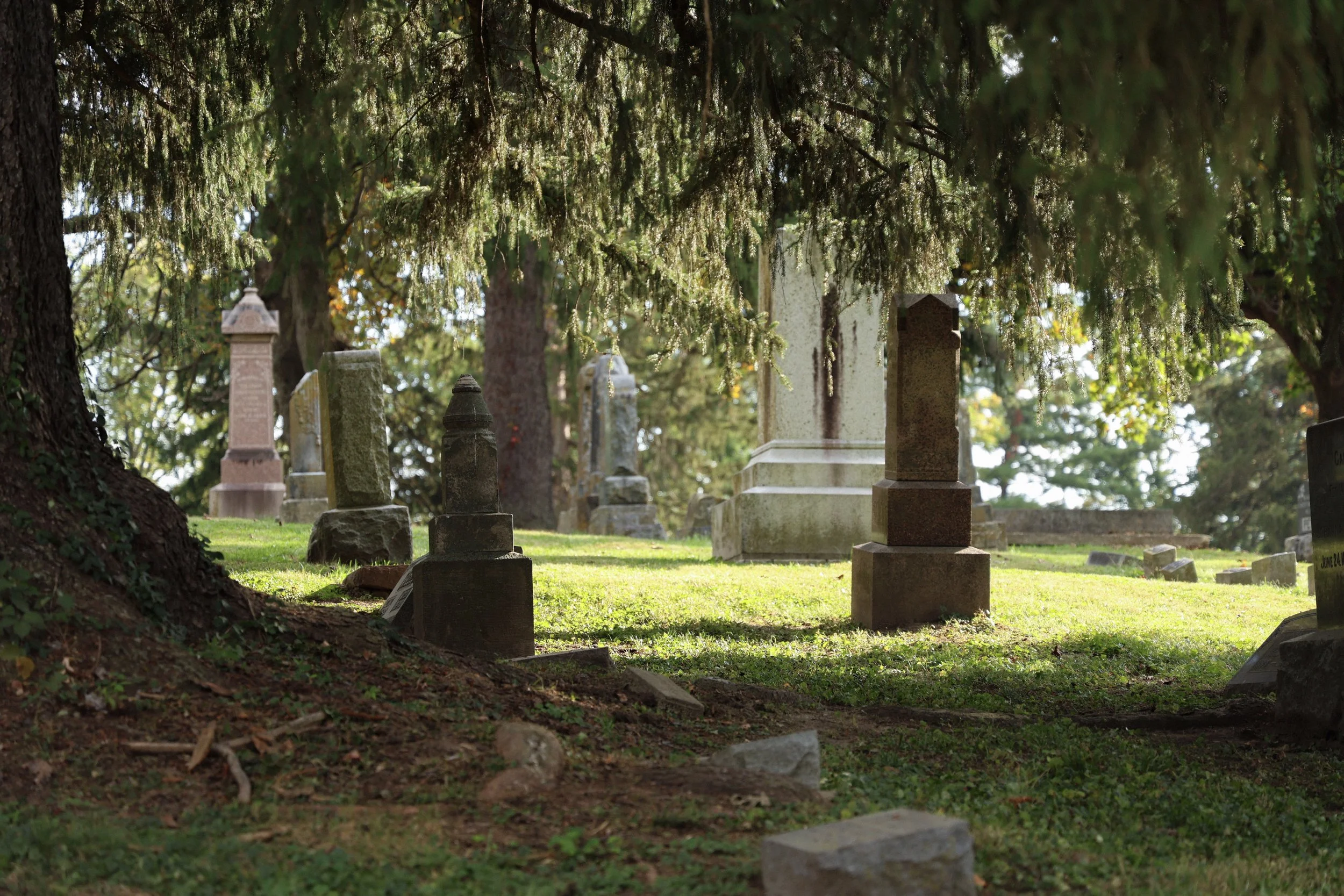
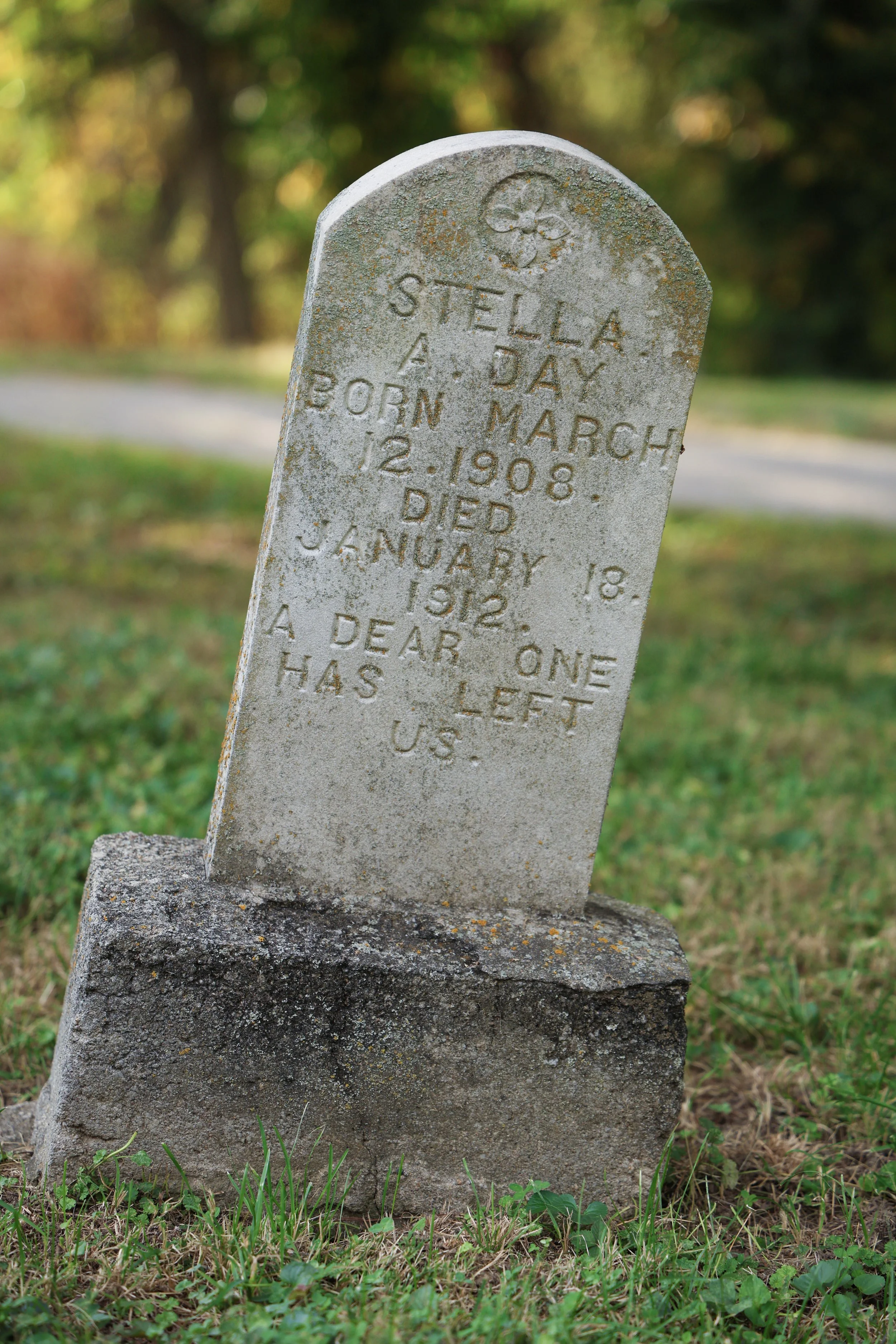
Headstone of 3-year-old Stella. The inscription reads, "A dear one as left us."



Headstone of Rudolf Florin. Erosion to this headstone has caused it to break apart and become nearly illegible.


Friedrich Wilhelm Sauer only lived for five days. His inscription is in his parents' native tongue, German.
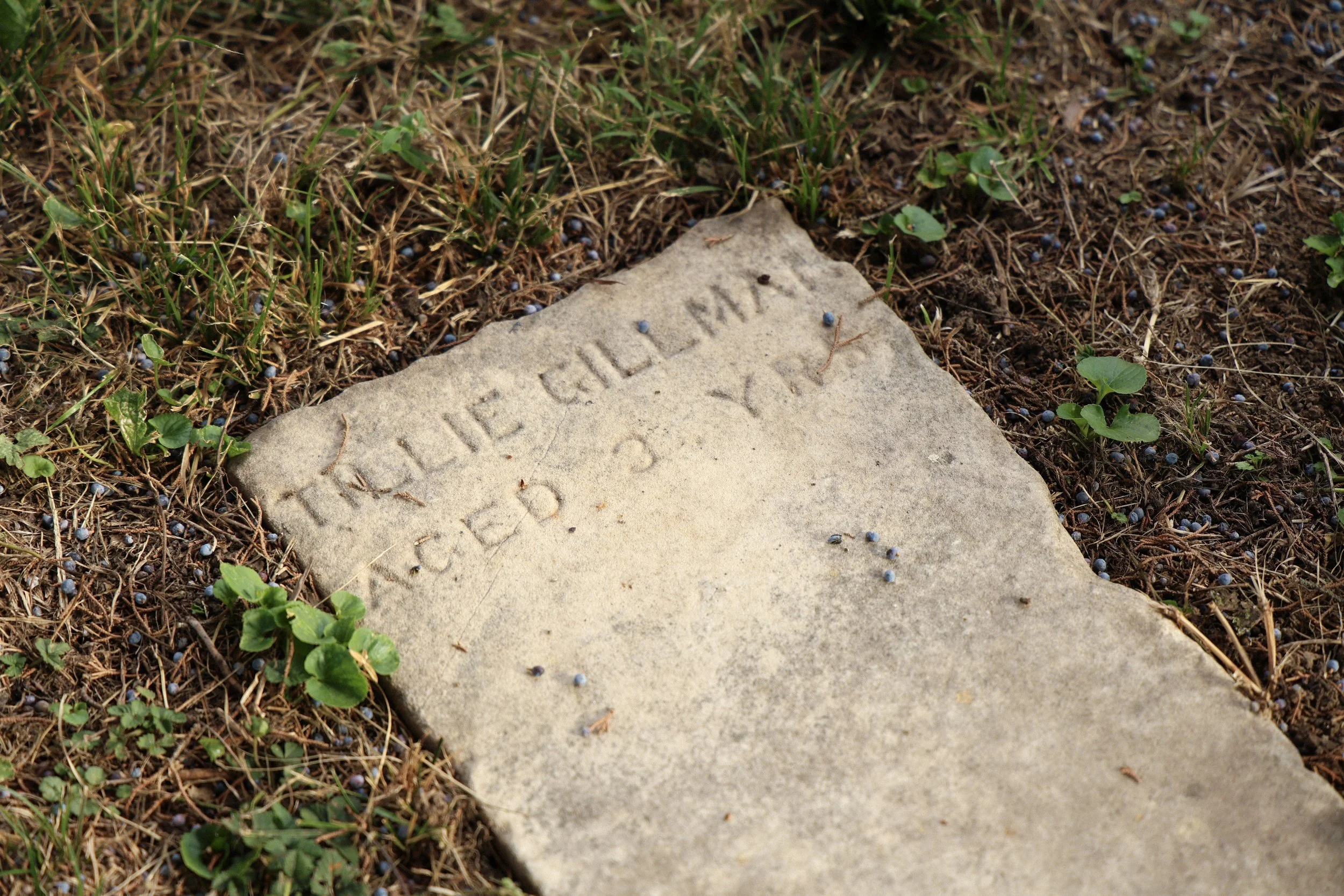
Tillie Gillmar passed away at the age of three. Her dates of birth and death are unknown.
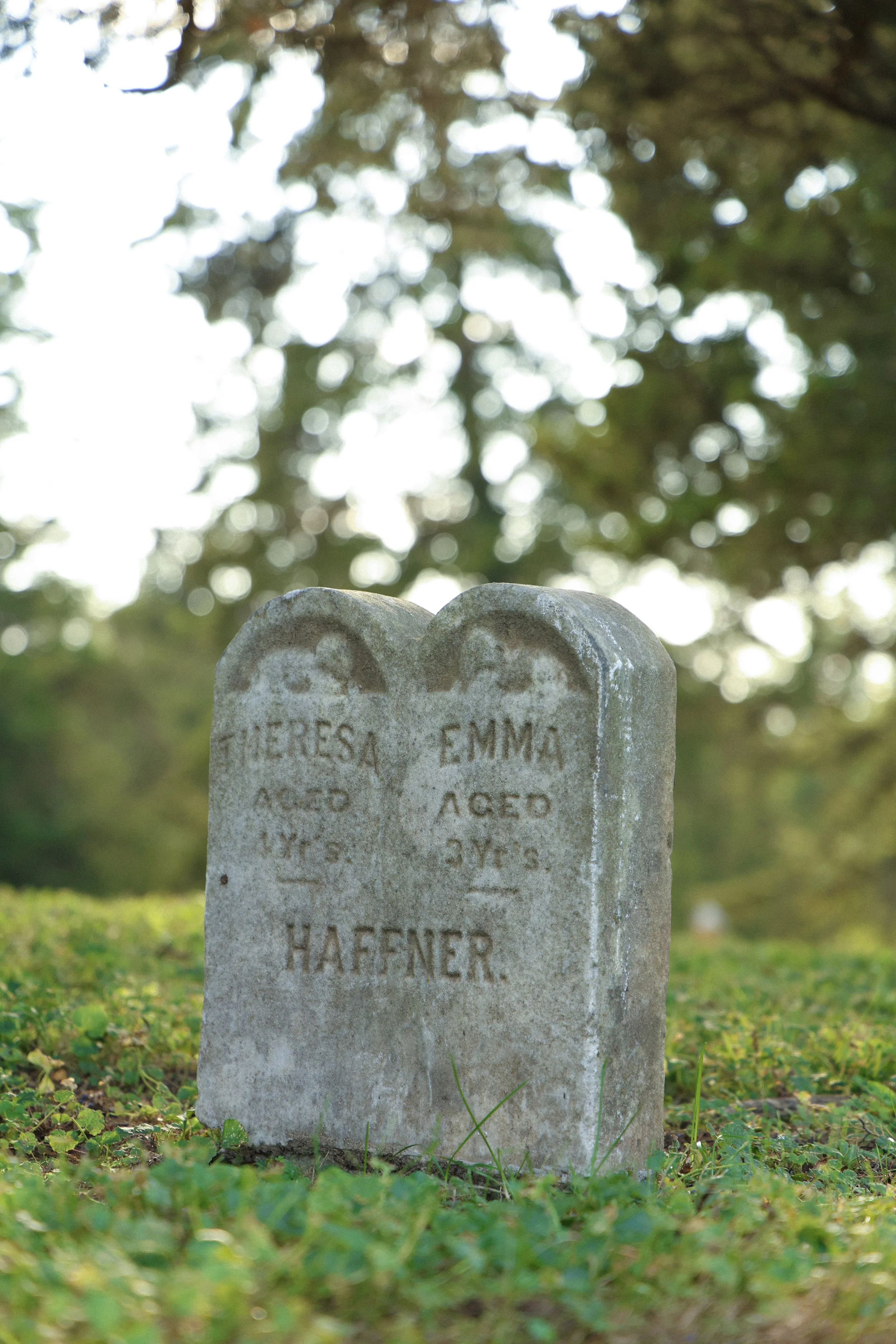
Headstone of two sisters; Theresa, who died at four, and Emma who died at three. The dates of their births and deaths are unknown.



Roy Heitman was five when he died. It's not known if he once had a headstone and it was replaced with this marker, or if this marker was the only identification he received.

"In 1890 Joseph Cullen Root founded Woodmen of the World, a fraternal benefit organization, the purpose of which was to make life insurance affordable to everyone. From 1890 until 1900 the policy included a tombstone." Charles Retzlaff was part of this fraternity.




An Easter bunny figurine and rock placed on the headstone of 5-day-old Friedrich Wilhelm Sauer.


This overlooks the southwest section of Ashland Cemetery. This part was once an entirely different graveyard, Oakland Cemetery, before the two merged in 1913.

Headstone of Franciska and Emma Demond in the children's section. Their ages are unknown.
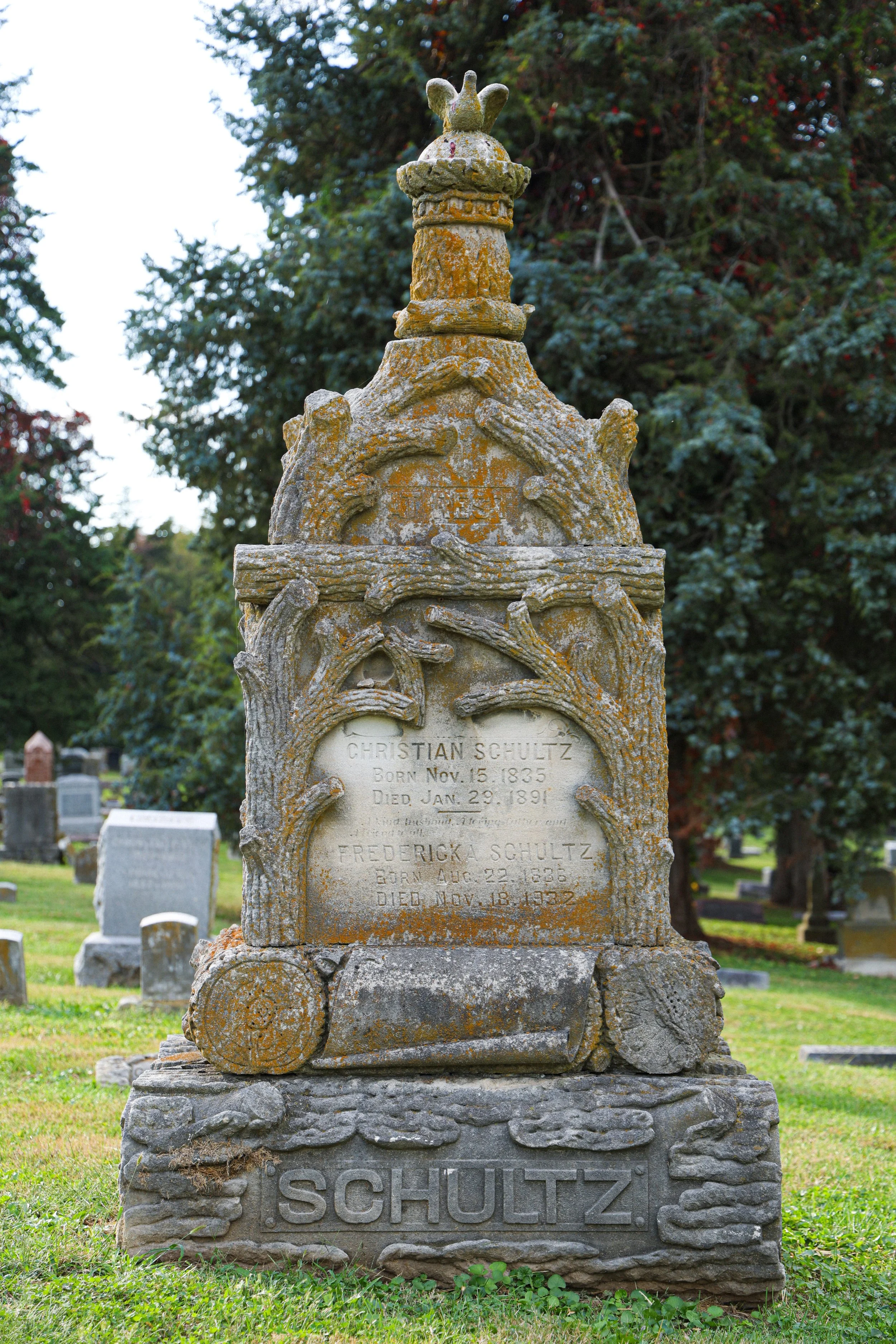

In the designated children's section, a headstone knocked from it's base reads the prayer, "Gentle Jesus, meek and mild, Look upon a little child; Pity my simplicity, Suffer me to come to Thee."
MOUNT OLIVET CEMETERY
SAINT JOSEPH, MISSOURI
The city’s primary Catholic cemetery. It’s known for the several porcelain memorial portraits on headstones that were popular in the early 20th century. What’s interesting is that this cemetery wasn’t named the new Catholic cemetery until 1895. The former, Cavalry Cemetery, originally founded in the mid 1850s, had fallen into deep neglect to the point it needed to be acted upon. Almost everyone who was buried in Cavalry was reinterred here. Despite having a headstone in this cemetery, Joseph Robidoux (pronounced “roo-bee-doo”), the founder of St. Joseph, was never found in the Cavalry Cemetery … despite being buried there …

In 1906, after band practice, 8-year-old Felix Spugnardi was walking with a playmate along the Missouri River when he lost his footing and fell in. Per newspaper clippings, "There were men nearby ... but they were seen to make no effort to save the drowning boy's life." His body was found four miles south caught on some branches along the riverbank. "Members of the band composed of Italian boys, of which Spugnardi was a member, will march in the funeral procession in their suits ... The one belonging to the body of Felix Spugnardi will be put on the coffin, and will be buried with the body." Felix's family had a monument imported from Italy, his parents' native country, to place on his headstone.


The porcelain portrait of 10-year-old Theresa Marion Ruggeri who died of meningitis..

Theresa Choka died suddenly at at either 46 or 47 years old while riding a streetcar downtown. Almost five years later, her son, Leo, died at 35. Fifteen years later, her other son, William, died from accidental electrocution at 40.

"Edwin Quinten, three-year-old ... died at 6:25 o'clock last night as a result of injuries sustained when the little boy was knocked down by an automobile ... The little fellow suffered a severe concussion of the brain and did not regain consciousness after the accident."


A spider who decided to make its home in front of the cherub in the baby section.


Joan's age is unknown, but she was either a baby or child.

Headstone belonging to the two Walsh boys. James M. died at six months and James A. died at five years old.

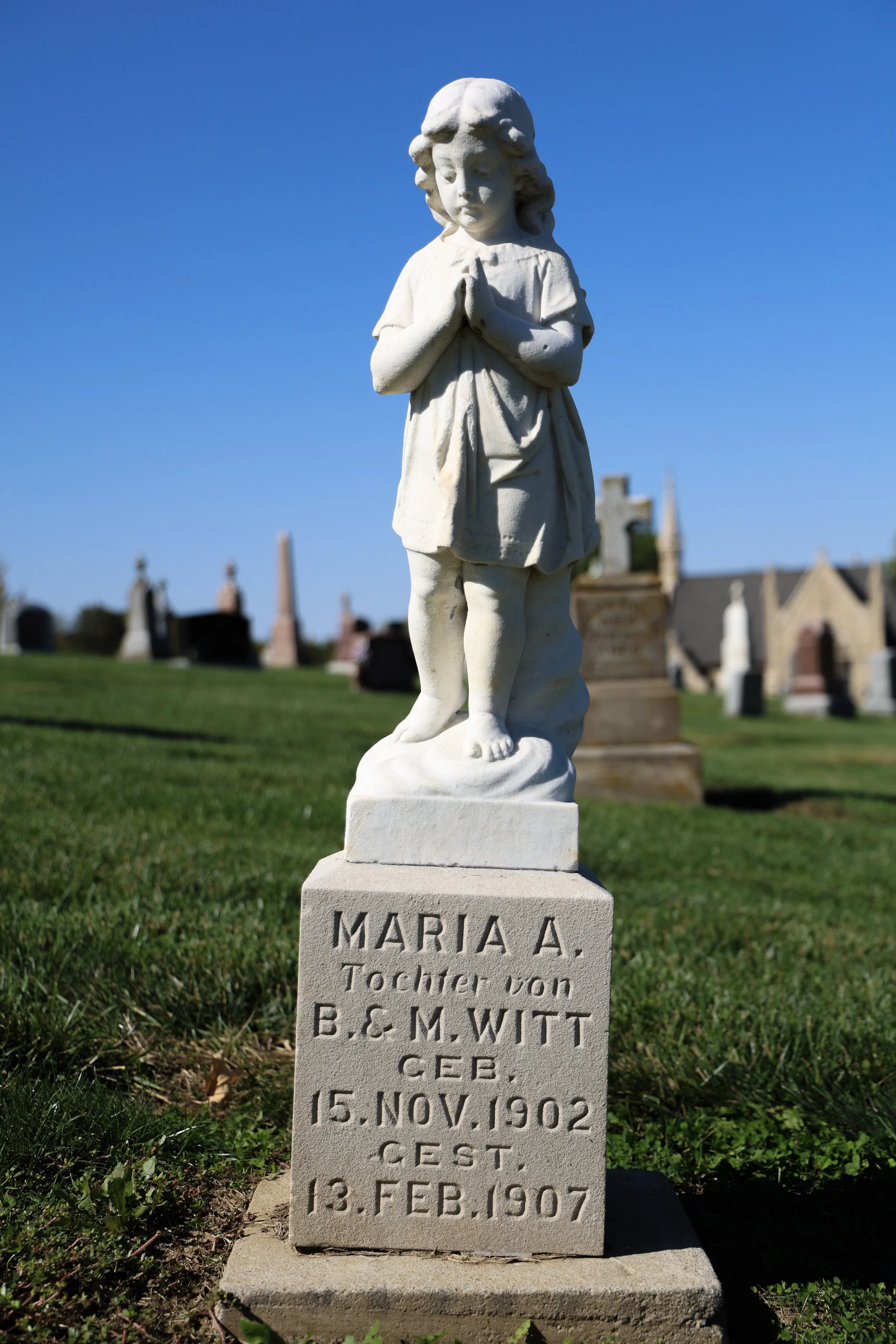
Maria Witt was only four when she died. Her German-born parents owned a bakery and confectionery in town.

Porcelain portrait of 16-year-old Rosie Angelina Dragisitz.

In 1895, "Bishop M. F. Burke of the St. Joseph diocese purchased land on Lover’s Lane for a new cemetery stating that 'the location of Calvary has never been desirable.'" Everyone buried in the former designated Catholic cemetery, Cavalry, was to be reinterred at the new cemetery of Mount Olivet. In 1905, preparations were finally made to move the remains of Joseph Robidoux (pronounced "roo-bee-doo") from the old to the new location, but there was a major problem. "After digging all day on August 13th, workers were left with more questions than answers. The metallic coffin that was described in accounts of Robidoux’s funeral in 1868 was not located ... After exhuming everyone from Robidoux’s plot and failing to locate the metal casket, exhumations were extended to neighboring plots. By the 22nd all who had been exhumed in the search for Robidoux had been moved to Mt. Olivet, but the metal casket had still not been found. No further updates were given."


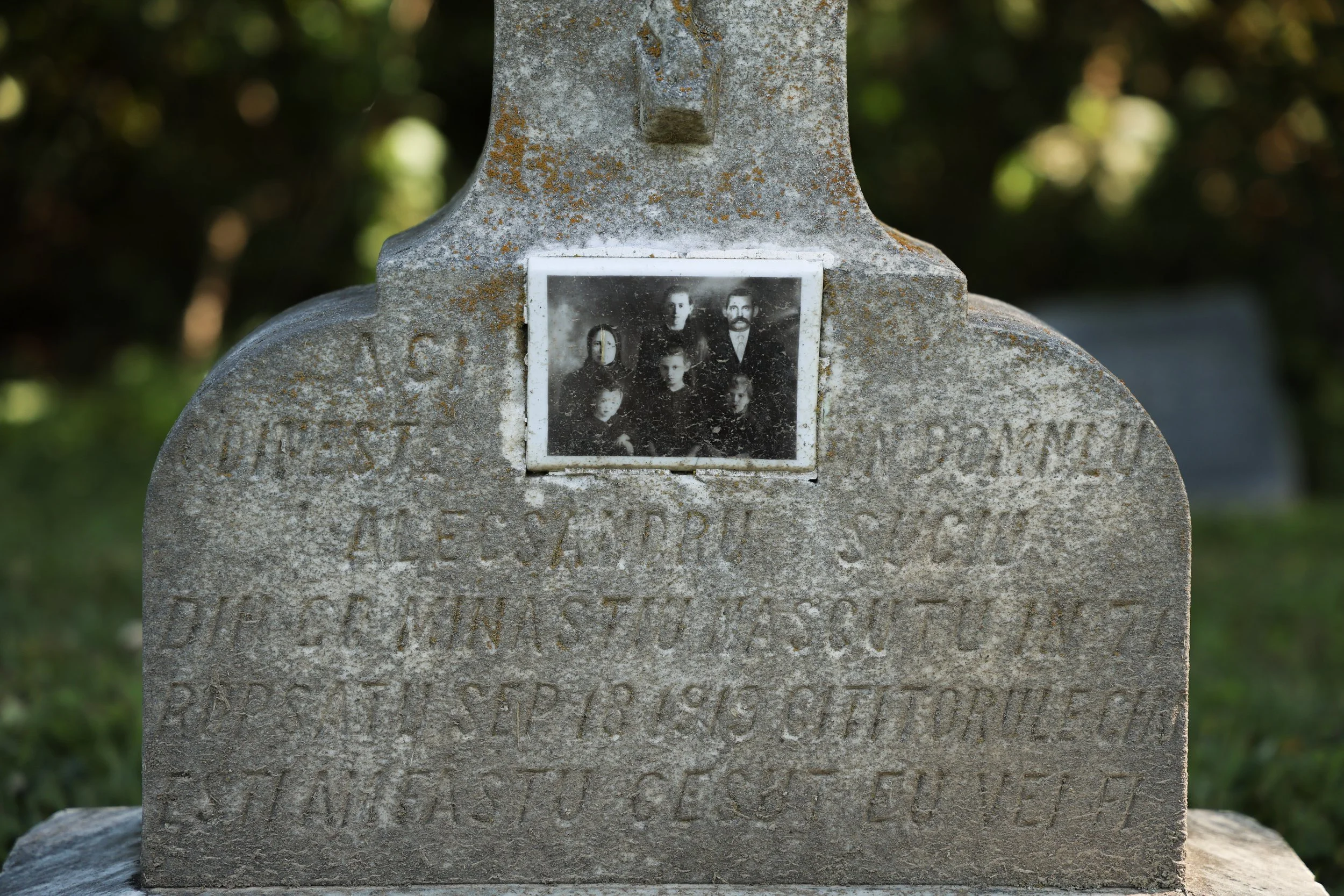
This headstone is inscribed entirely in Romanian.
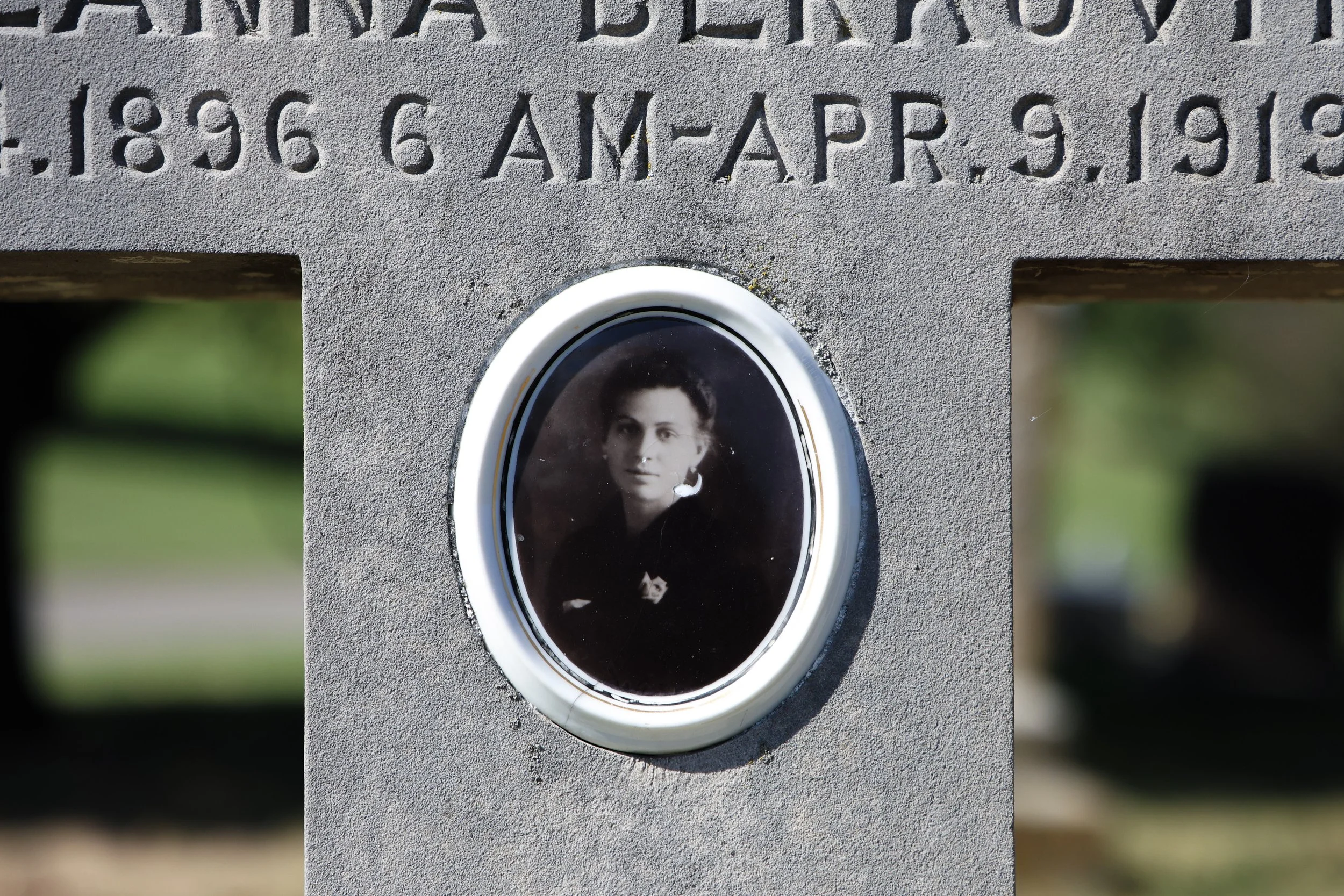
22-year-old Emma Berkovitch died at 3AM on April 9, 1919. Her mother is the only parent mentioned on her headstone.
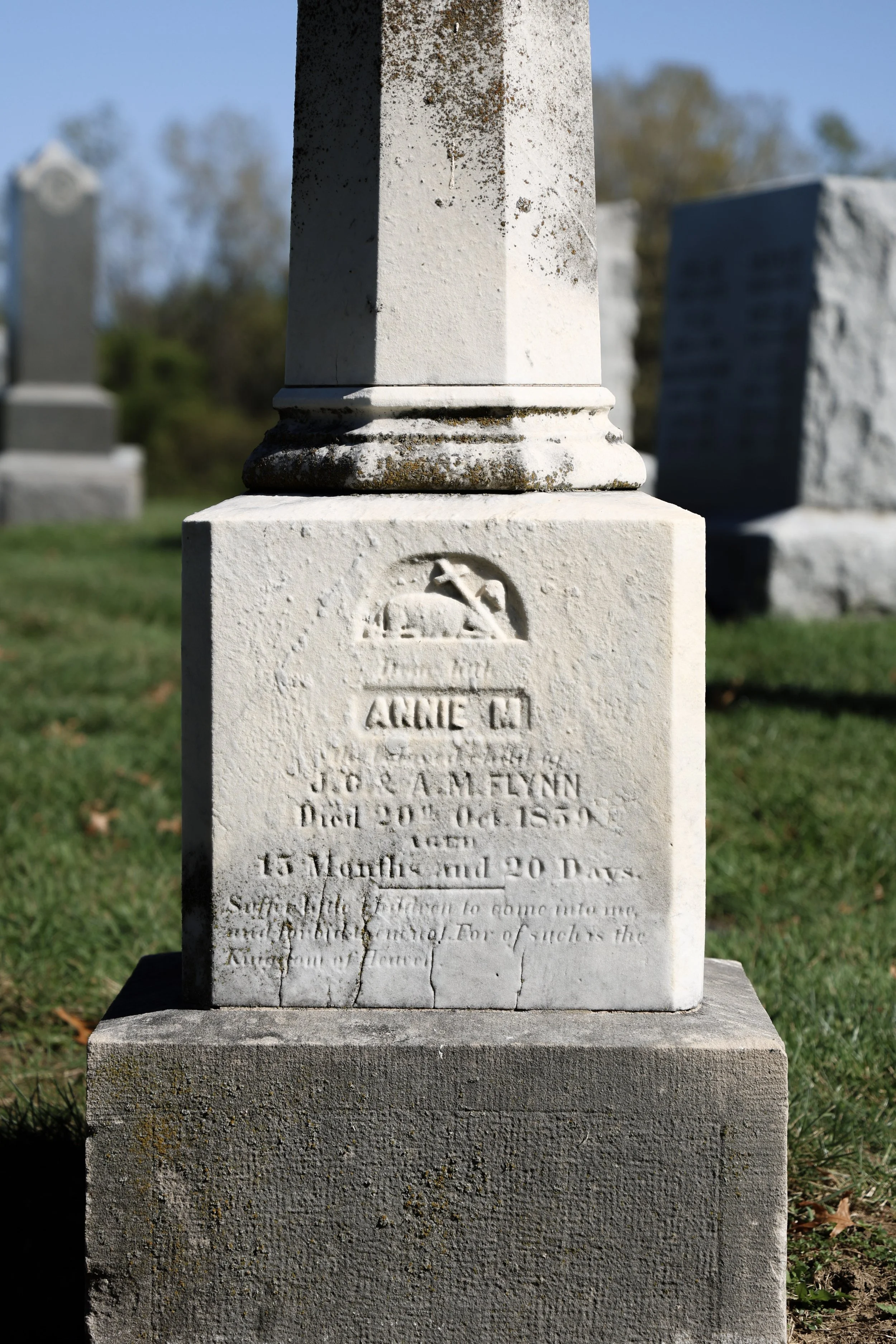
The grave of 1-year-old Annie M. Flynn. The inscription reads, "Suffer little children to come unto me, and forbid them not: for of such is the kingdom of heaven."

Frederick W. Smith coined St. Joseph, Missouri after it's founder, Joseph Robidoux (pronounced "roo-bee-doo"). He was also the one who drew the first maps of the city and was elected as the city's first postmaster. Smith would later go on to serve as a mayor and judge. He and his wife, Jane, were originally buried at Cavalry Cemetery, but were reinterred here.

Salvatore was only four when he died. His parents both immigrated from Palermo, Sicily. His father was a local fruit and candy seller.
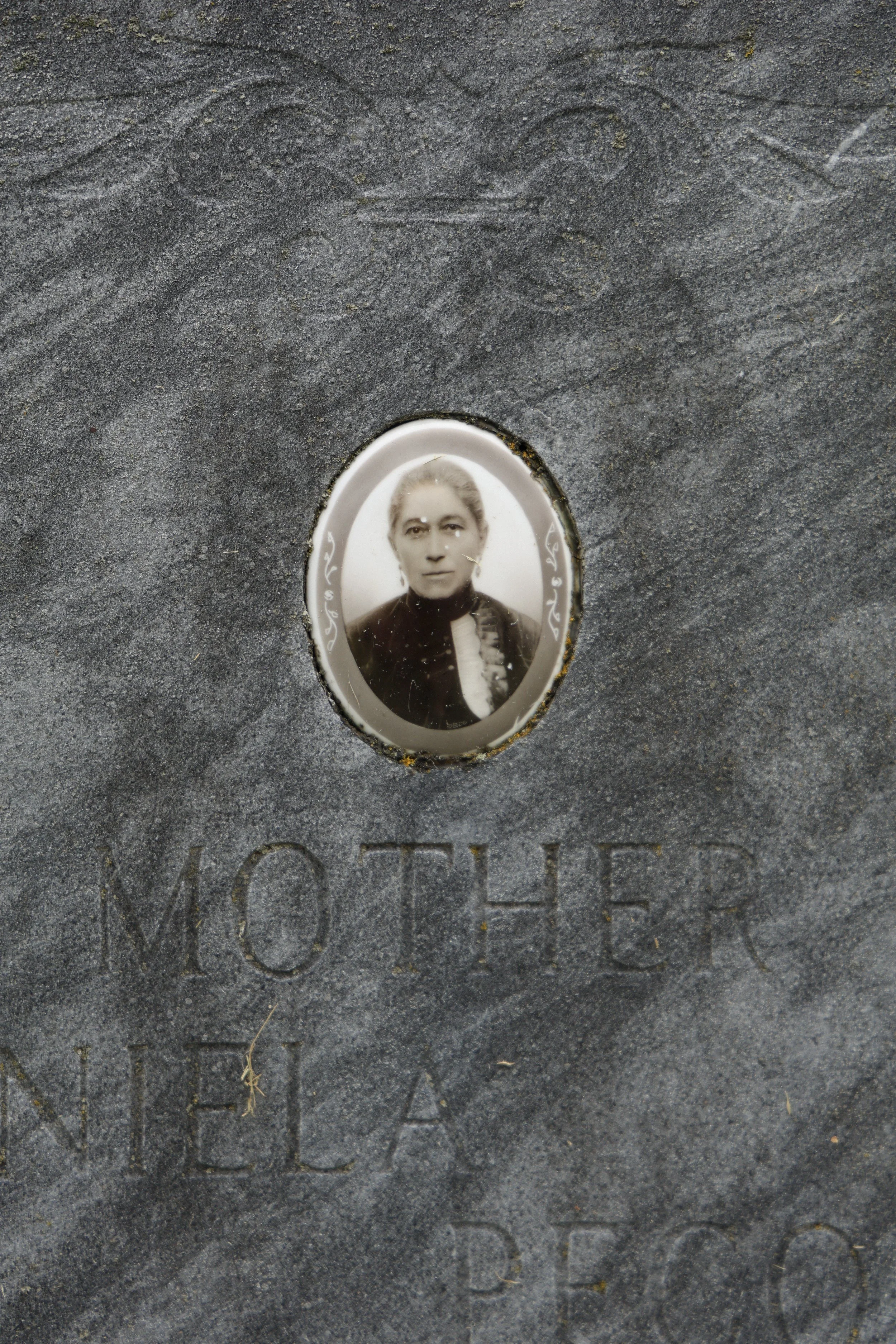

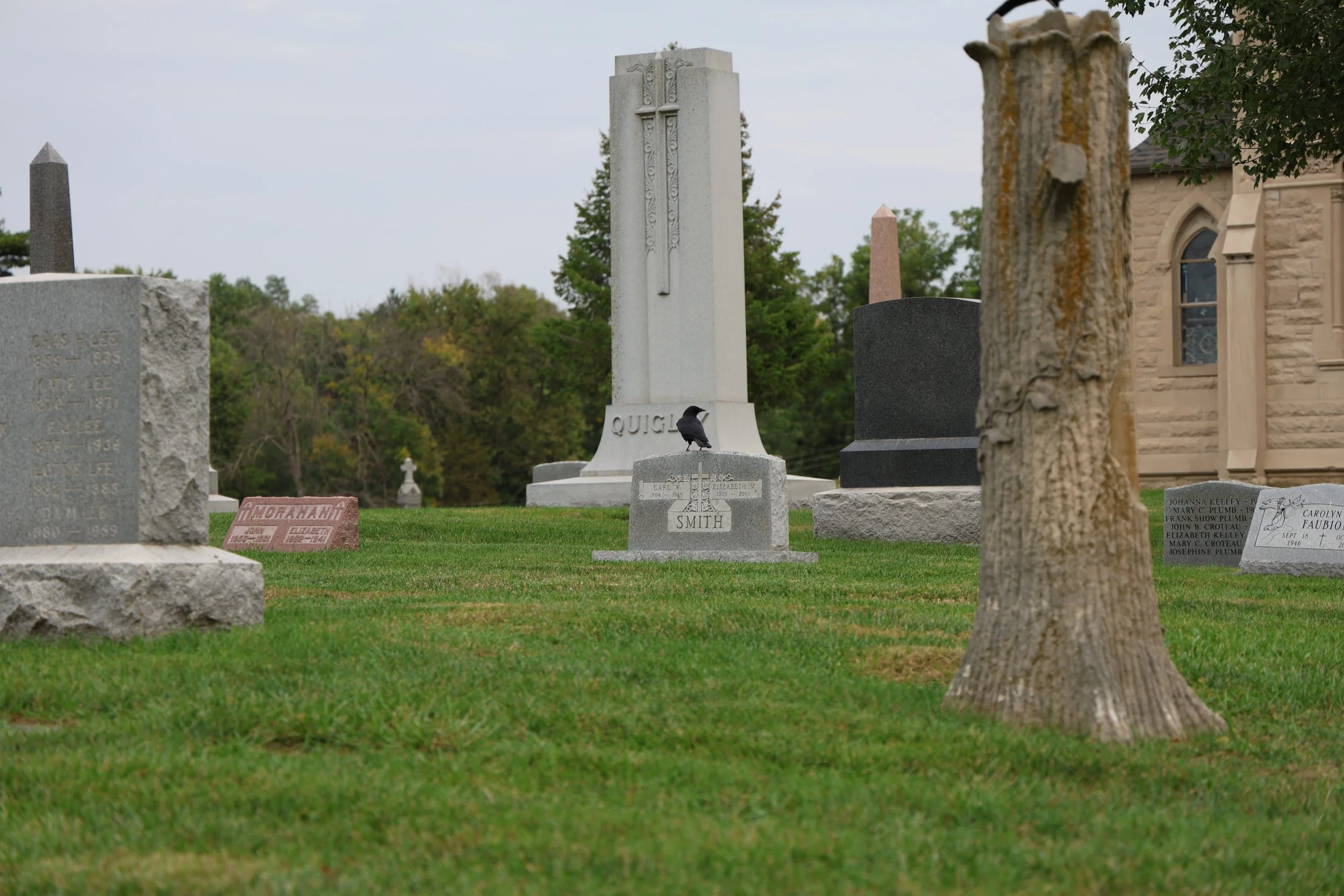
A crow perched on top of a headstone.

Patrick Harkins died when he was 7 months old. He's buried with his sisters: 15-month-old Bedelia and 4-year-old sister, Mary.

Rosina Marie Josephine Donadio died at 28. Her sister, Angelina, died from birth complications seven years before her at age 25.
MOUNT VERNON CEMETERY
ATCHISON, KANSAS
Founded in 1864, and located a few miles southwest of town, this is one of the oldest cemeteries in the northeast Kansas. It’s also the final resting place of several important figures in the state’s history, such as Amelia Earhart’s family and three Kansas governors. It also holds the key character of a local ghost story, but that comes as no surprise considering Atchison has been coined the most haunted place in the entire state of Kansas.

The headstones of Amelia Earthart's maternal grandparents. Amelia was born at her grandparents' house in Atchison that her grandfather built. It overlooks the Missouri River.


While driving a steam thresher near Lancaster, Kansas (about 11 miles west of Atchison), 28-year-old Adelbert Bucknum was crossing a bridge when the structure collapsed. Bucknam and the engine fell into the water below, the steam thresher instantly scalding and crushing him. Two men desperately attempted to free Bucknam from under the engine, but he died within 15 minutes. The vehicle depicted in the carving on the monument is the type of machinery Bucknam was operating when he died.

Charles and Eliza Jones lost one of their 4-year-old twin boys, Leon, to brain fever. The following year, Eliza died at 28. Charles remarried, but lost another son, George, from that marriage. George was five.

Both 7-year-old Mabel Styles and her mother, Mary, died on December 29, 1883.

Grace Otis died at a year old with her younger brother, Harrison, dying a few years later at six months. Their father was a judge and the grandfather of Amelia Earhart. Despite being babies, this technically makes Grace and Harrison the aunt and uncle of Amelia Earhart.



20-year-old Josephine Clites died during the birth of her son, James, who ended up dying three months later.

In addition to losing their son, Adelbert, in a steam engine accident, Mr. and Mrs. Bucknam lost 8 other children prior: an 11-day-old infant son, 4-month-old Francis, 5-month-old Bertha, 5-month-old Ella, 5-month-old Arabel, 6-month-old Cora, 8-month-old Nelly and 14-month-old Idia.
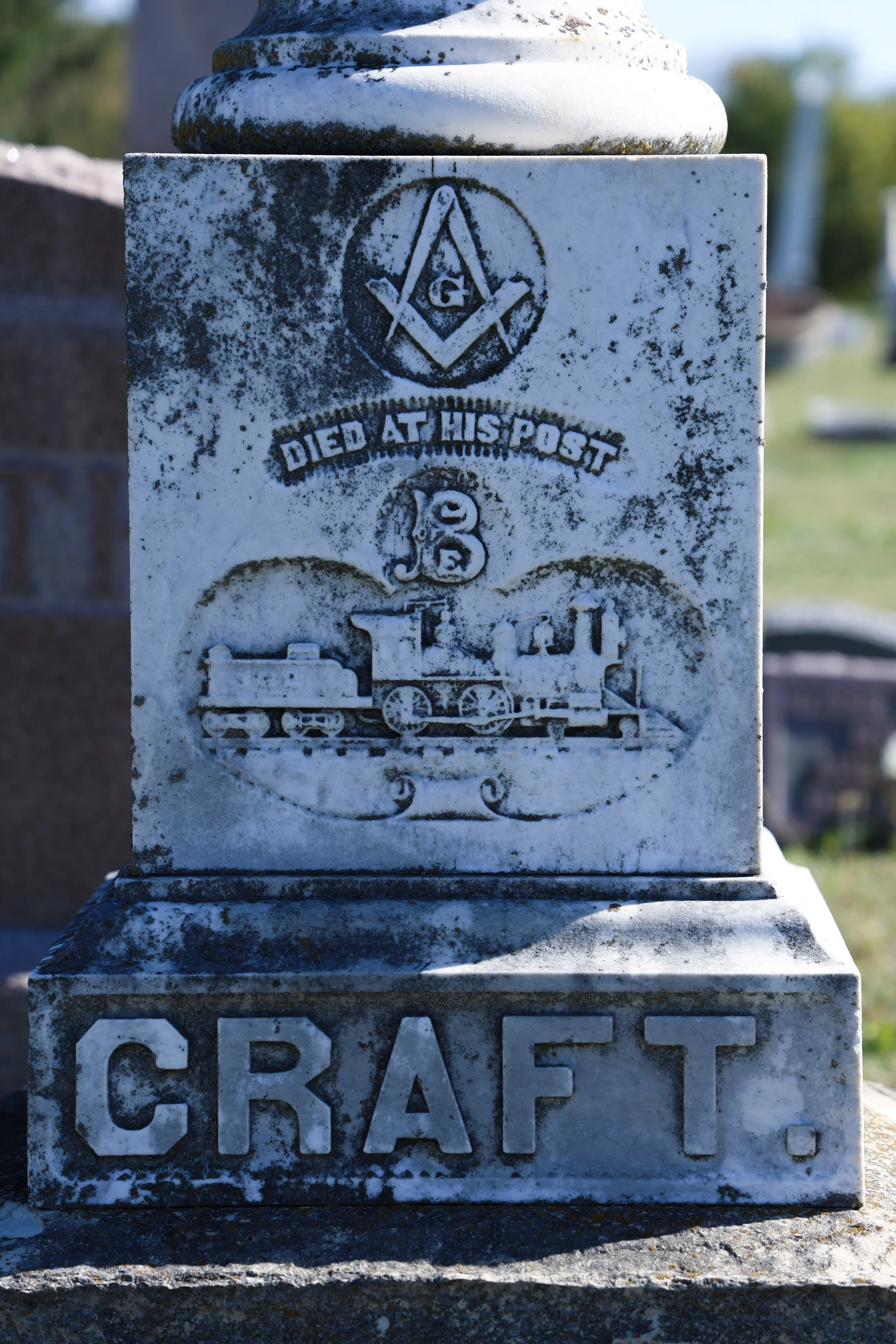
Brition "Brit" Craft was driving a passenger locomotive on the morning of August 3, 1882, when he began making a blind turn— revealing a burning bridge in front of him. He tried to stop the train, but there wasn't enough time. Both the engine and mail car fell forward into the creek below. Craft and the fireman died with a handful of railway postal workers injured. Thankfully, all passenger coaches remained on the track. Craft was 34. Within the month, there was already paranormal activity occurring at the site of the crash. A fellow freight engineer witnessed a phantom train approaching him, "Brit Craft was leaning out of the cab window looking ahead. The fireman was engaged in throwing in coal, and he noticed this because he saw him through the boiler head and steam dome." Even as time passed into the new year, the ghost train was still being spotted by locals, "... There is a story among the men that its ghost still makes trips just before the break of day. Several have seen it, a locomotive etched in white lines on the darkness, near where the dreadful accident occurred ... On Sunday night, however, the spectre is said to have been seen at three different places ... and before day the next morning ..."

Katharine Mathilda Stephan was 23 years old when she passed.
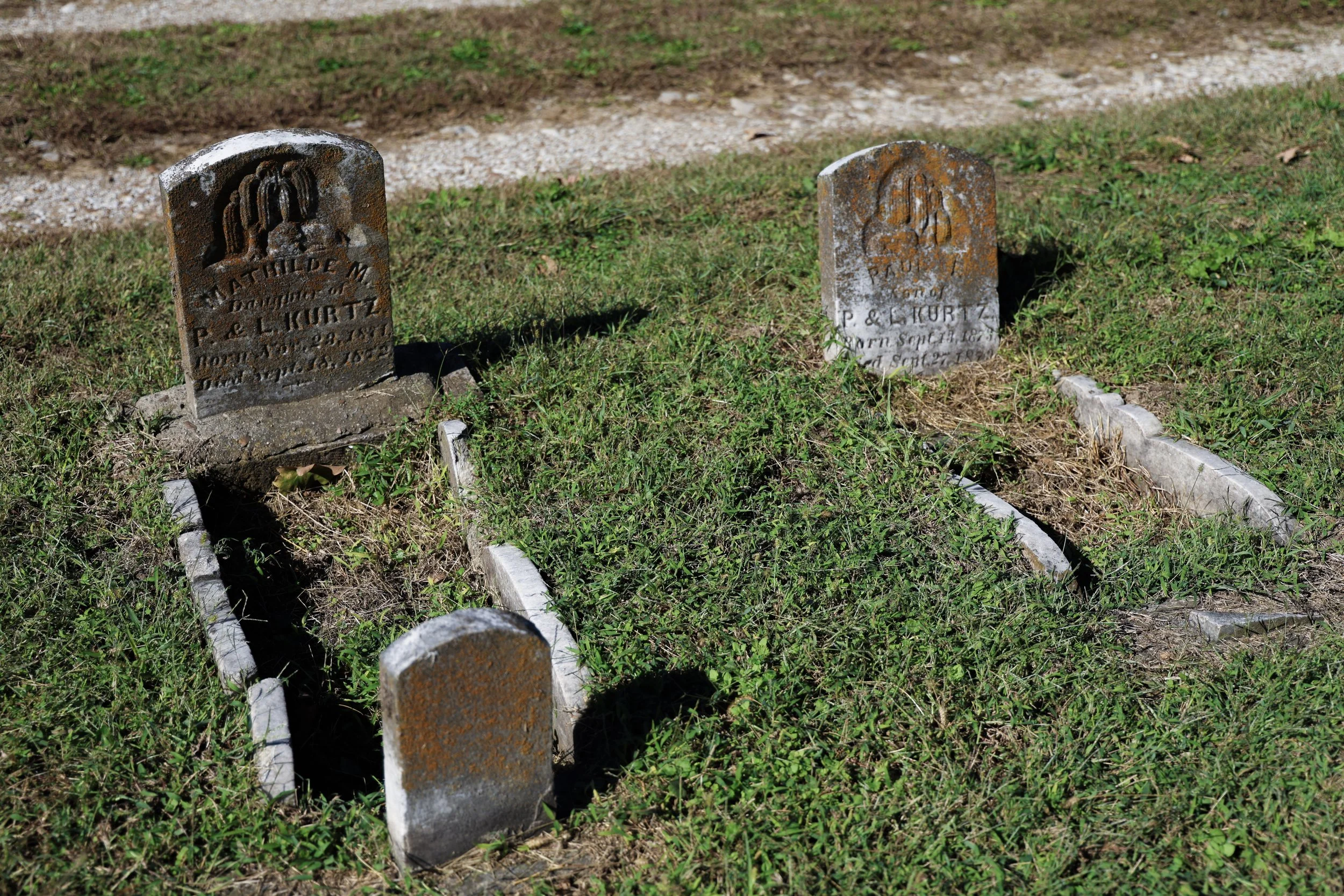
Mathilde Kurtz died a few months before her first birthday. A year later, her brother, Paul, died at 14 days old.

7-year-old Edward Overton "Ned" Rigg died from consumption of the lungs. His parents had this headstone carved to his likeness. Visitors to his grave have left stones and coins tucked between his shoes.

Grave of mother and son. Theodore died at 54, and about six months later, his mother, Christine, died at 76.

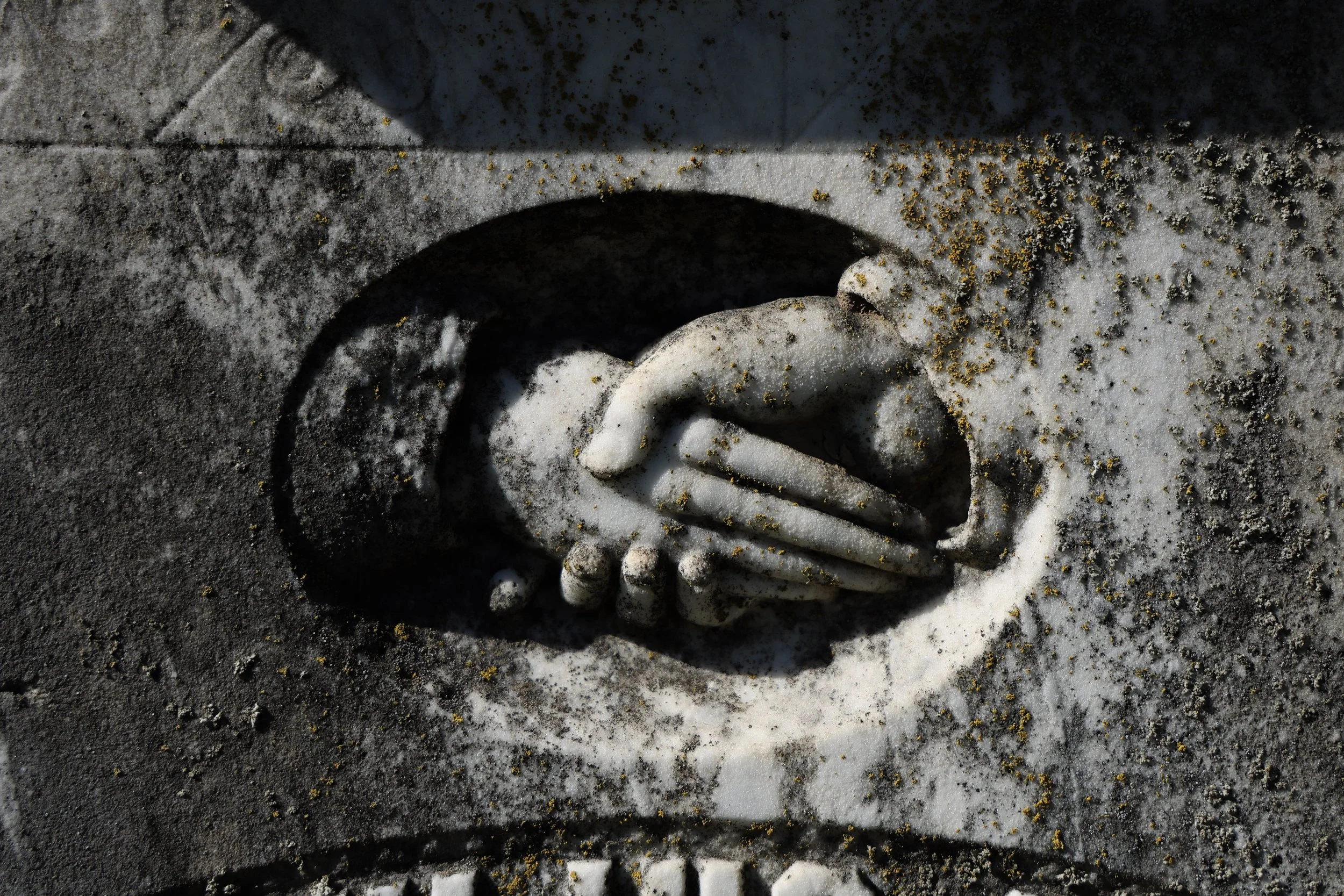
When German farmer Julius Carl Peuker died at the age of 31, he left behind a wife and five children.

25-year-old Frank Firth died in a train accident.


Broken and sinking headstone of 17-year-old Eliza Newton. The headstones of her two younger brothers have also been broken.

Headstone of 50-year-old Civil War Union colonel, commander and provost, John Alexander Martin. He served as the governor of Kansas from 1885 to 1989. His headstone was intentionally made half complete to reflect how Martin's life was cut short.


20-year-old Martha Alice Perdue was only married for two years when she died. You can see how far the headstone had sunk into the ground before being corrected. Her sister, Clara, died from consumption three years after her at the age of 25.

x

The headstone of 19-year-old Harriet Norris had been snapped in half, but has since been beautifully repaired.
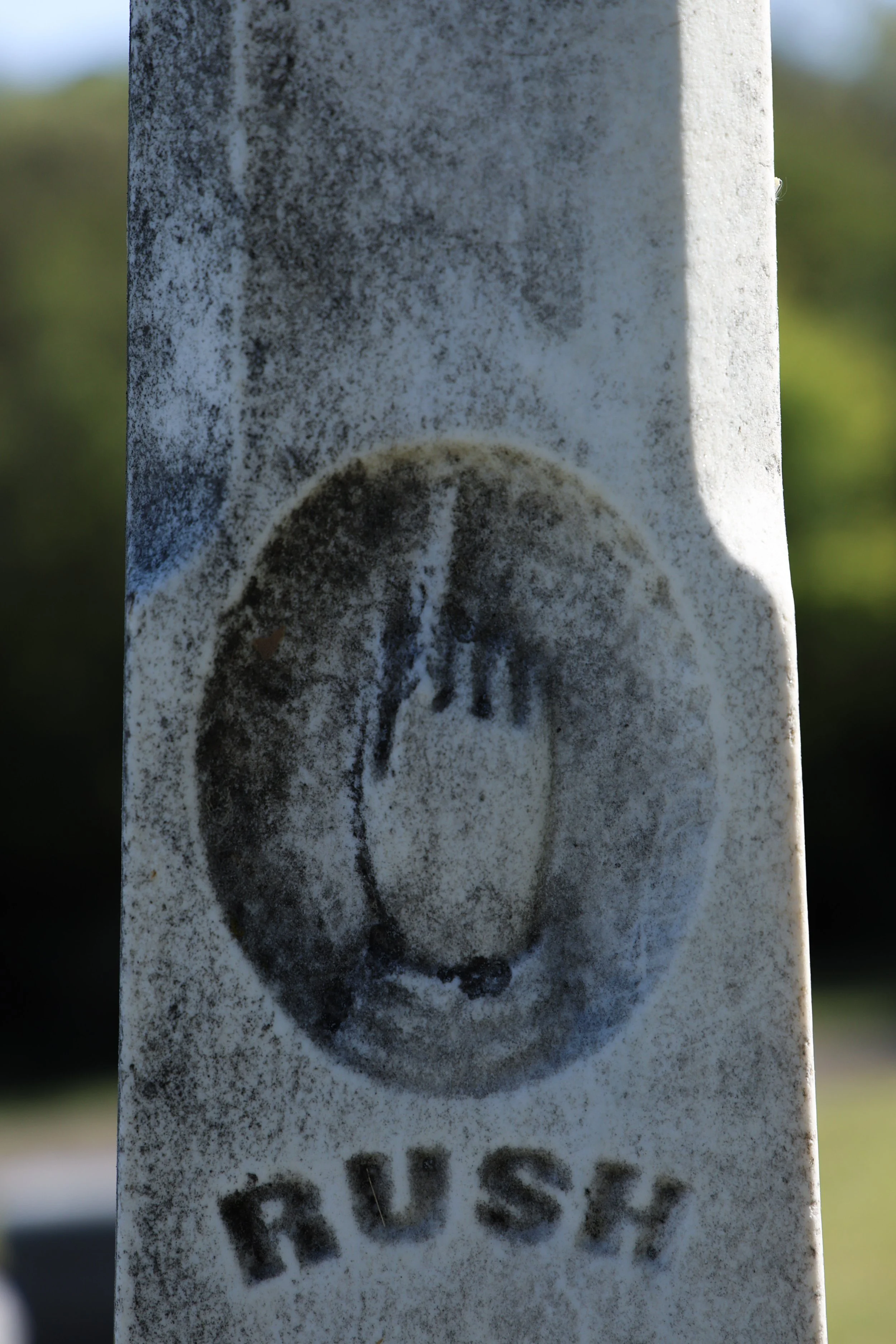

Two engraved lambs sleep on the headstone of two infant sisters.

19-year-old Simon Galbraith intentionally drank arsenic in at act of suicide.
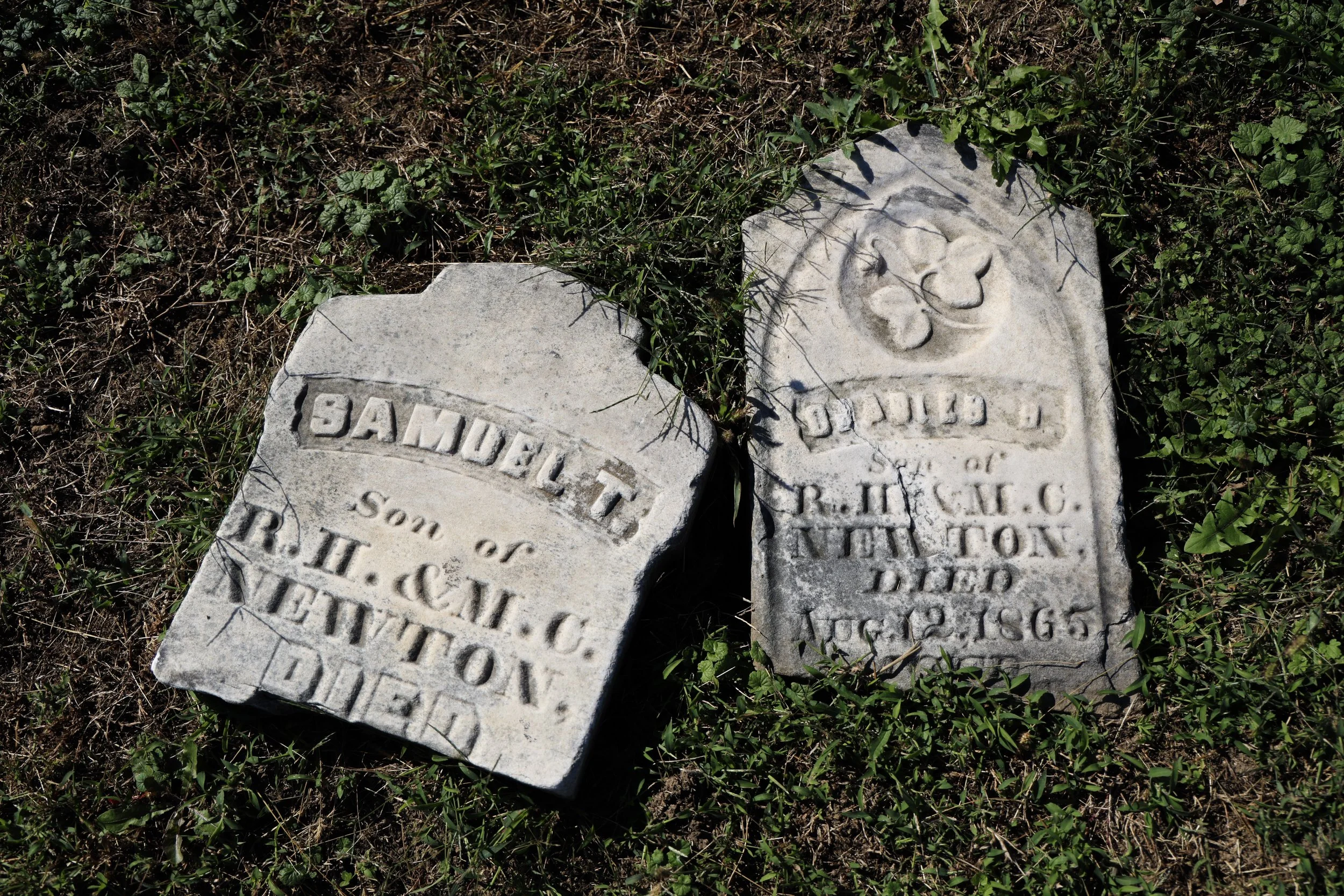
Damaged headstones of two brothers, Samuel and 11-year-old Charles Newton. Because of where Samuel's headstone broke off, his age has been lost. The headstone of their older sister, Eliza, has also been broken and knocked to the ground.
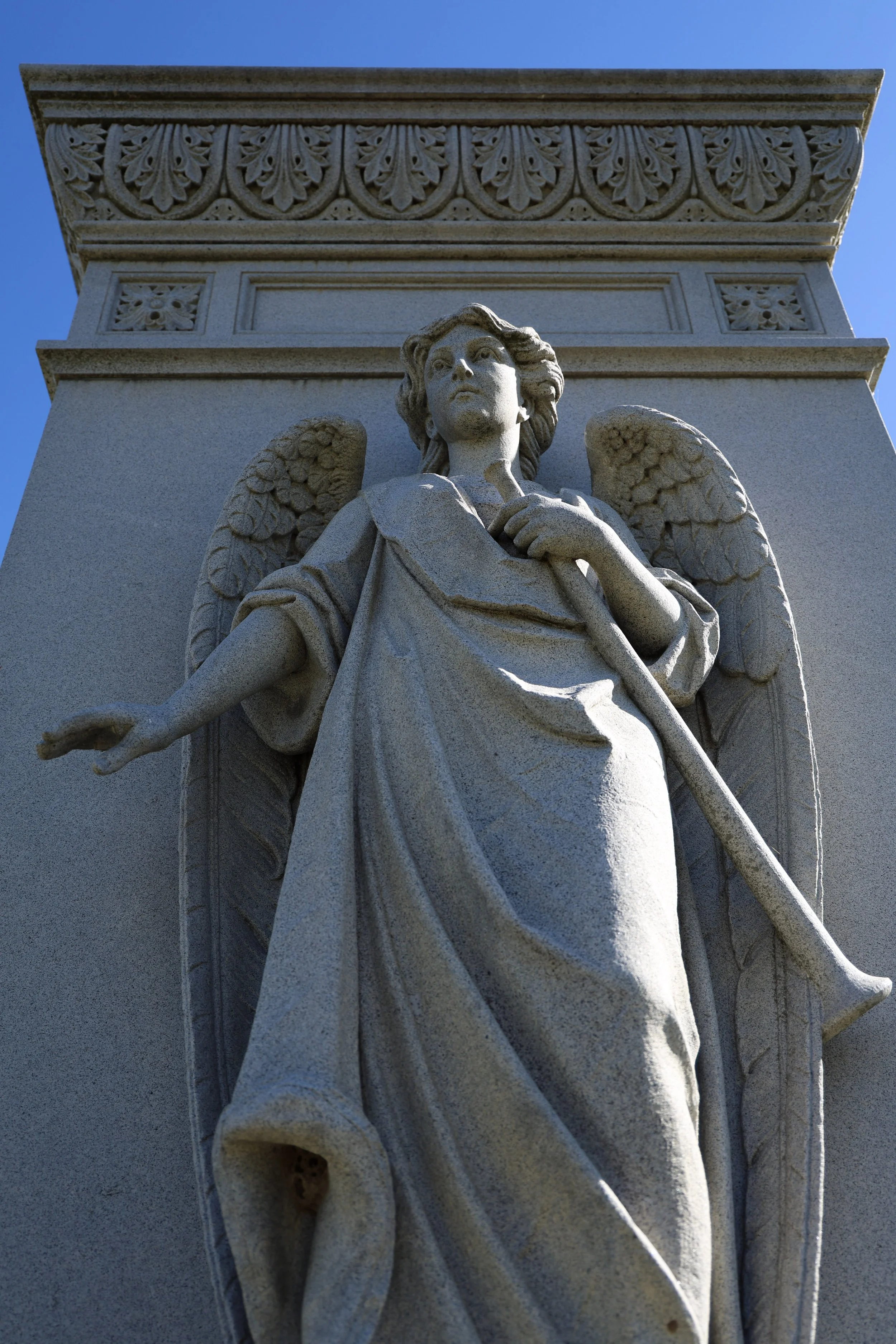


The vandalized headstone of Jacob Saqui. Ironically, he helped found Mount Vernon Cemetery.

"Dearest Children do not weep; I am not dead but only sleep."

On June 7, 1896, William "Willie" Compton was in a boat sailing on Missouri River attempting to catch floating driftwood with a pole when he lost his balance and fell into the water. He never resurfaced. He was 15.
BOOTHILL GRAVEYARD
TOMBSTONE, ARIZONA
Between 1881 and 1906, a horse-drawn hearse nicknamed the Black Mariah (spelling of “Mariah” varies) was the sole transportation of the town’s deceased out to Boothill Graveyard. As the legend has it, there was so much death in Tombstone in its heyday that the Black Mariah “had a cowboy for breakfast every morning.”


George Johnson unintentionally bought a stolen horse and paid the consequences. The bottom of the headstone reads, "He was right, we was wrong, but we strung him up and now he's gone."

In the winter of 1883, John Heath, a local saloon keeper, helped plan the robbery of money belonging to the Copper Queen mine in Bisbee, Arizona (approximately 20 miles southwest of Tombstone). The robbery was a success, but four people were killed in the gunfire, including a woman, which became known as The Bisbee Massacre. When an angry posse went after the thieves, Heath led them on a false trail, exposing his connection to the scheme. All were captured and jailed, including Heath. While the others were put to death for their crimes, Heath only received a long prison sentence. February 22, 1884, upon hearing the news, a mob took over the jail, dragged Heath outside and hung him on a telegraph pole. He was 32 years old.

3-month-old Eva Waters died of scarlet fever in 1878. She is considered to be the first person ever buried in the Boothill Graveyard. Visitors of the cemetery often leave flowers, coins and small toys on her grave.

On October 26, 1881, a 30-second gunfight between cowboys and lawmen would put an end to the Wild West as we know it. These are the graves of outlaws Billy Clanton and the McLaury brothers. They were shot behind the O.K. Corral by Wyatt Earp, his brother, Morgan Earp, and Doc Holliday. Frank McLaury was either 32 or 33, his brother Tom, 28, and Billy Clanton either 18 or 19. This story inspired Tombstone (1993) starring Kurt Russell, Val Kilmer, Sam Elliott and Bill Paxton.

Inscription reads, "The Unknown."

Headstone named as, "Unknown."

Delia Williams ingested arsenic after losing all her savings in a catastrophic fire that she'd intended to use to start up a restaurant.

The placing of large rocks over interred bodies was a way of deterring wild animals and grave robbers from disturbing the dead.

Lester Moore worked at the Wells Fargo office in Naco, Arizona. When Hank Dustan came to pick up a package, Dustan became enraged by the poor quality it had been delivered in. The two men argued and both drew their guns. Moore was shot four times by Dustan, with Dustan being shot once in the chest by Moore. Both men died. This gunfight would inspire Johnny Cash to write the song "The Ballad of Boothill" which shares the same lyrics as the inscription on Moore's headstone, "Here lies less more; Four slugs from a forty-four; No less no more."


The grave of two unknown Chinese. It is suspected they both died of leprosy.

Wild cactus growing freely within the cemetery.

A rose, coins and a My Little Pony figurine left at the grave of 3-month-old Eva Waters.

The Black Mariah was built in New York and shipped to Watt & Tarbell Undertakers in Tombstone. Painted black with silver and gold trimming, the hearse is said to have "had a cowboy for breakfast every morning." This is the Black Mariah on display inside the Bird Cage Theater in Tombstone. This hearse more than likely carried everyone belonging to every headstone seen in Boothill Graveyard.







